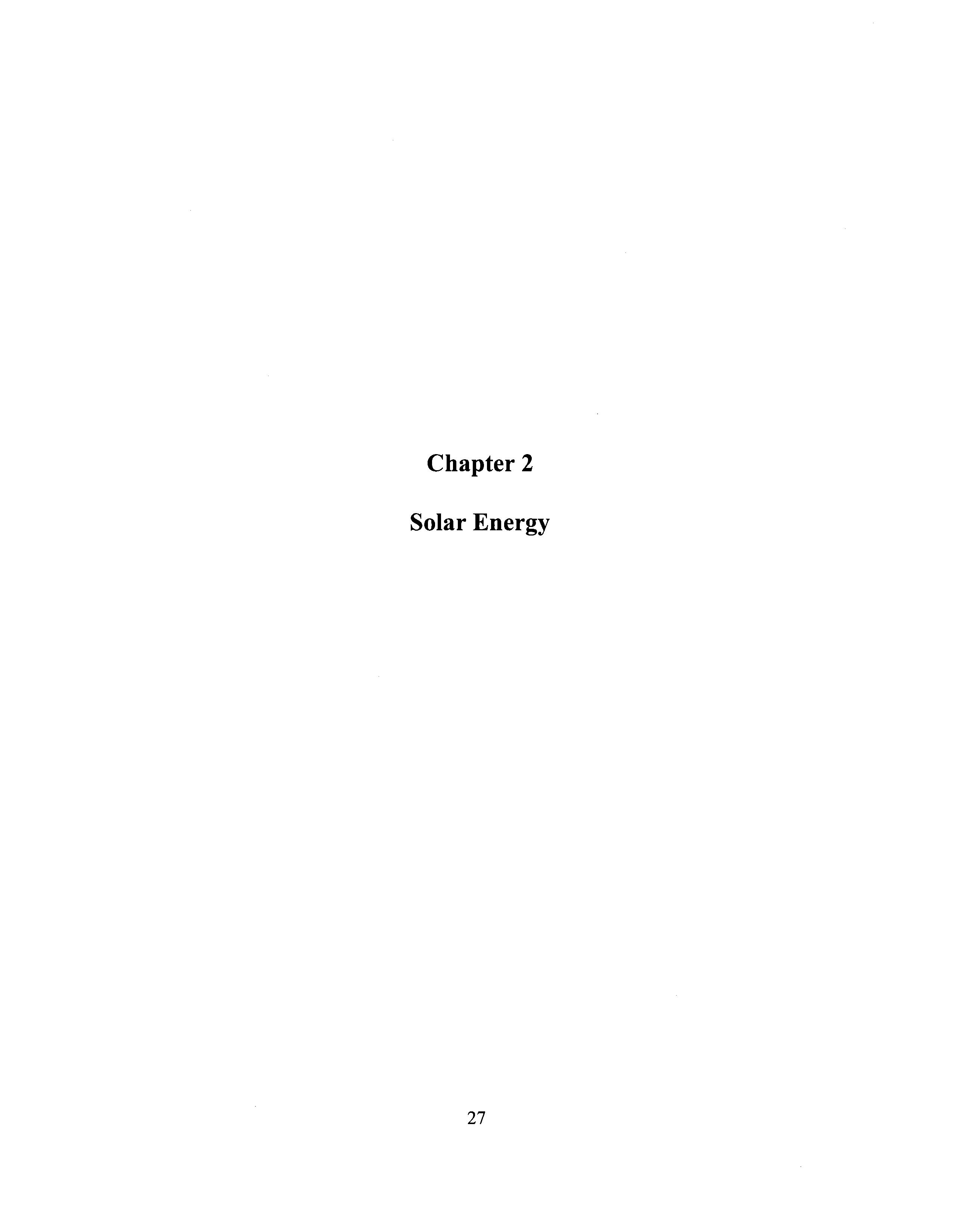

Chapter 2 Solar Energy
Section 2.2 Practice!
1. Find the declination angle and apparent solar time for Richmond, Virginia, longitude 77.4 7 o, latitude 37.53 o, on September 21 at 2:00pm.
Solution
8 = 23.45° sin[ N + 284 x 360°] 365
= 23.45°sin[(264 + 284)/365 x 360°]
= -0.202°
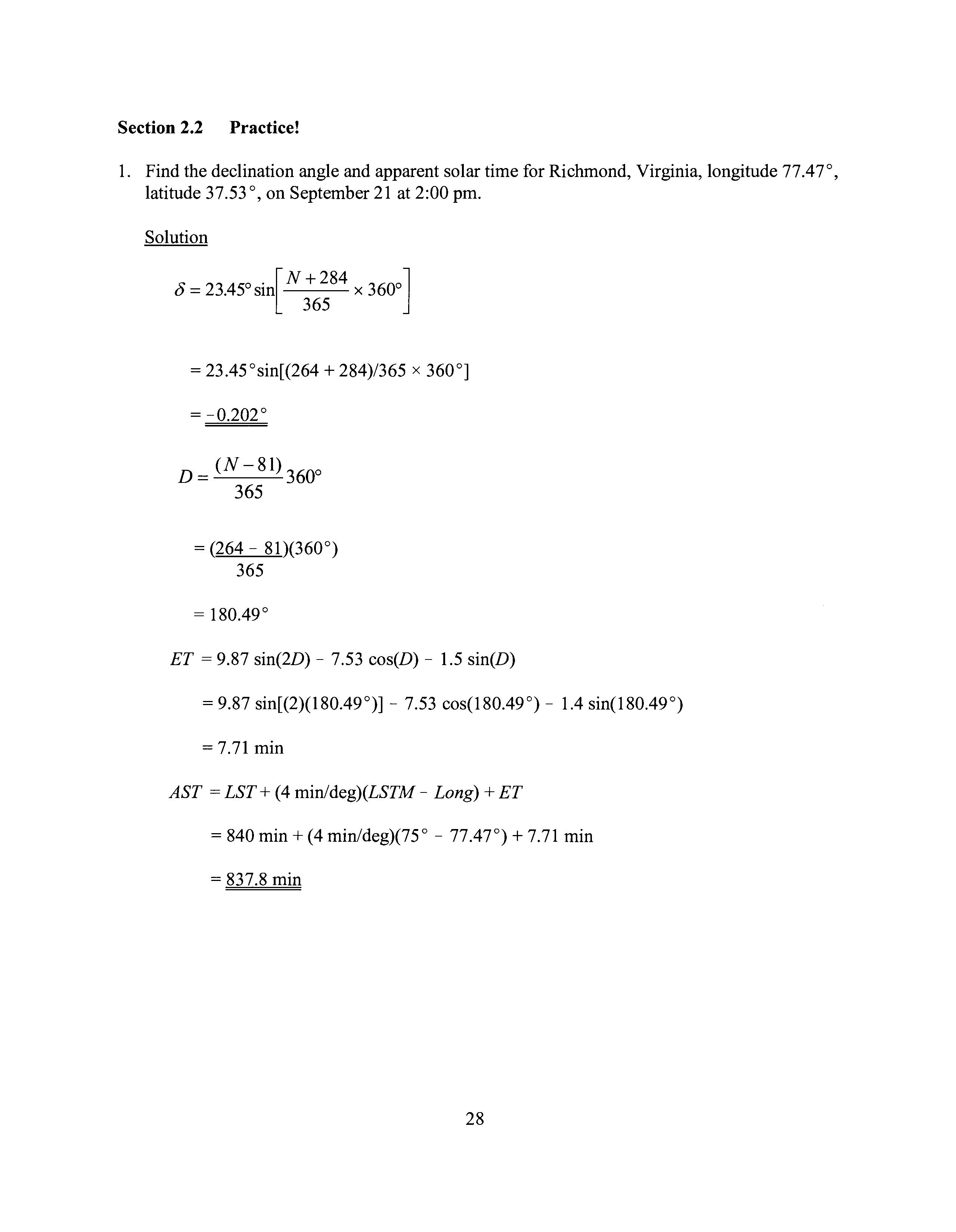
D = (N -81) 360o 365 = (264- 81)(360°) 365
= 180.49°
ET = 9.87 sin(2D)- 7.53 cos(D)- 1.5 sin(D)
= 9.87 sin[(2)(180.49°)]- 7.53 cos(180.49°)- 1.4 sin(180.49°)
= 7.71 min
AST = LST + (4 minldeg)(LSTM- Long) + ET
= 840 min+ (4 min/deg)(75o - 77.4r) + 7.71 min
= 837.8 min
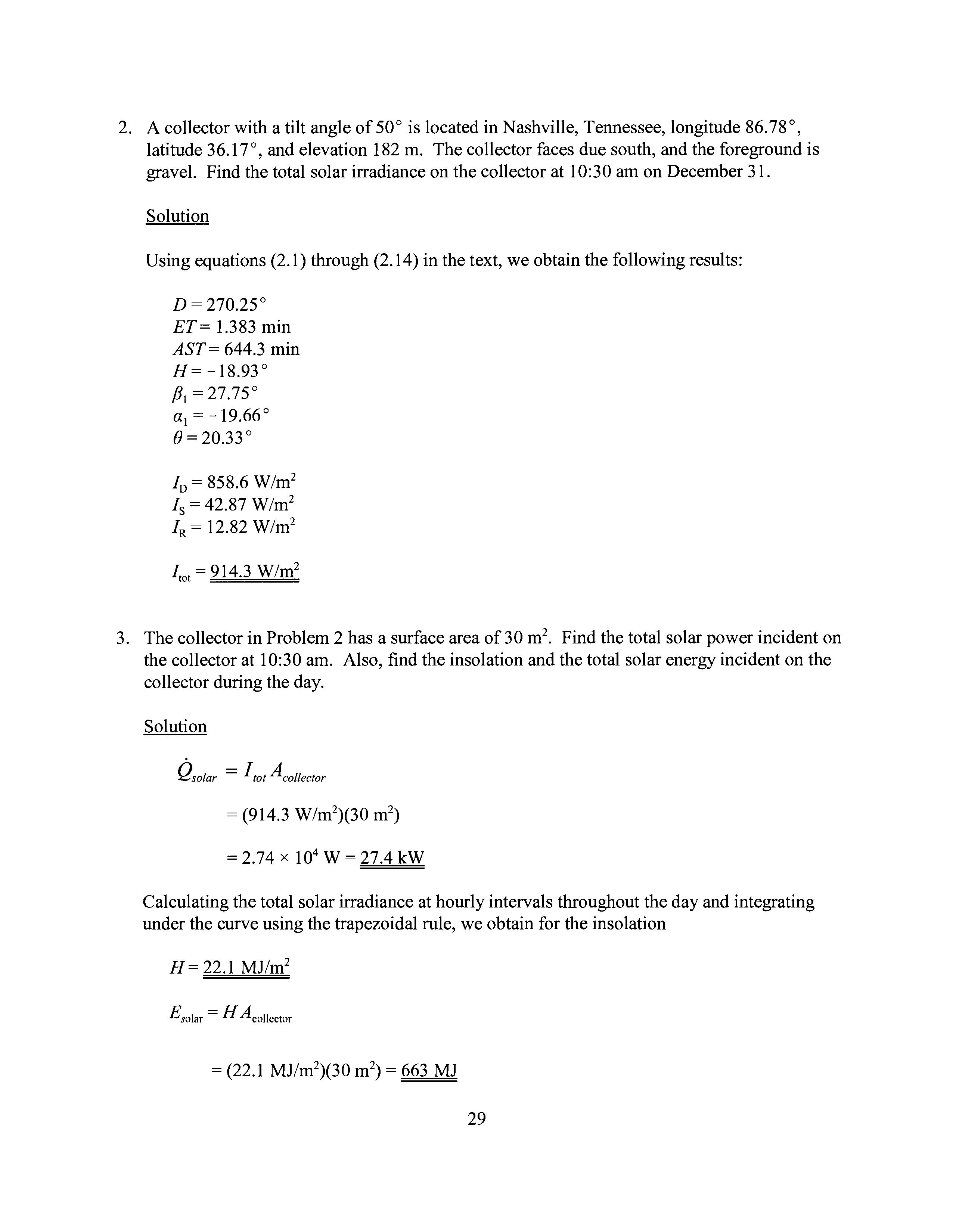
2. A collector with a tilt angle of 50° is located in Nashville, Tennessee, longitude 86.78 o, latitude 36.17 o, and elevation 182 m. The collector faces due south, and the foreground is gravel. Find the total solar irradiance on the collector at 10:30 am on December 31.
Solution
Using equations (2.1) through (2.14) in the text, we obtain the following results:
D = 270.25°
ET= 1.383 min
AST= 644.3 min
H= -18.93°
/J1 =27.75°
a 1 = -19.66°
e = 20.33 o
In= 858.6 W/m 2
Is= 42.87 W/m2
/R = 12.82 W/m 2
!tot= 914.3 W/m2
3. The collector in Problem 2 has a surface area of30 m 2 • Find the total solar power incident on the collector at 10:30 am. Also, find the insolation and the total solar energy incident on the collector during the day.
Solution
Qsolar = ]tot Acollector = 2.74 X 104 w = 27.4 kW
Calculating the total solar irradiance at hourly intervals throughout the day and integrating under the curve using the trapezoidal rule, we obtain for the insolation
H = 22.1 MJ/m2
Esolar = H Acollector
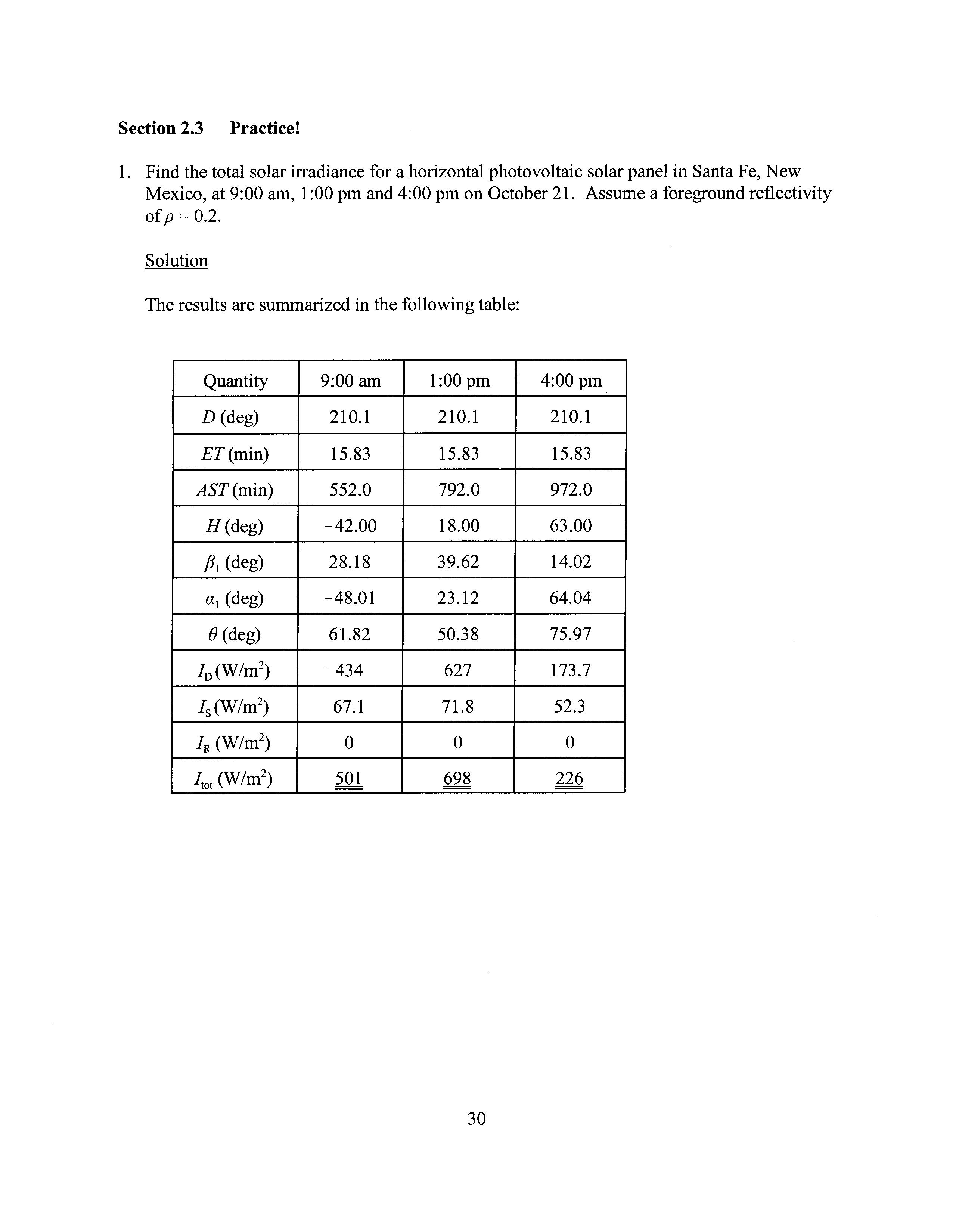
Section 2.3 Practice!
1. Find the total solar irradiance for a horizontal photovoltaic solar panel in Santa Fe, New Mexico, at 9:00 am, 1:00pm and 4:00pm on October 21. Assume a foreground reflectivity ofp = 0.2.
Solution
The results are summarized in the following table:
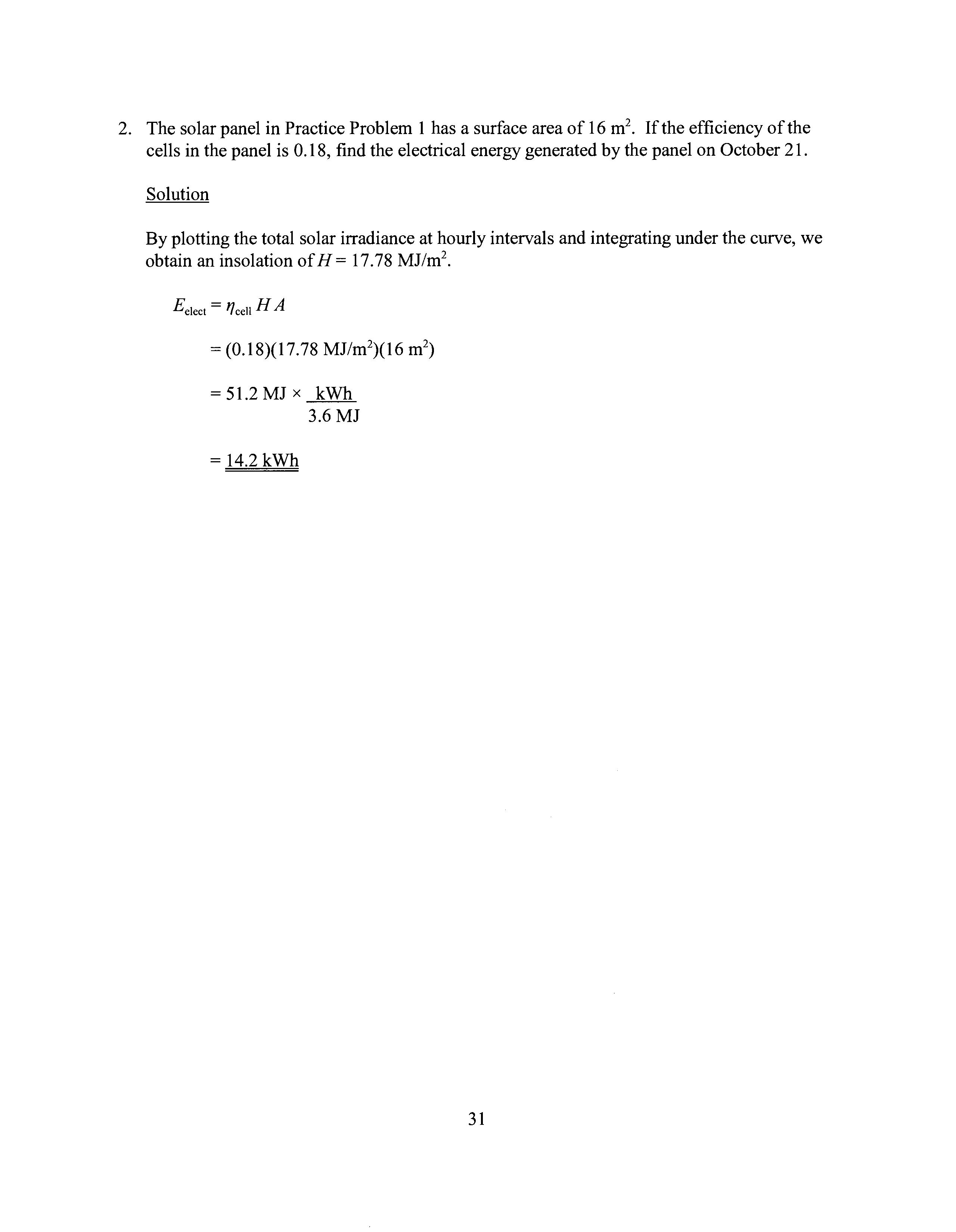
2. The solar panel in Practice Problem 1 has a surface area of 16 m 2 • If the efficiency of the cells in the panel is 0.18, find the electrical energy generated by the panel on October 21.
Solution
By plotting the total solar irradiance at hourly intervals and integrating under the curve, we obtain an insolation of H = 17.78 MJ/m2 •
£elect= '1cell H A = 51.2 MJ X kWh 3.6MJ = 14.2 kWh
3. Find the optimum tilt angle for a photovoltaic solar panel in Pittsburgh, Pennsylvania, on December 21. Also, find the insolation corresponding to this tilt angle. The panel faces due south, and the foreground is covered with snow.
Solution
· By plotting the insolation as a function of panel tilt angle (see the graph below), we see that the optimum tilt angle is
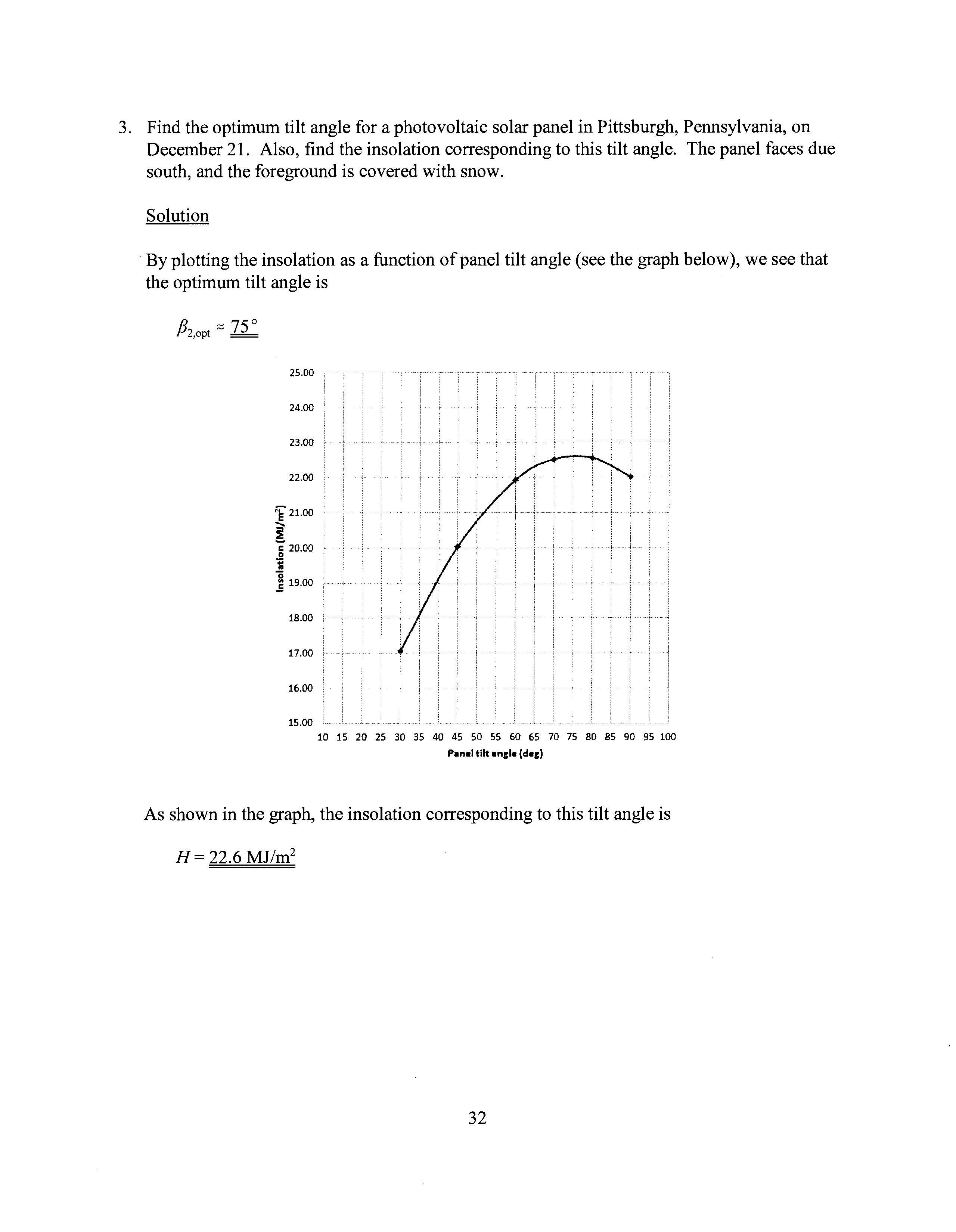
As shown in the graph, the insolation corresponding to this tilt angle is H = 22.6 MJ/m2
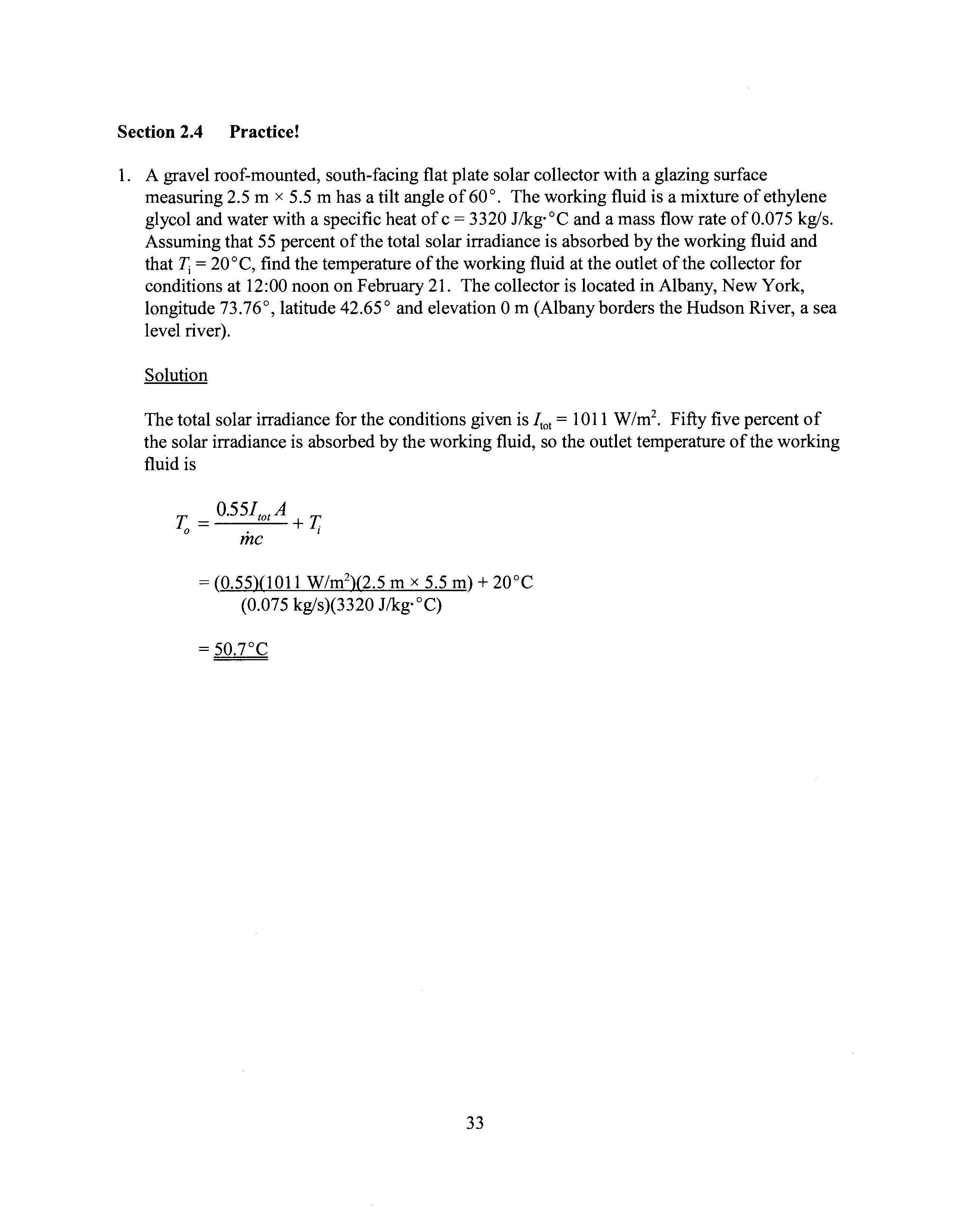
Section 2.4 Practice!
1. A gravel roof-mounted, south-facing flat plate solar collector with a glazing surface measuring 2.5 m x 5.5 m has a tilt angle of 60 o. The working fluid is a mixture of ethylene glycol and water with a specific heat of c = 3320 Jlkg·oC and a mass flow rate of0.075 kgls. Assuming that 55 percent of the total solar irradiance is absorbed by the working fluid and that T. = 20°C, find the temperature of the working fluid at the outlet of the collector for conditions at 12:00 noon on February 21. The collector is located in Albany, New York, longitude 73.76°, latitude 42.65° and elevation 0 m (Albany borders the Hudson River, a sea level river).
Solution
The total solar irradiance for the conditions given is /tot= 1011 W/m2 • Fifty five percent of the solar irradiance is absorbed by the working fluid, so the outlet temperature of the working fluid is T = 0.55/tot A T 0 • + l me = (0.55)(1011 W/m2 ){2.5 m x 5.5 m) + 20°C (0.075 kg/s)(3320 J/kg·°C)
= 5o.rc
2. The aperture diameter of a dish concentrator is 1.9 m, and the concentration ratio is 1000. The temperature of the working fluid in the receiver is 1250°C, and the temperature of the surroundings is 25°C. If the direct solar irradiance on the dish is 680 W/m 2 , find the solar power incident on the concentrator, the heat flux at the receiver and the Camot efficiency.
Solution
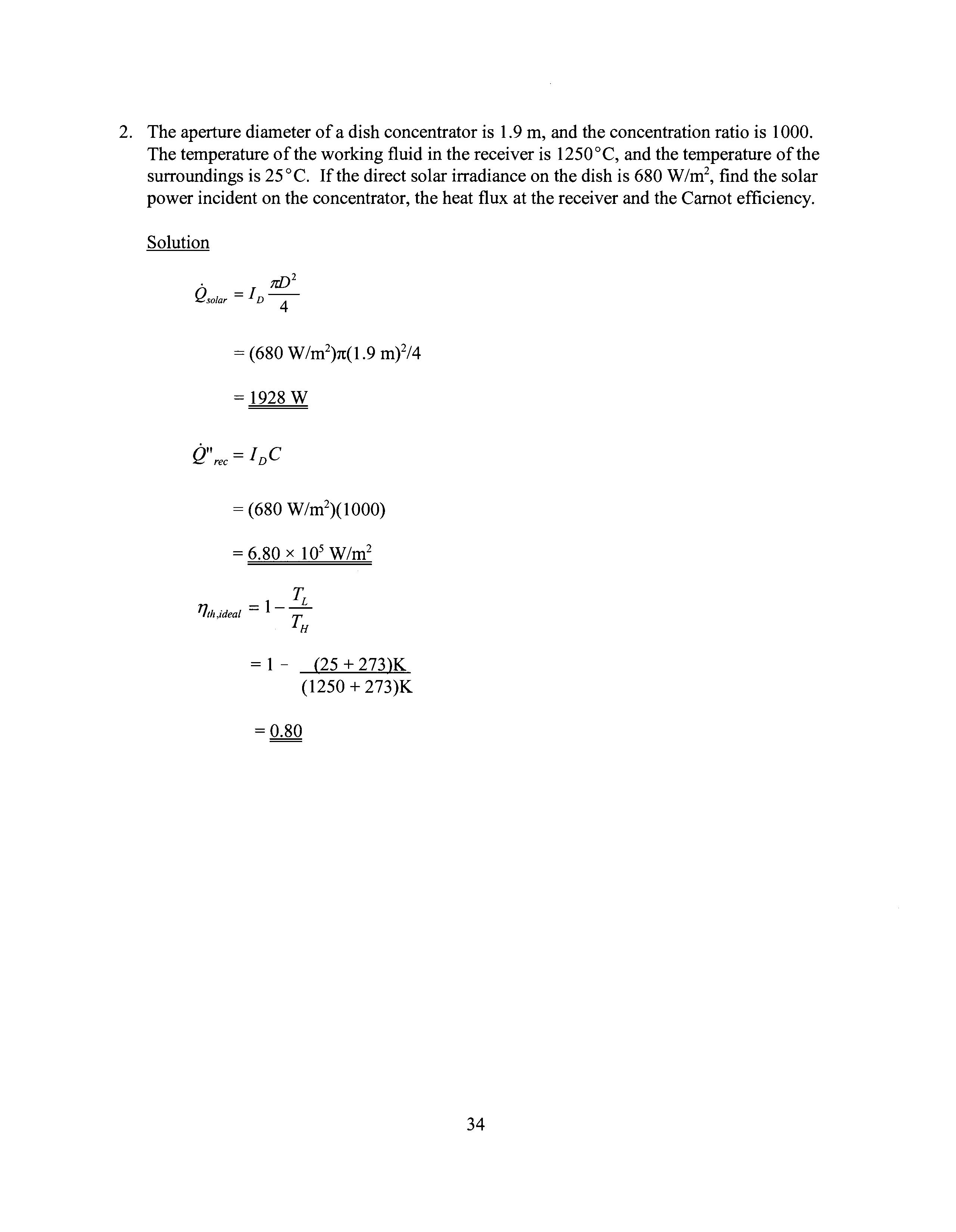
trf)2
Qsolar = J D4= 1928 w
Q"rec = J DC
= (680 W/m2)(1000)
= 6.80 x 105 W/m 2
TL
'17th,ideal = 1- T. H
= 1 - (25 + 273)K (1250 + 273)K = 0.80
3. A parabolic trough concentrator has an aperture width and length of 1.6 m and 24m, respectively. The average direct solar irradiance on the concentrator on a given day is 590 W/m 2 • The efficiencies of the concentrator, receiver, and electrical generator are 0.90, 0.82 and 0.94, respectively. Find the maximum possible electrical output power for a working fluid temperature at the receiver of 400 o C. The temperature of the surroundings is 15 o C.
Solution
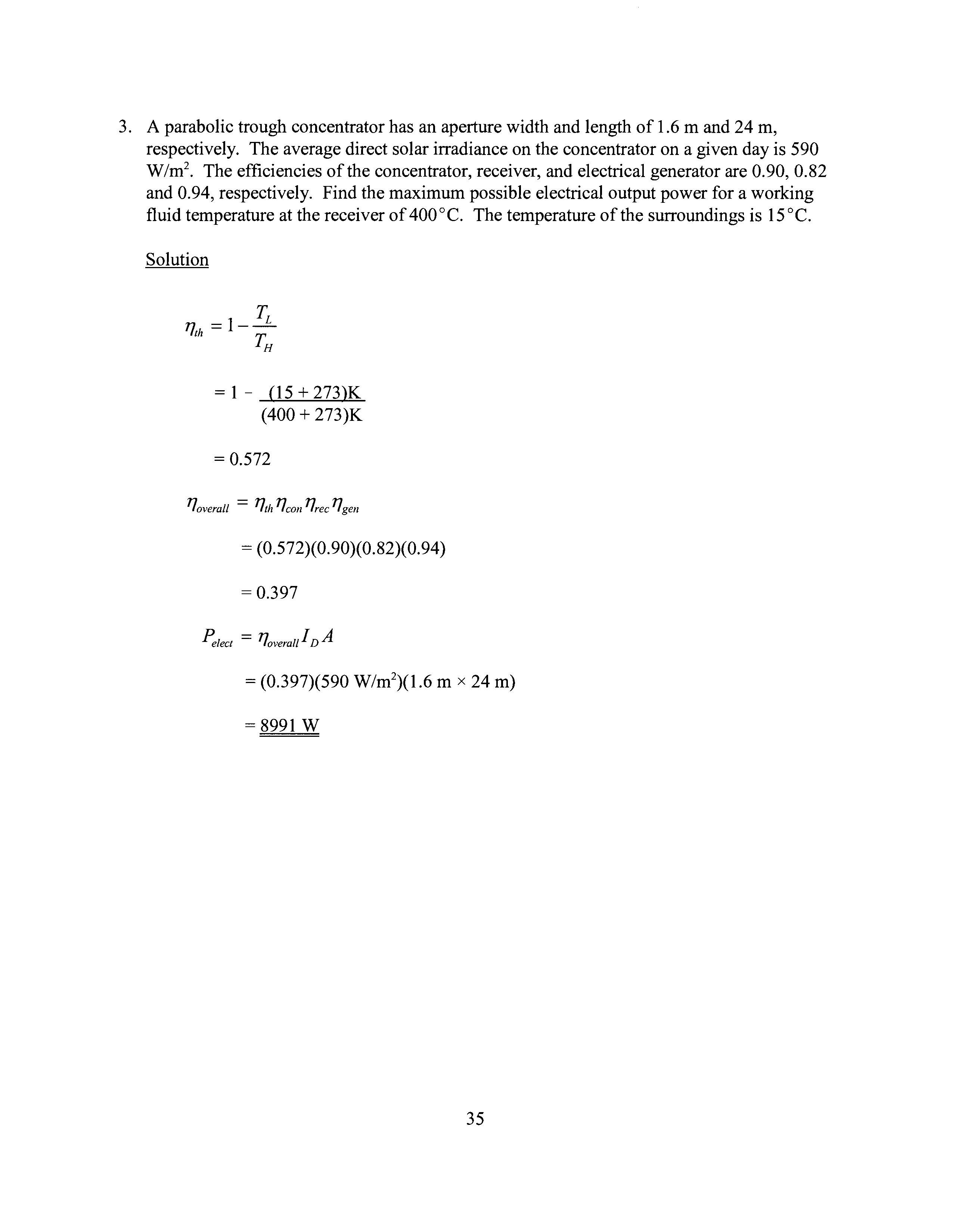
= 1 - (15 + 273)K (400 + 273)K
= 0.572 = (0.572)(0.90)(0.82)(0.94)
= 0.397 = (0.397)(590 W/m 2)(1.6 m x 24m)
= 8991 w
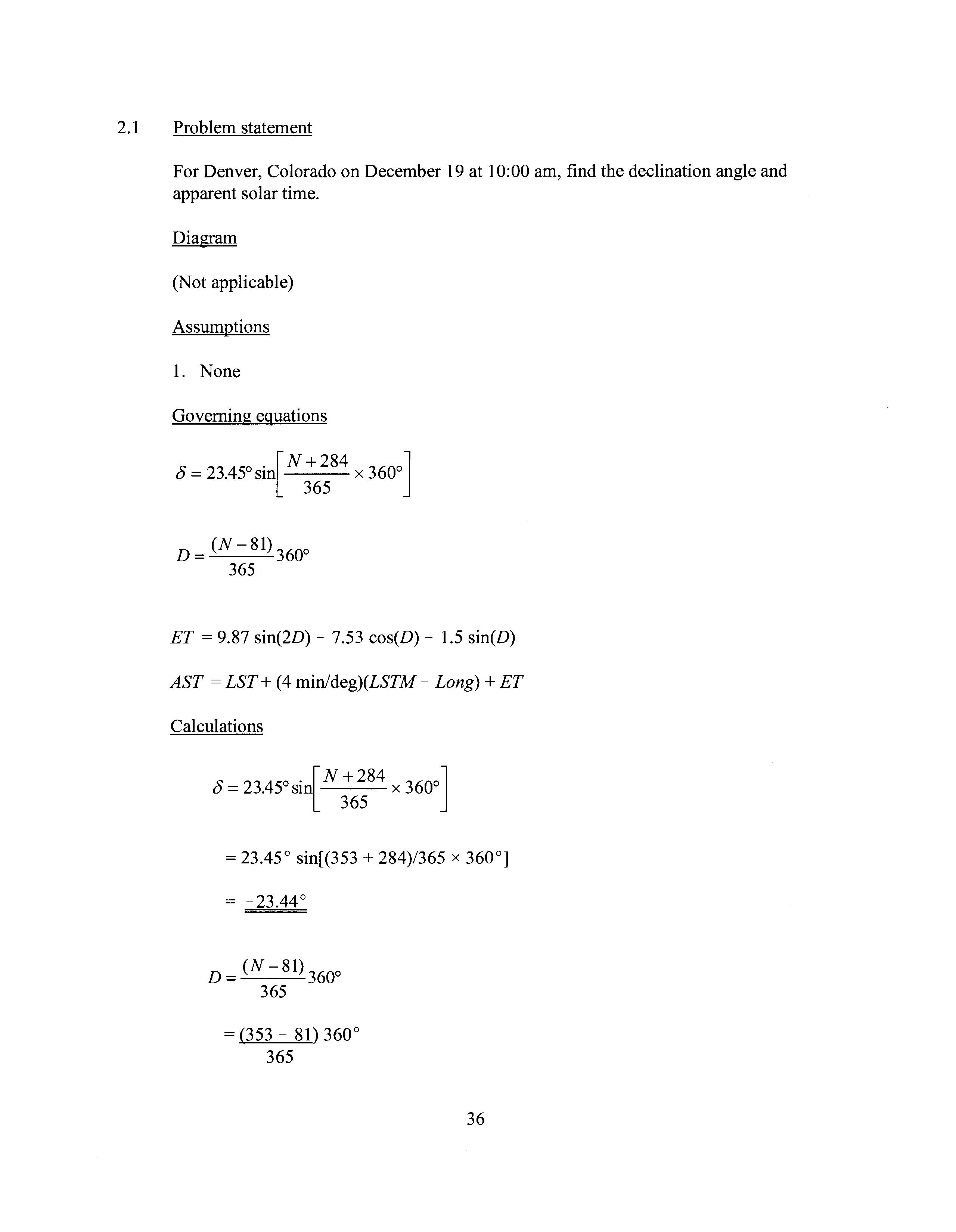
2.1 Problem statement
For Denver, Colorado on December 19 at 10:00 am, find the declination angle and apparent solar time.
Diagram
(Not applicable)
Assumptions
1. None Governing equations
8 = 23.45° sin[ N + 284 x 360°] 365
D = (N - 81) 3 60o 365
ET = 9.87 sin(2D)- 7.53 cos(D)- 1.5 sin(D)
AST = LST + (4 minldeg)(LSTM- Long) + ET
Calculations
8 = 23.45° sin[ N + 284 x 360°] 365
= 23.45° sin[(353 + 284)/365 x 360°]
= -23.44°
D = (N -81) 360o 365 = (353 - 81) 360° 365
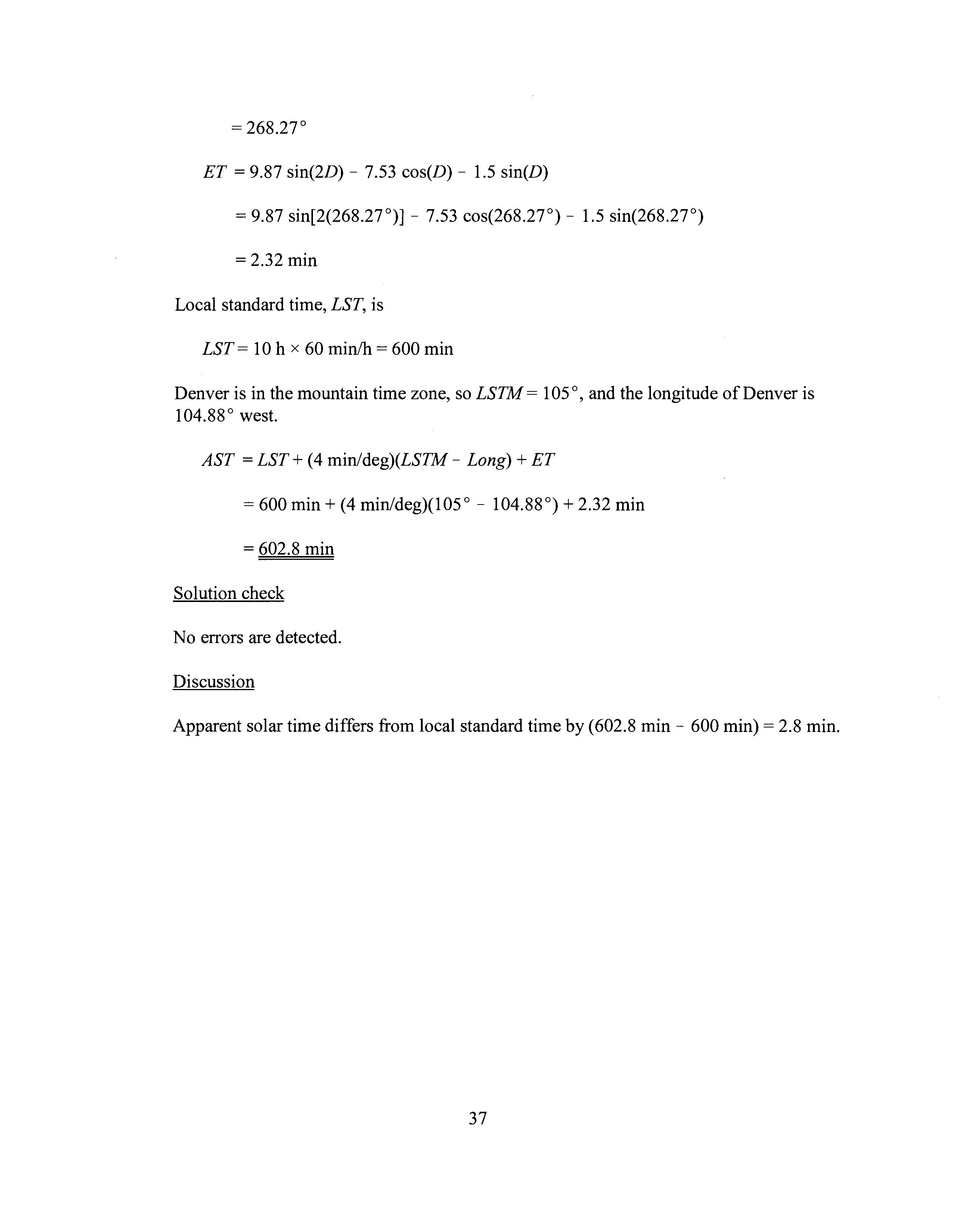
= 268.27°
ET = 9.87 sin(2D)- 7.53 cos(D)- 1.5 sin(D) = 9.87 sin[2(268.2r)] - 7.53 cos(268.2r)- 1.5 sin(268.2r)
= 2.32 min
Local standard time, LST, is
LST= 10 h x 60 minlh = 600 min
Denver is in the mountain time zone, so LSTM = 105 o, and the longitude of Denver is 104.88 o west.
AST = LST + (4 minldeg)(LSTM- Long) + ET = 600 min+ (4 min/deg)(105°- 104.88°) + 2.32 min = 602.8 min
Solution check
No errors are detected.
Discussion
Apparent solar time differs from local standard time by (602.8 min- 600 min)= 2.8 min.
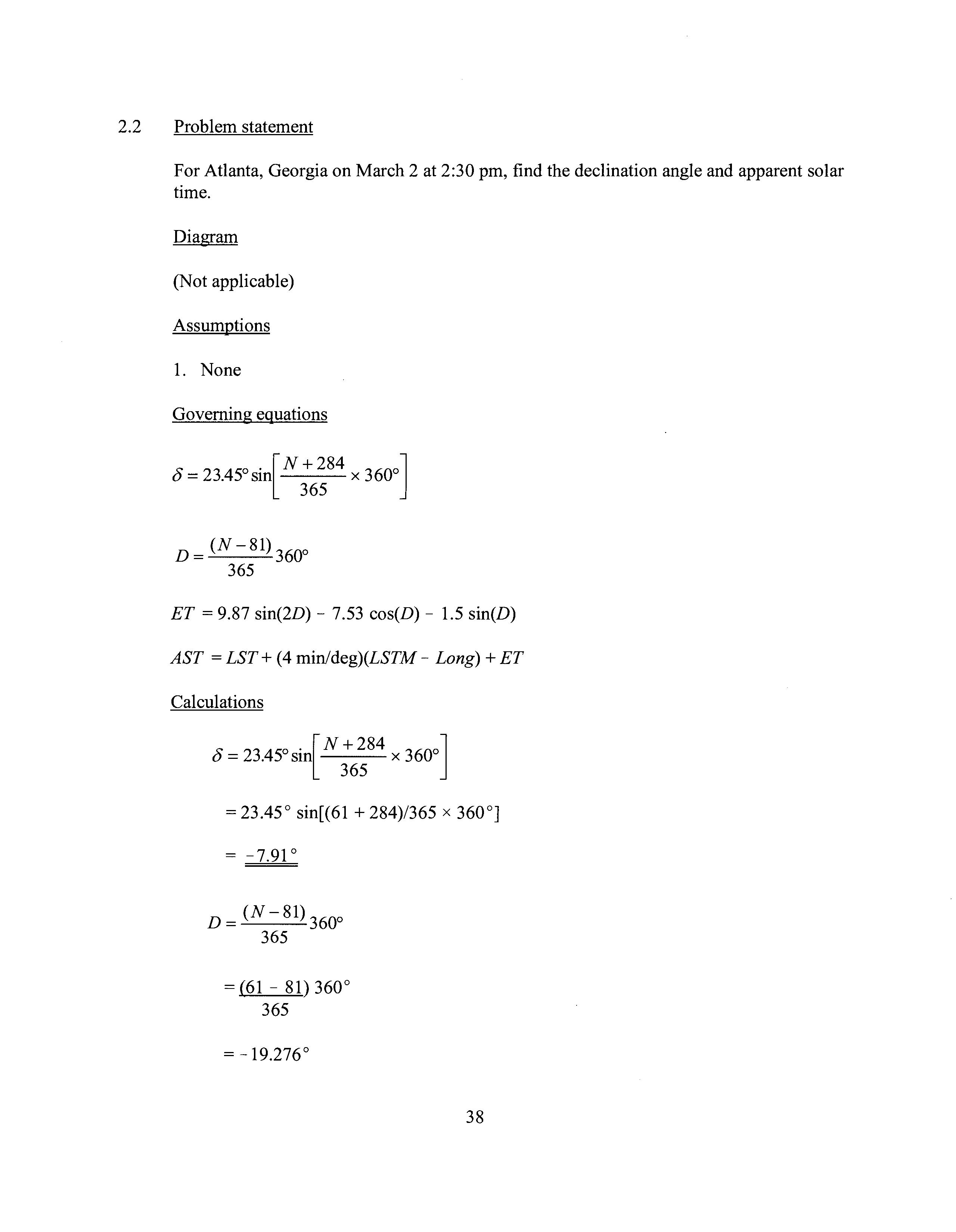
2.2 Problem statement
For Atlanta, Georgia on March 2 at 2:30pm, find the declination angle and apparent solar time.
Diagram
(Not applicable)
Assumptions
1. None Governing equations
8 = 23.45° sin[ N + 284 x 360°] 365
D = (N -81) 360o 365
ET = 9.87 sin(2D)- 7.53 cos(D)- 1.5 sin(D)
AST = LST + (4 minldeg)(LSTM- Long) + ET
Calculations
8 = 23.45° sin[ N + 284 x 360°] 365
= 23.45° sin[(61 + 284)/365 x 360°] = -7.91°
D = (N- 81) 360o 365
= (61 - 81) 360° 365 = -19.276°
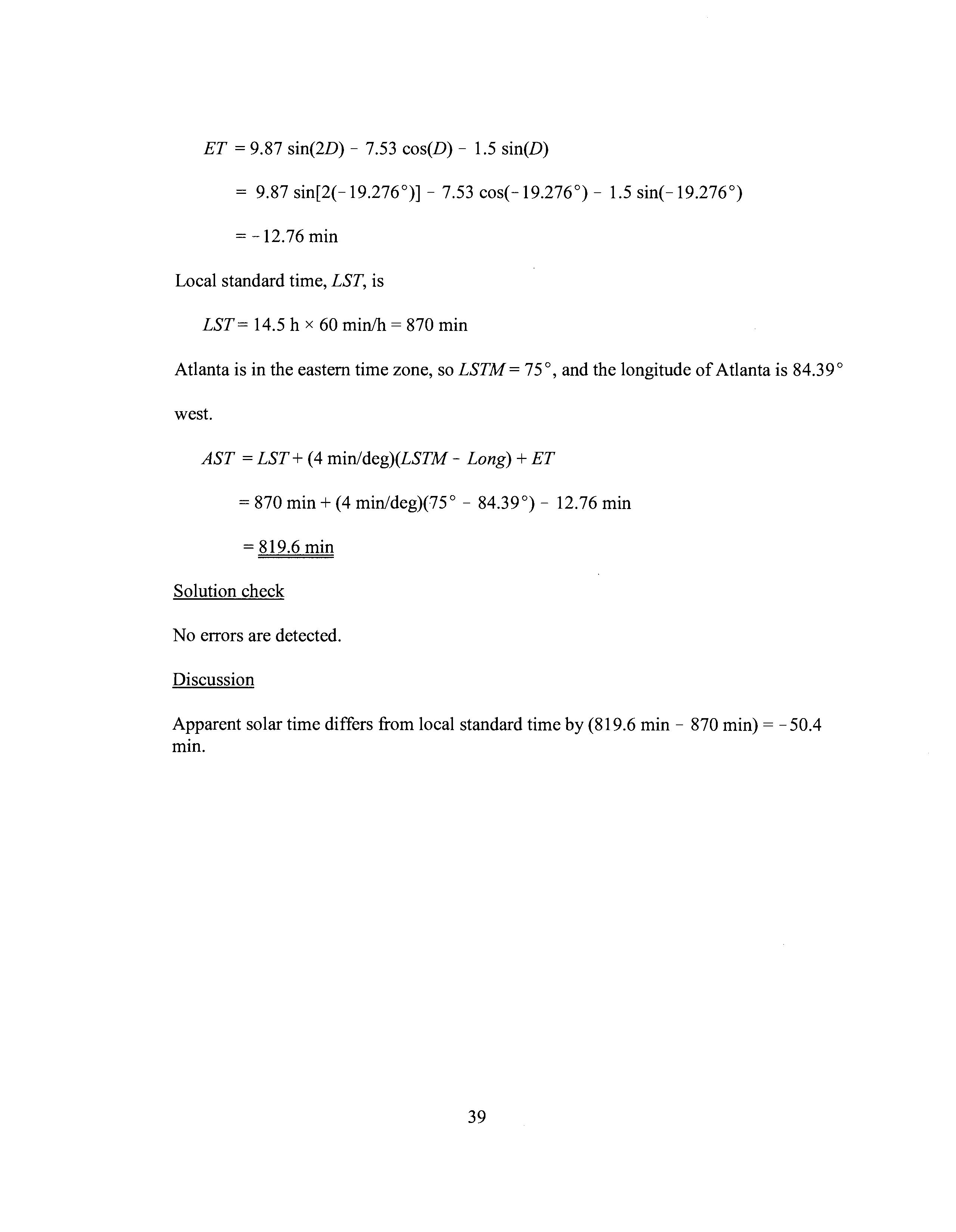
ET = 9.87 sin(2D)- 7.53 cos(D)- 1.5 sin(D)
= 9.87 sin[2(-19.276°)]- 7.53 cos(-19.276°)- 1.5 sin(-19.276°) = -12.76 min
Local standard time, LST, is
LST= 14.5 h x 60 minlh = 870 min
Atlanta is in the eastern time zone, so LSTM = 75°, and the longitude of Atlanta is 84.39° west.
AST = LST + (4 minldeg)(LSTM- Long) + ET = 870 min+ (4 min/deg)(75° - 84.39°)- 12.76 min = 819.6 min
Solution check
No errors are detected.
Discussion
Apparent solar time differs from local standard time by (819 .6 min - 870 min) = -50.4 min.
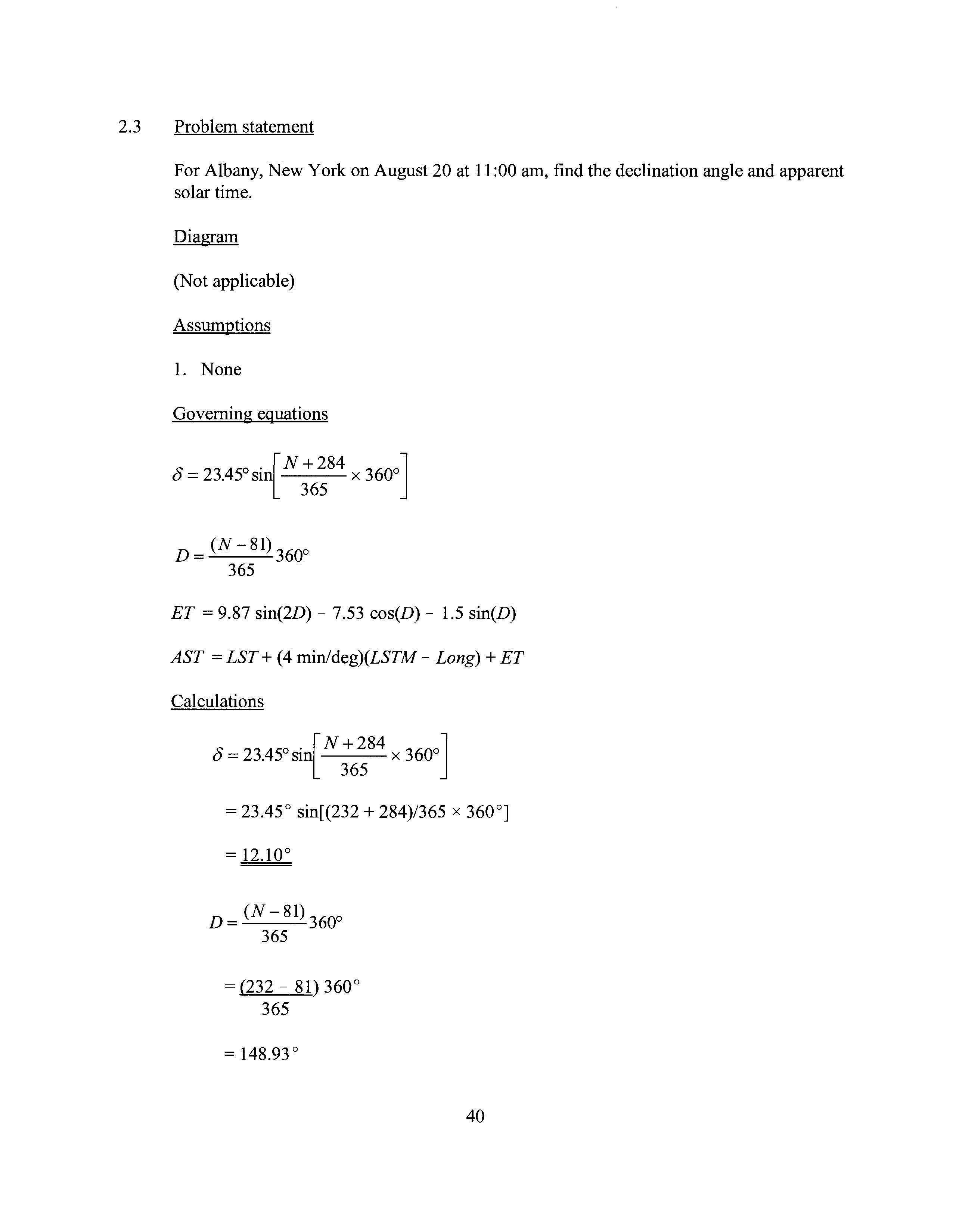
2.3 Problem statement
For Albany, New York on August 20 at 11:00 am, find the declination angle and apparent solar time.
Diagram
(Not applicable)
Assumptions
1. None Governing equations
8 = 23.45° sin[N + 284 x 360°] 365
D = (N- 81) 360o 365
ET = 9.87 sin(2D)- 7.53 cos(D)- 1.5 sin(D)
AST = LST + (4 minldeg)(LSTM- Long) + ET
Calculations
8 = 23.45° sin[ N + 284 x 360°] 365
= 23.45° sin[(232 + 284)/365 x 360°] = 12.10°
D = (N- 81) 360o 365 = (232- 81) 360° 365
= 148.93 °
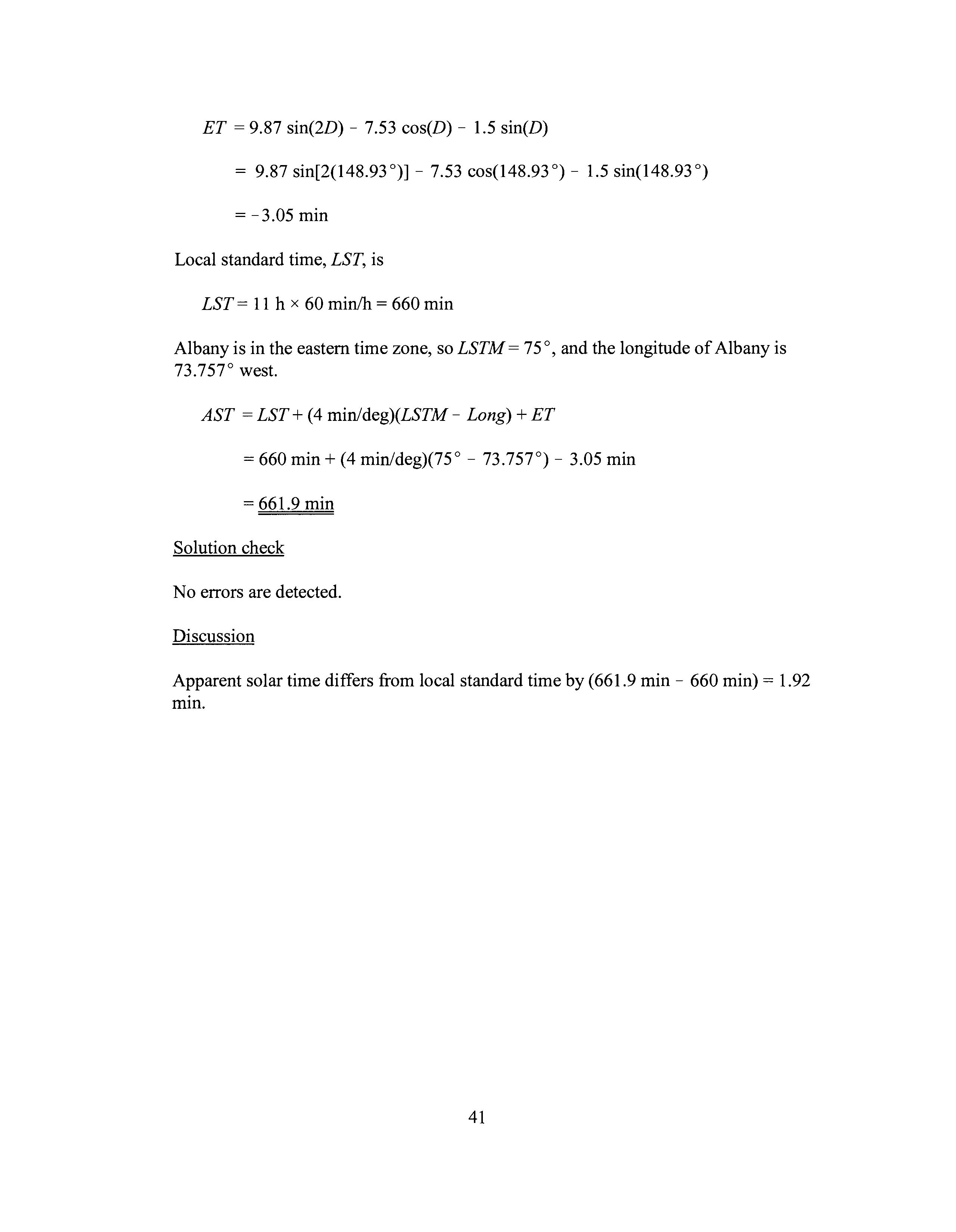
ET = 9.87 sin(2D)- 7.53 cos(D)- 1.5 sin(D)
= 9.87 sin[2(148.93°)]- 7.53 cos(148.93°)- 1.5 sin(148.93°)
= -3.05 min
Local standard time, LST, is
LST= 11 h x 60 min/h = 660 min
Albany is in the eastern time zone, so LSTM = 75o, and the longitude of Albany is 73.75r west.
AST = LST + (4 minldeg)(LSTM- Long) + ET
= 660 min+ (4 min/deg)(75°- 73.75r)- 3.05 min
= 661.9 min
Solution check
No errors are detected.
Discussion
Apparent solar time differs from local standard time by (661.9 min - 660 min) = 1.92 mm.
2.4 Problem statement
A collector, located in Columbus, Ohio has a tilt angle of60o and faces due south. Ifthe foreground is concrete, find the total solar irradiance on the collector at 3 :00 pm on January 21.
Diagram
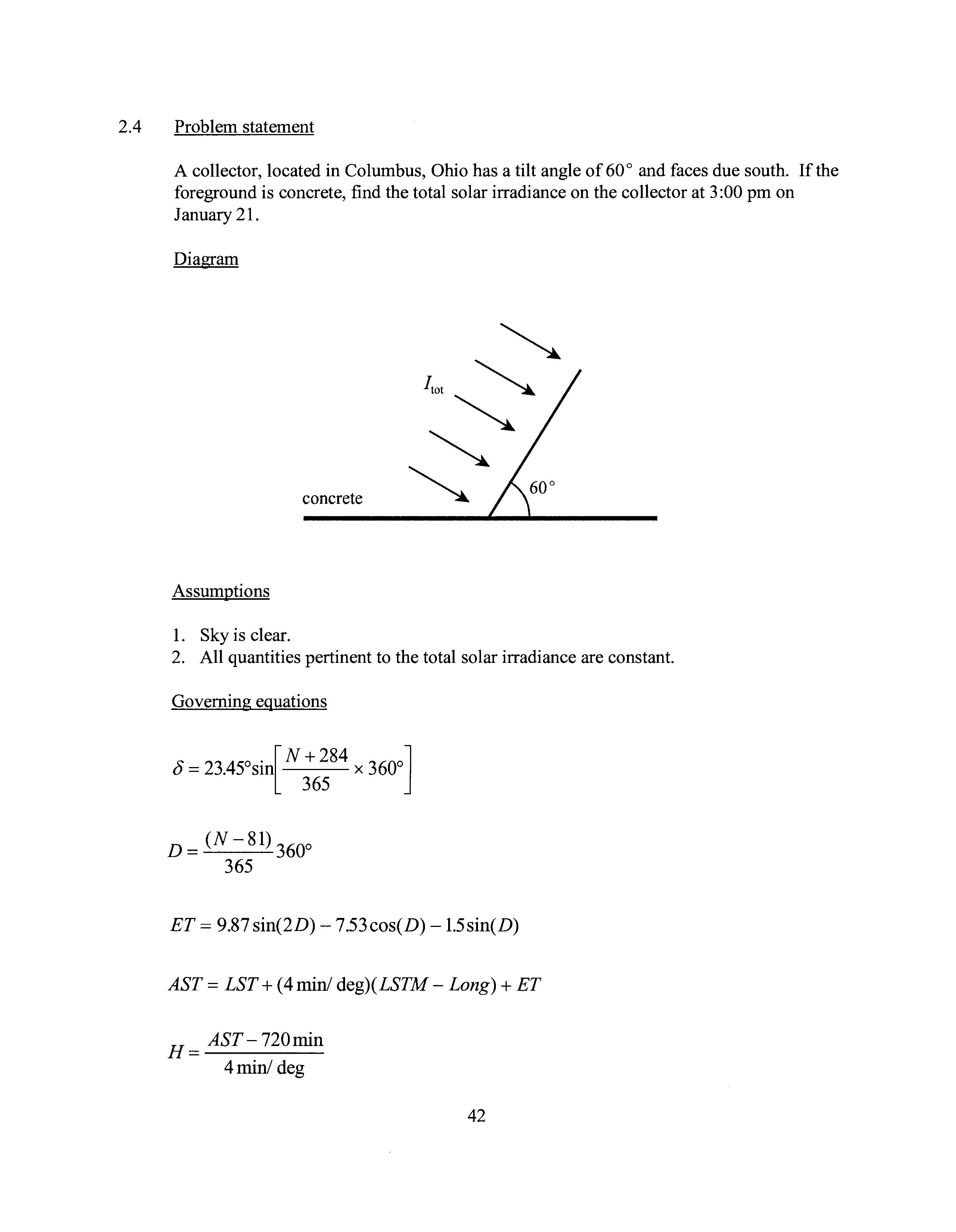
Assumptions
1. Sky is clear.
2. All quantities pertinent to the total solar irradiance are constant.
Governing equations
8 = 23.45°sin[ N + 284 x 360°] 365
D= (N-81)360o 365
ET = 9.87 sin(2D) -7.53cos(D) -1.5sin(D)
AST = LST + (4 min/ de g)( LSTM- Long) + ET
H= AST-720min 4min/ deg
sin(/31) = cos( L) cos( 8) cos( H) + sin( L) sin( 8)
sin(/31) sin( L) - sin( 8) cos a 1 = cos(/31) cos( L)
( )
cos( B) = sin(/31) cos(/32 ) + cos(/31) sin(/32 ) cos( a 1 - a 2 )
plp0 = exp(- 0.1184z)
I = Aexp(--p _B_J DN Po sin(/31)
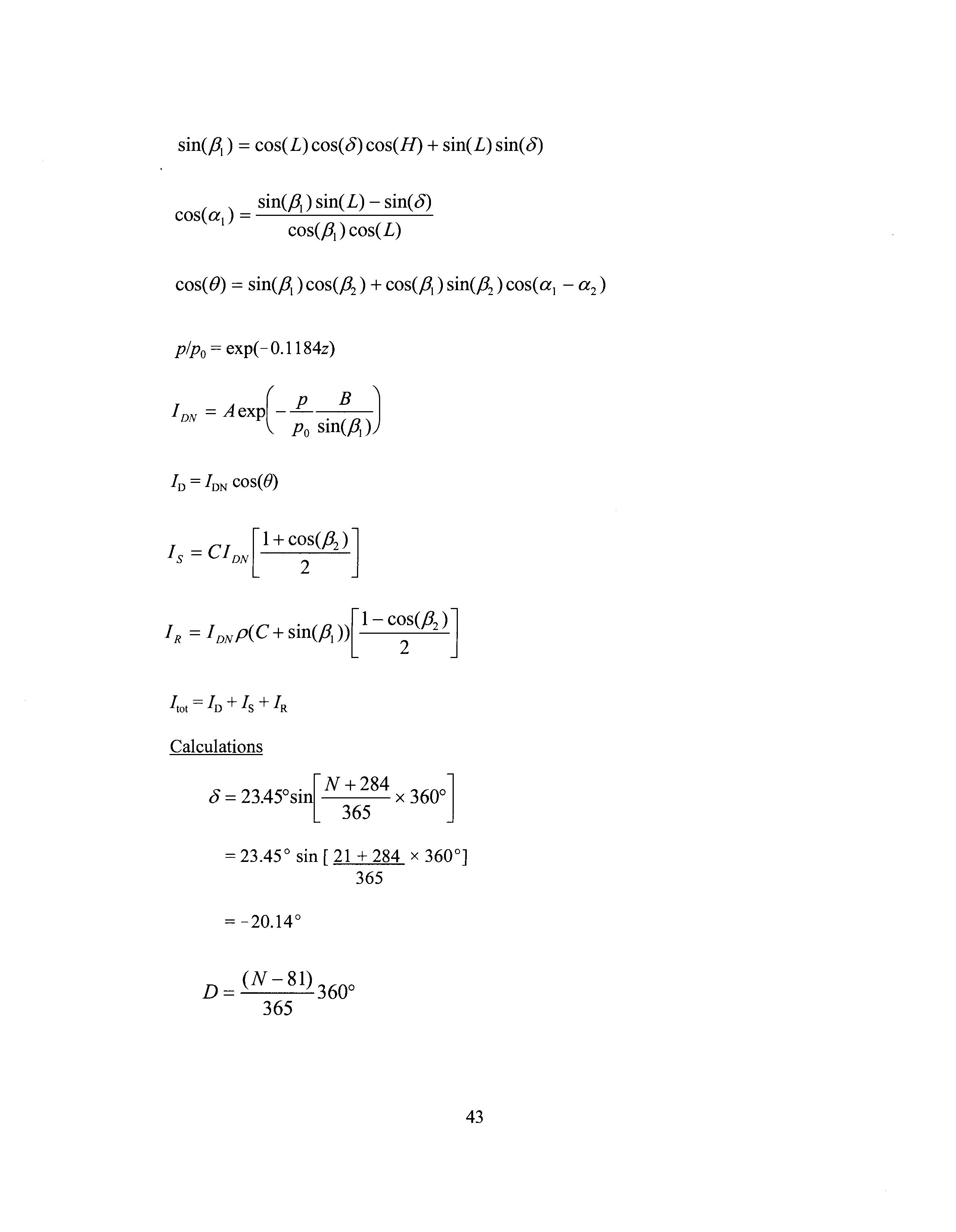
I = C I [ 1+ cos(/32 ) ] S DN 2
Calculations
8 = 23.45°sin[ N + 284 x 360°] 365 = 23.45° sin [ 21 + 284 x 360°] 365 = -20.14°
D = ( N - 81) 360o 365
= (21 - 81) 360°
365 =-59.18°
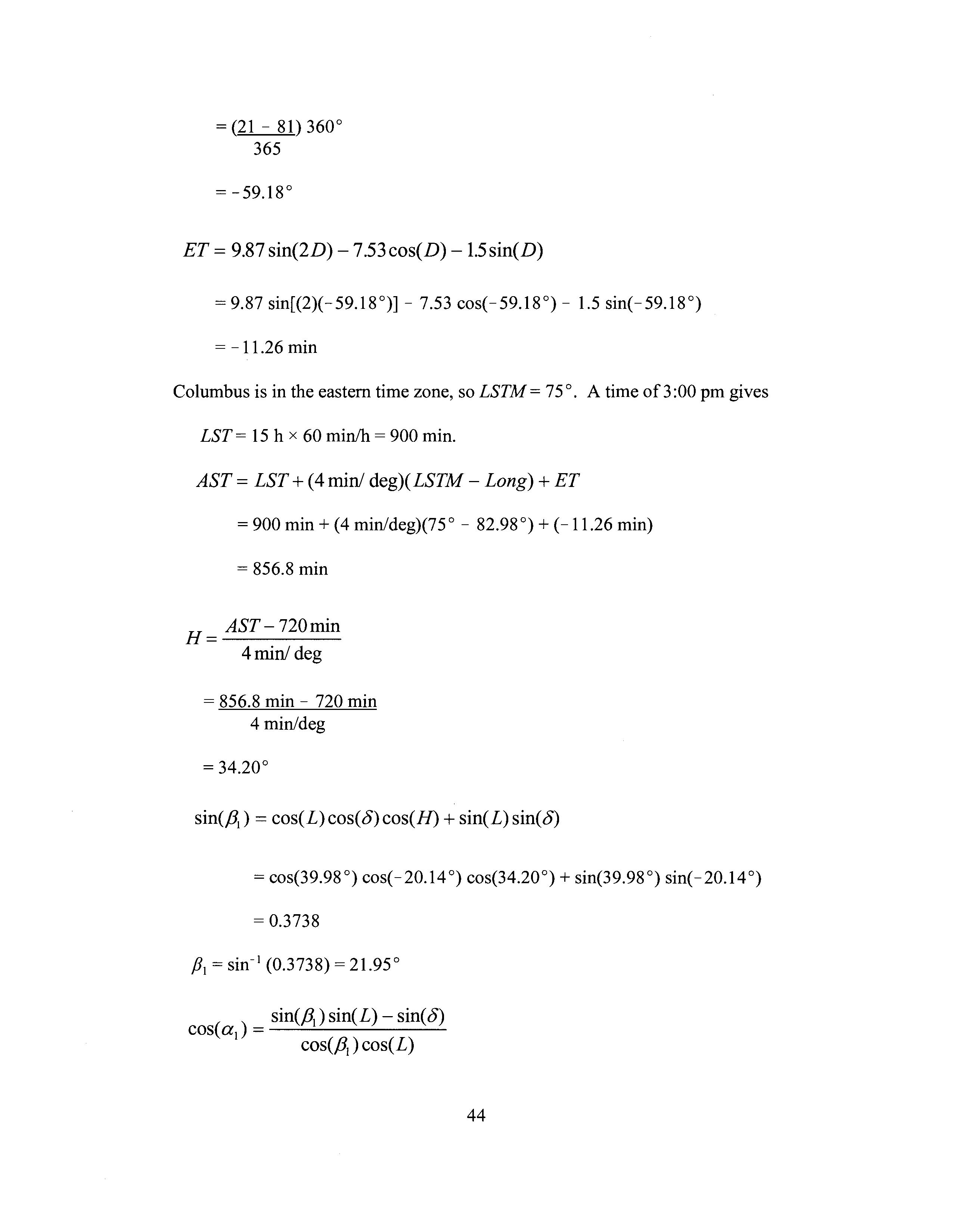
ET = 9.87 sin(2D) -7.53cos(D) -1.5sin(D)
= 9.87 sin[(2)(- 59.18 °)] - 7.53 cos(- 59.18 °) - 1.5 sin(- 59.18 °)
= -11.26 min
Columbus is in the eastern time zone, so LSTM = 75o. A time of 3 :00 pm gives
LST = 15 h x 60 minlh = 900 min.
AST = LST + (4 min! deg)( LSTM- Long) + ET
= 900 min+ (4 min/deg)(75°- 82.98°) + (-11.26 min)
= 856.8 min
H= AST-720min 4min! deg
= 856.8 min - 720 min 4 min/deg
= 34.20°
sin(,B, ) = cos( L) cos( 8) cos( H) + sin( L) sin( 8) = 0.3738
[J, = sin- 1 (0.3738) = 21.95°
( ) sin(/31 ) sin( L) - sin( 8) cos a, = cos(/31 ) cos( L)
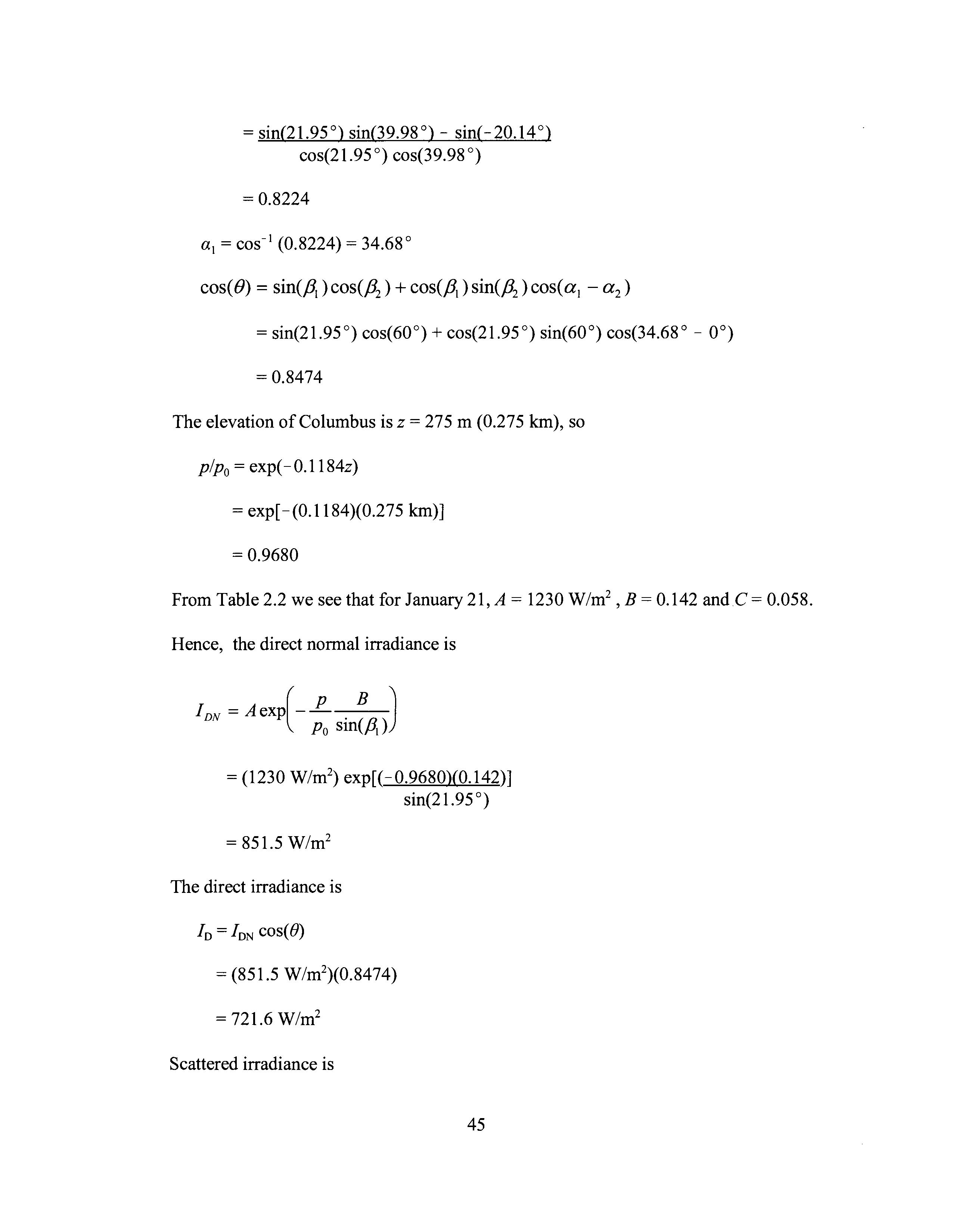
= sin(21.95°) sin(39.98°)- sin(-20.14°) cos(21.95 °) cos(39.98 °)
= 0.8224
a 1 =COS-I (0.8224) = 34.68°
cos(()) = sin(A ) cos(/32 ) + cos(/31 ) sin(/32 ) cos( a 1 - a 2 ) = 0.8474
The elevation of Columbus is z = 275 m (0.275 km), so
plp0 = exp(- 0.1184z)
= exp[ -(0.1184)(0.275 km)]
= 0.9680
From Table 2.2 we see that for January 21, A= 1230 W/m2 , B = 0.142 and C = 0.058.
Hence, the direct normal irradiance is ( p B )
IDN = AexpPo sin(A)
= (1230 W/m2 ) exp[(-0.9680)(0.142)] sin(21.95 °)
= 851.5 W/m 2
The direct irradiance is = (851.5 W/m2)(0.8474) = 721.6 W/m2
Scattered irradiance is
= (0.058)(851.5 W/rn2 )[1 + cos(60°)] 2
= 37.0 W/rn2
The foreground reflectivity for concrete is p = 0.3. The reflected irradiance is
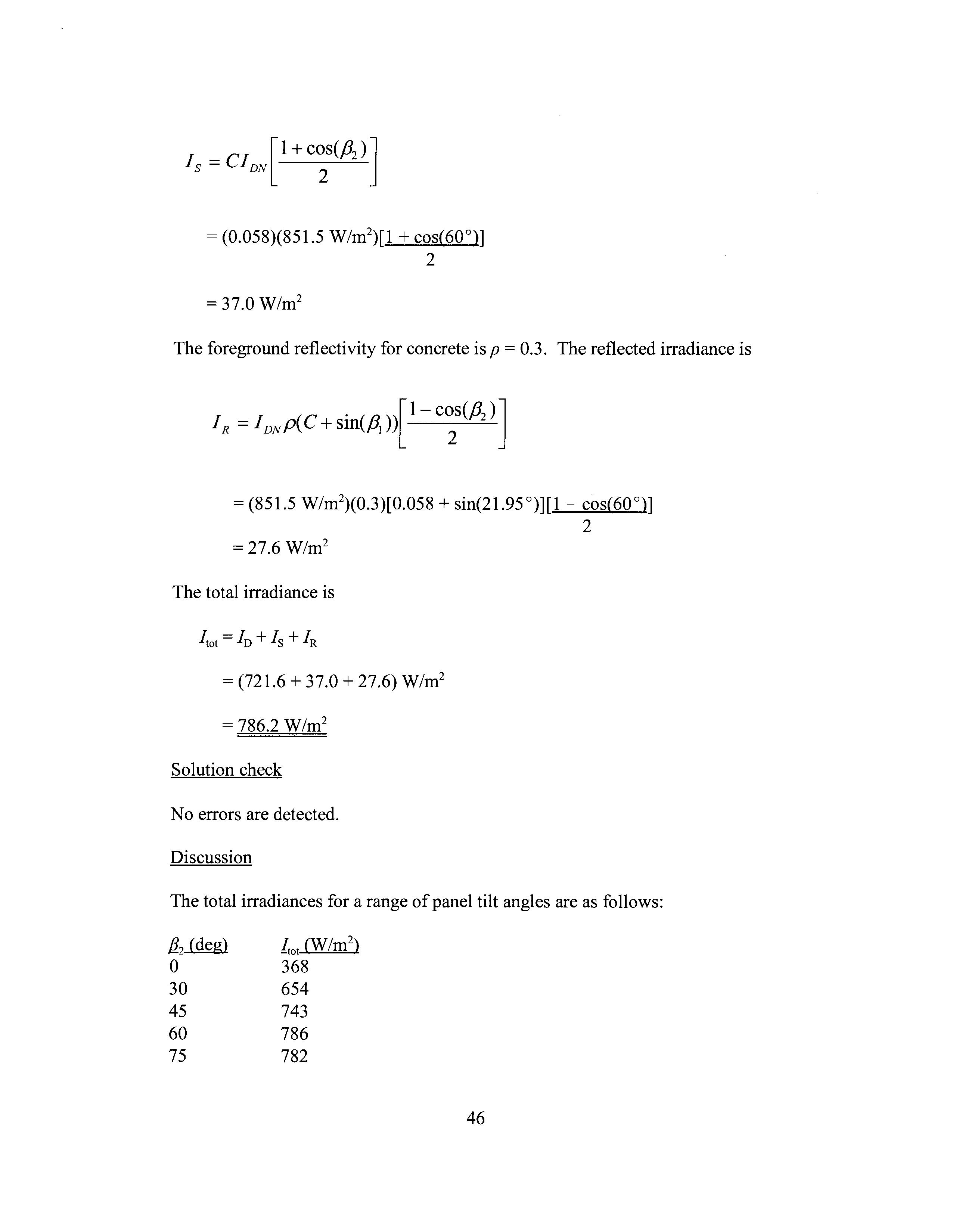
= (851.5 W/rn2)(0.3)[0.058 + sin(21.95°)][1 - cos(60°)] 2 = 27.6 W/rn 2
The total irradiance is = (721.6 + 37.0 + 27.6) W/rn2 = 786.2 W/rn 2
Solution check
No errors are detected.
Discussion
The total irradiances for a range of panel tilt angles are as follows:
(W/rn 2 )
2.5 Problem statement
Consider a south-facing collector in Springfield, Illinois. If the collector tilt angle is 70°, find the total solar irradiance on the collector at 10:30 am on November 21. The foreground is a gravel roof.
Diagram
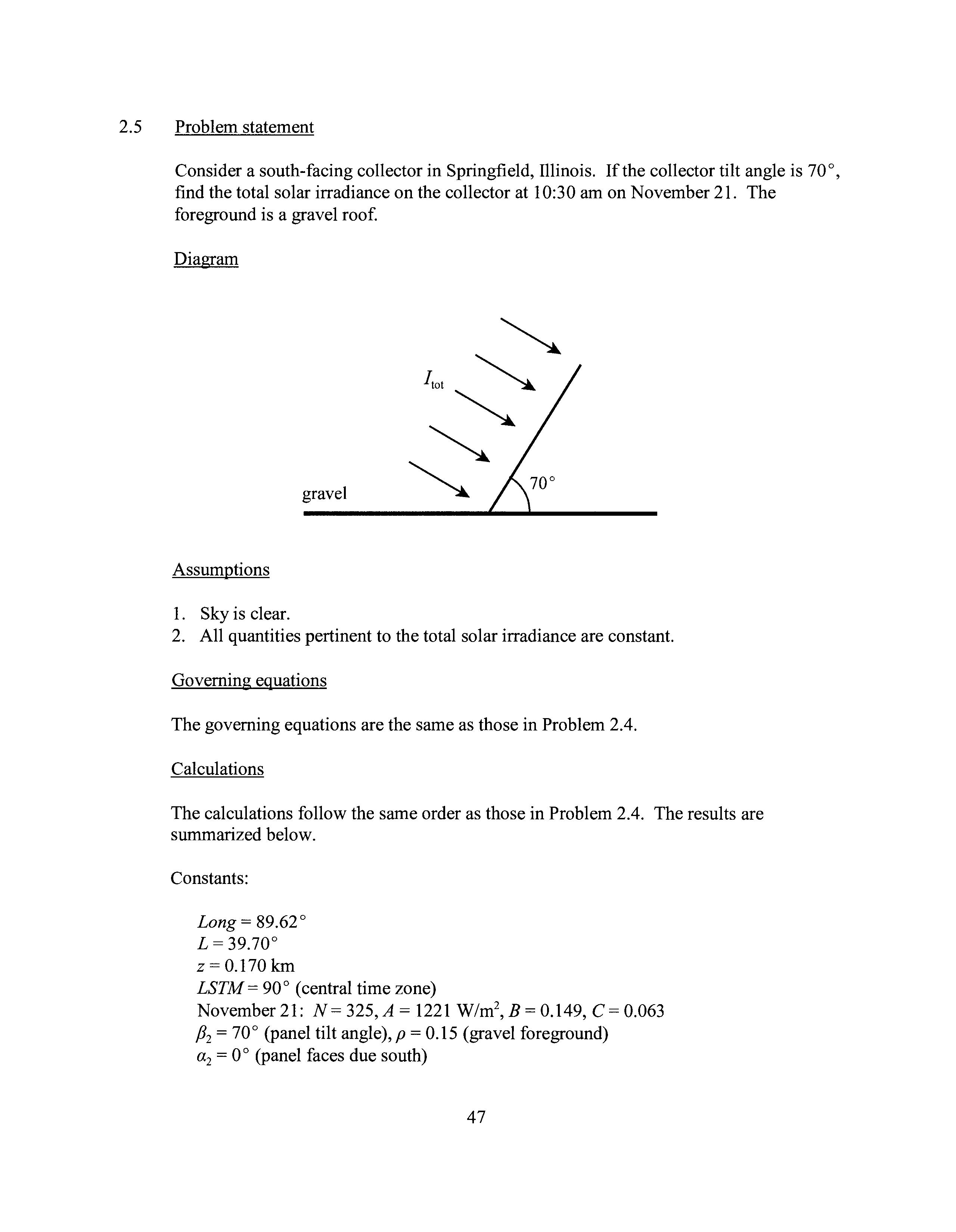
gravel
Assumptions
1. Sky is clear.
2. All quantities pertinent to the total solar irradiance are constant.
Governing equations
The governing equations are the same as those in Problem 2.4.
Calculations
The calculations follow the same order as those in Problem 2.4. The results are summarized below.
Constants:
Long= 89.62°
L = 39.70°
z = 0.170 km
LSTM = 90 o (central time zone)
November 21: N = 325, A= 1221 W/m2 , B = 0.149, C = 0.063
(J2 = 70° (panel tilt angle),p = 0.15 (gravel foreground)
a2 = oo (panel faces due south)
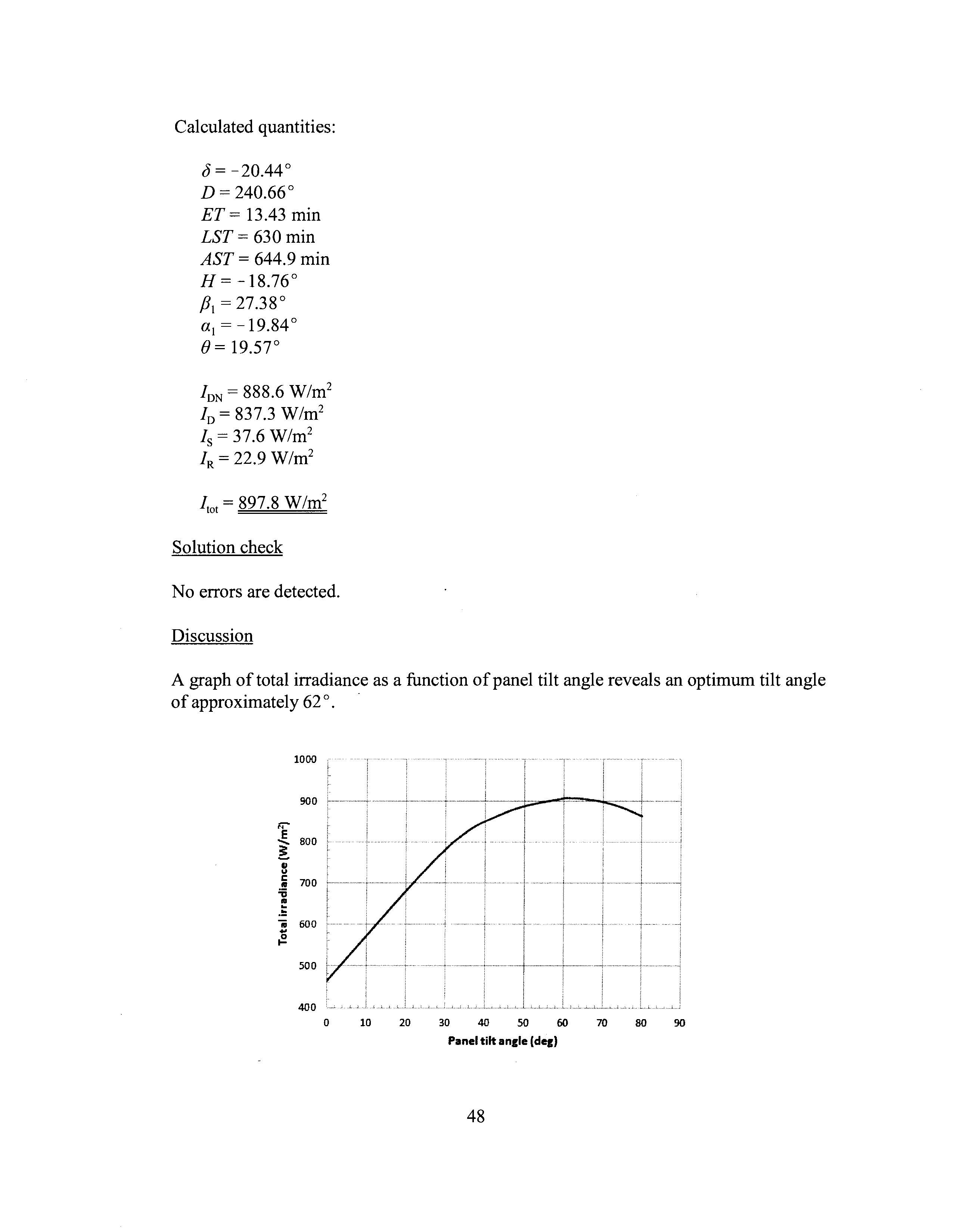
Calculated quantities:
b= -20.44°
D = 240.66°
ET = 13.43 min
LST= 630 min
AST = 644.9 min
H = -18.76°
fJi =27.38°
a 1 = -19.84°
e= 19.sr
IoN= 888.6 W/m 2
10 = 837.3 W/m2
15 = 37.6 W/m 2
IR = 22.9 W/m2
]tot= 897.8 W/m2
Solution check
No errors are detected.
Discussion
A graph of total irradiance as a function of panel tilt angle reveals an optimum tilt angle of approximately 62 o.
2.6 Problem statement
A horizontal collector on a rooftop is located in Austin, Texas. Find the total solar irradiance on the collector at 11:30 am on July 12.
Diagram
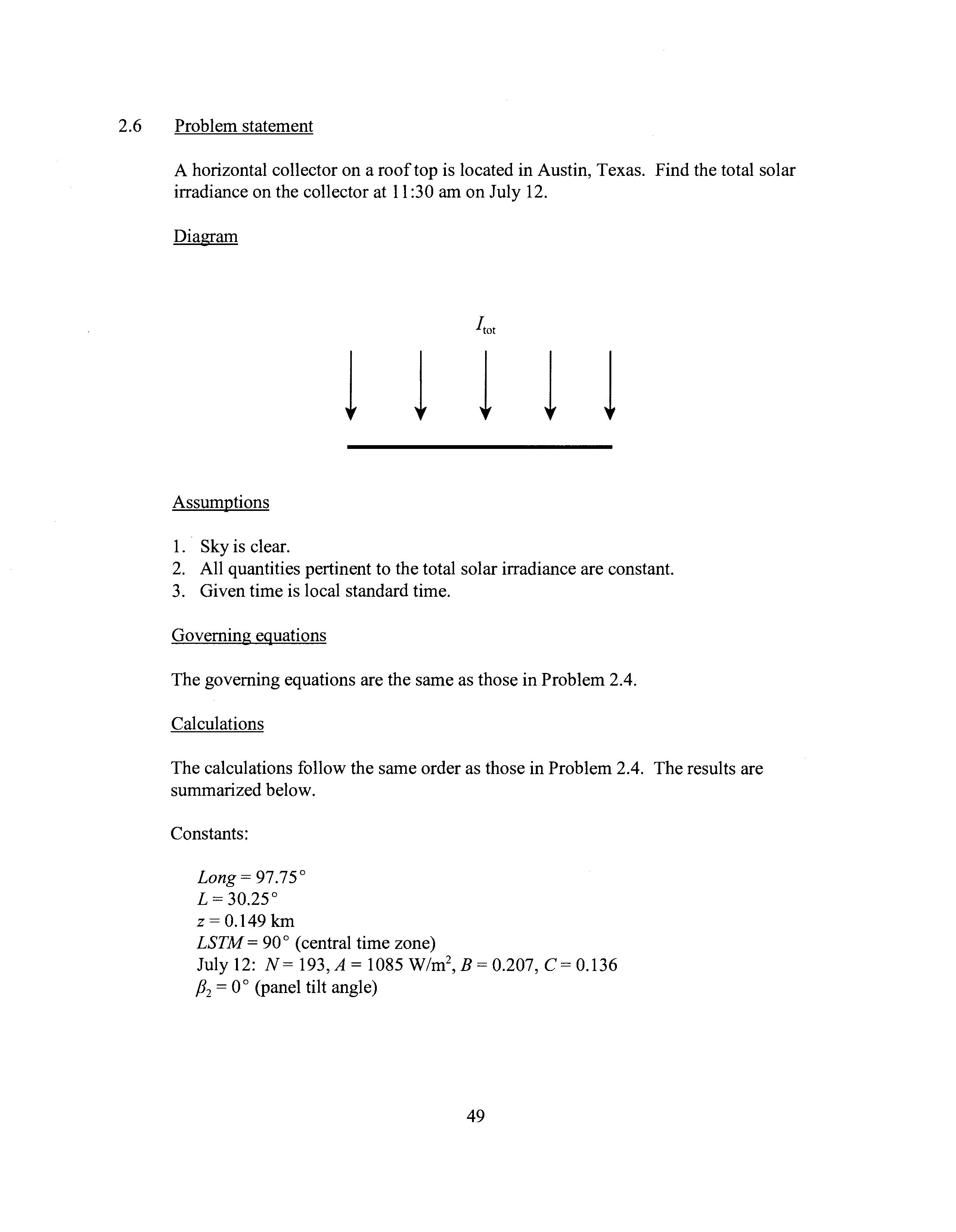
Assumptions
1. Sky is clear.
2. All quantities pertinent to the total solar irradiance are constant.
3. Given time is local standard time.
Governing equations
The governing equations are the same as those in Problem 2.4.
Calculations
The calculations follow the same order as those in Problem 2.4. The results are summarized below.
Constants:
Long= 97.75°
L = 30.25°
z = 0.149 krn
LSTM = 90 o (central time zone)
July 12: N= 193, A= 1085 W/m2, B = 0.207, C= 0.136
/]2 = 0 o (panel tilt angle)
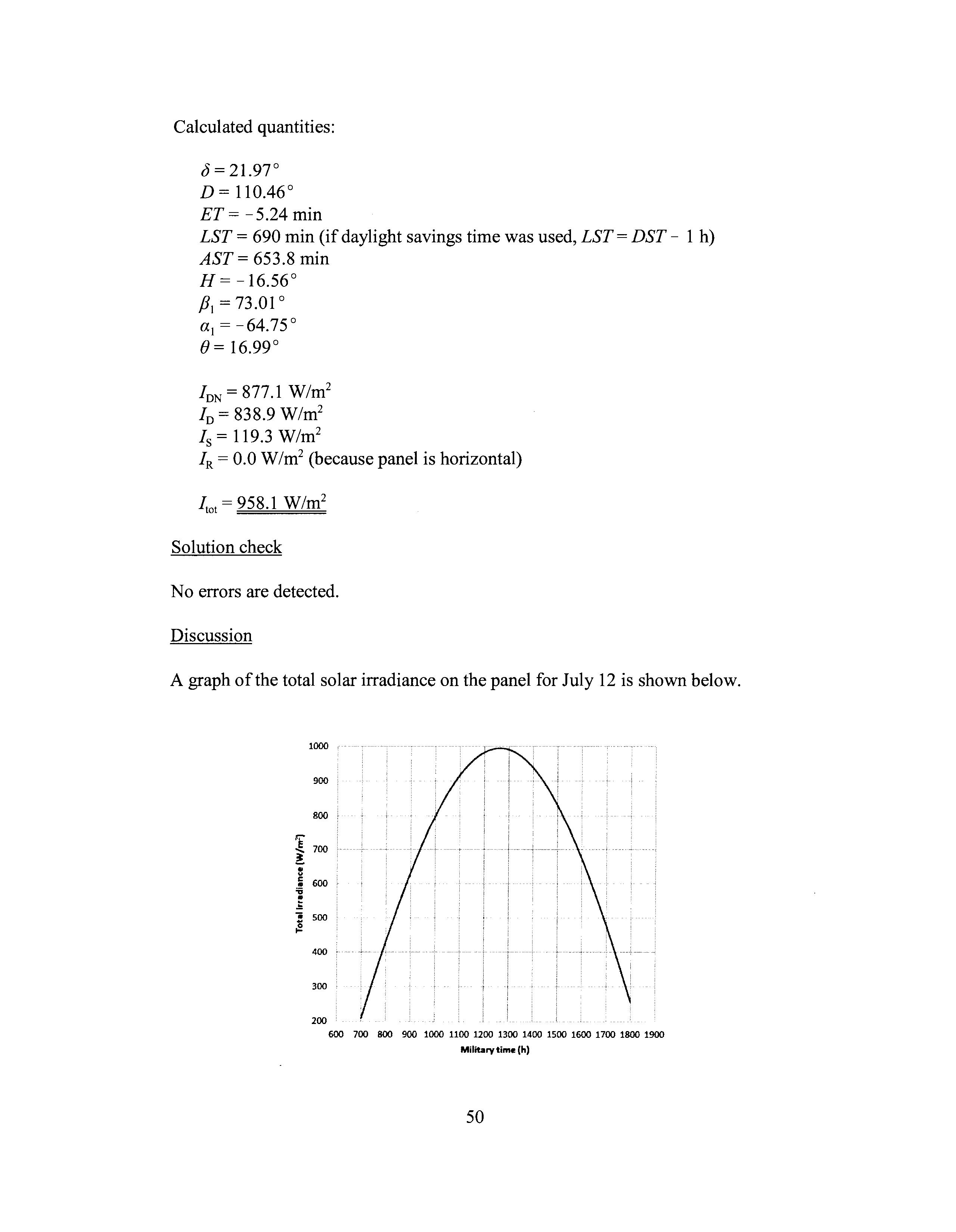
Calculated quantities:
b= 2L9r
D = 110.46°
ET = -5.24 min
LST = 690 min (if daylight savings time was used, LST = DST- 1 h)
AST = 653.8 min
H = -16.56°
fJ] = 73.01°
a 1 = -64.75°
e = 16.99°
/ 0 N = 877.1 W/m 2
10 = 838.9 W/m2
Is= 119.3 W/m 2
IR = 0.0 W/m2 (because panel is horizontal)
!tot= 958.1 W/m 2
Solution check
No errors are detected.
Discussion
A graph ofthe total solar irradiance on the panel for July 12 is shown below.
2. 7 Problem statement
The collector in Problem 2.4 has a surface area of 24 m 2 • Find the total solar power incident on the collector at 1:00pm. Also, find the insolation and the total solar energy incident on the collector during the day.
Diagram
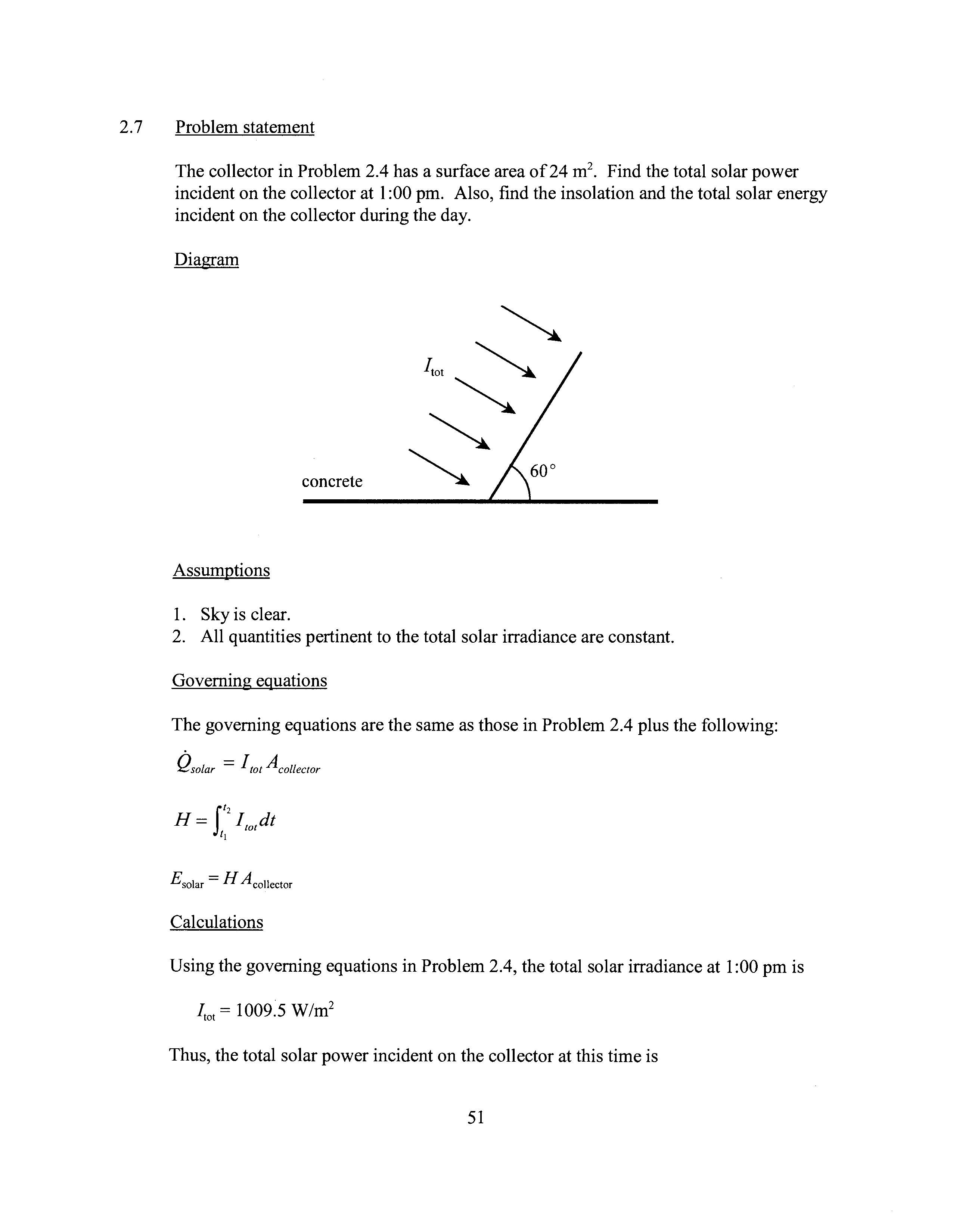
Assumptions
1. Sky is clear.
2. All quantities pertinent to the total solar irradiance are constant.
Governing equations
The governing equations are the same as those in Problem 2.4 plus the following:
Qsolar = /tot Acollector
£solar = H Acollector
Calculations
Using the governing equations in Problem 2.4, the total solar irradiance at 1:00pm is
!tot= 1009.5 W/m2
Thus, the total solar power incident on the collector at this time is
Qsolar = /tot Acollector = 2.423 X 104 w = 24.23 kW
The graph below, generated by calculating the total irradiance at hourly intervals, shows the total irradiance throughout the day.
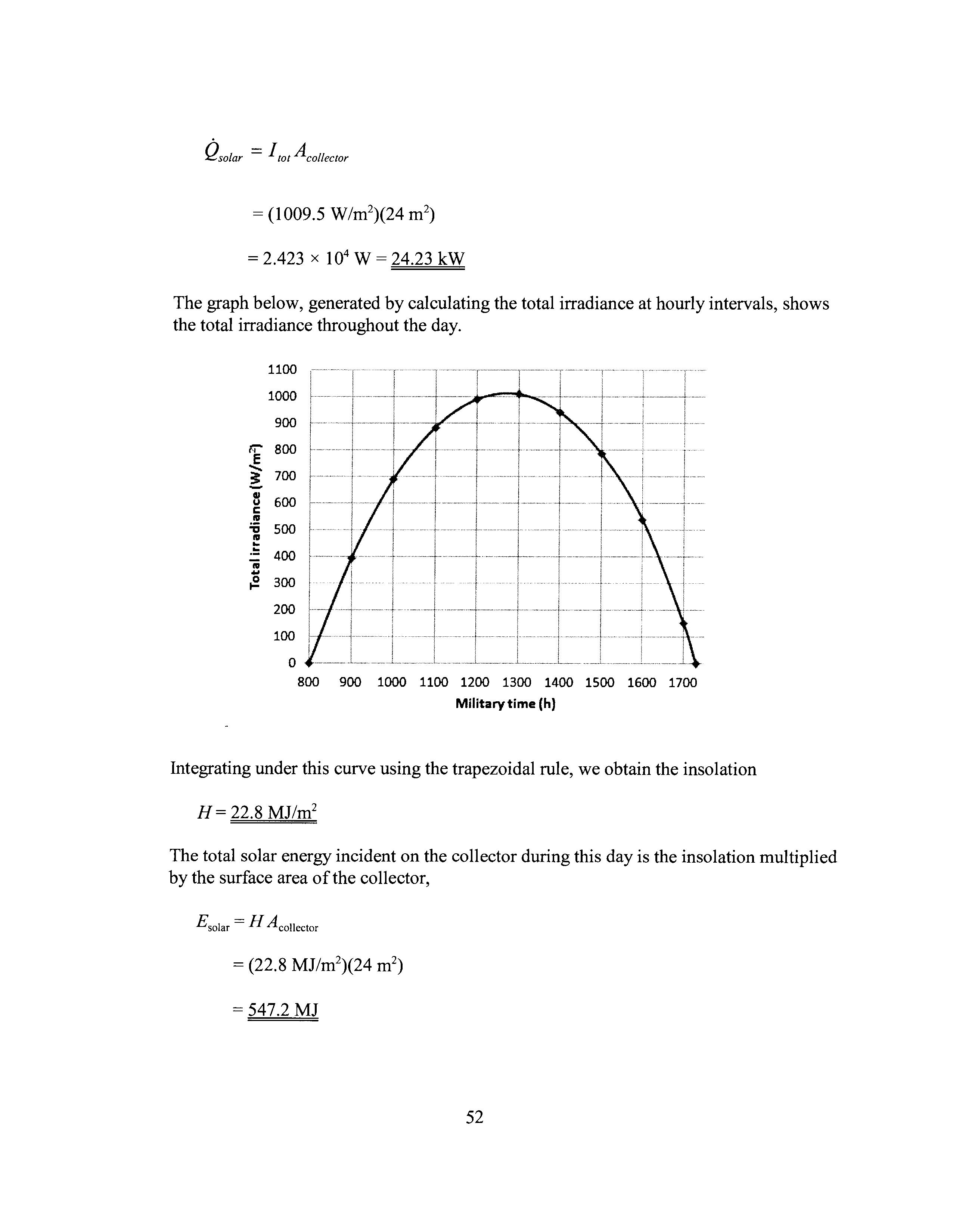
Integrating under this curve using the trapezoidal rule, we obtain the insolation
H = 22.8 MJ/m2
The total solar energy incident on the collector during this day is the insolation multiplied by the surface area of the collector,
£solar = H Acollector = 547.2 MJ
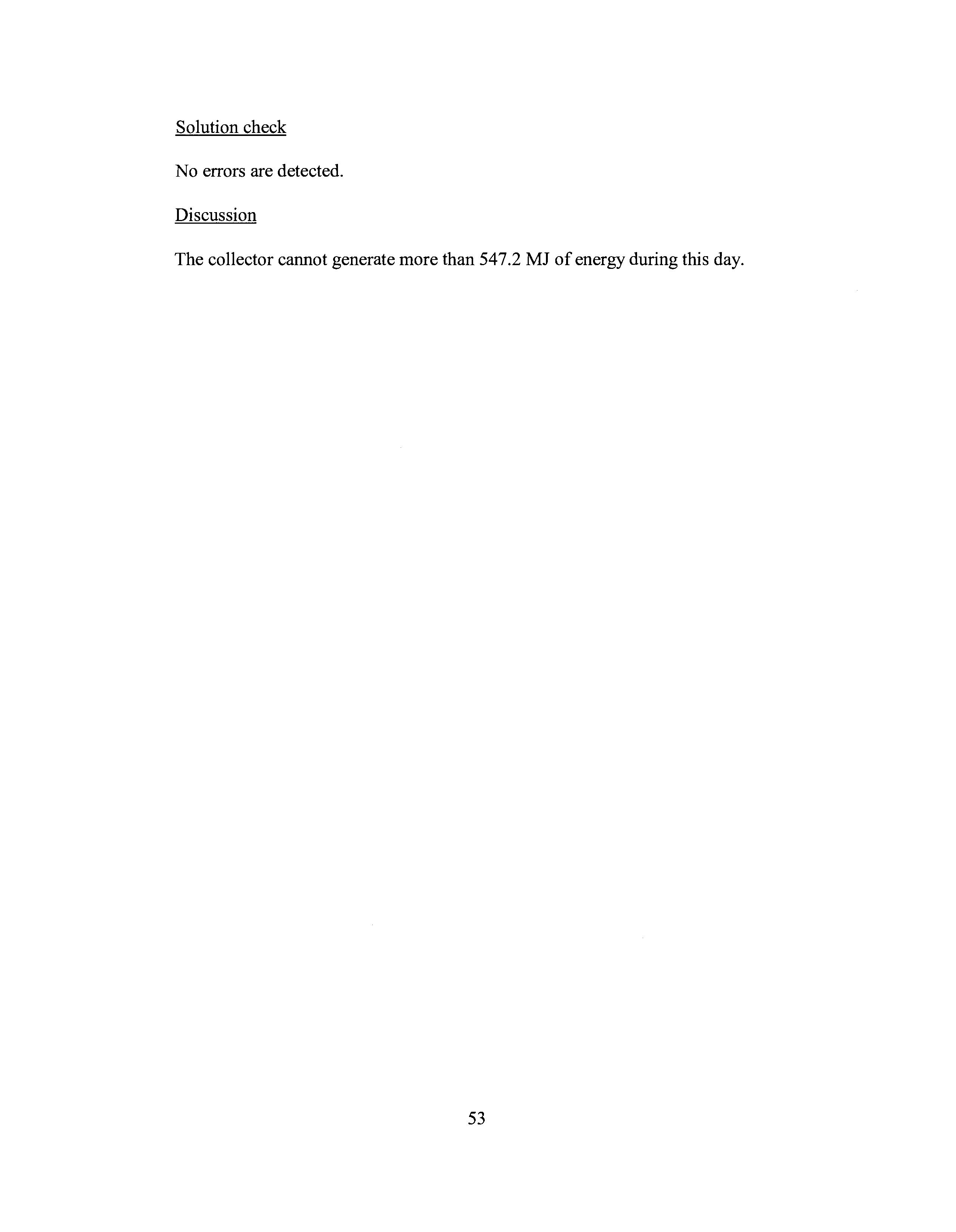
Solution check
No errors are detected.
Discussion
The collector cannot generate more than 54 7.2 MJ of energy during this day.
2.8 Problem statement
The collector in Problem 2.5 has a surface area of 18m2 • Find the total solar power incident on the collector at 11 :00 am. Also, find the insolation and the total solar energy incident on the collector during the day.
Diagram
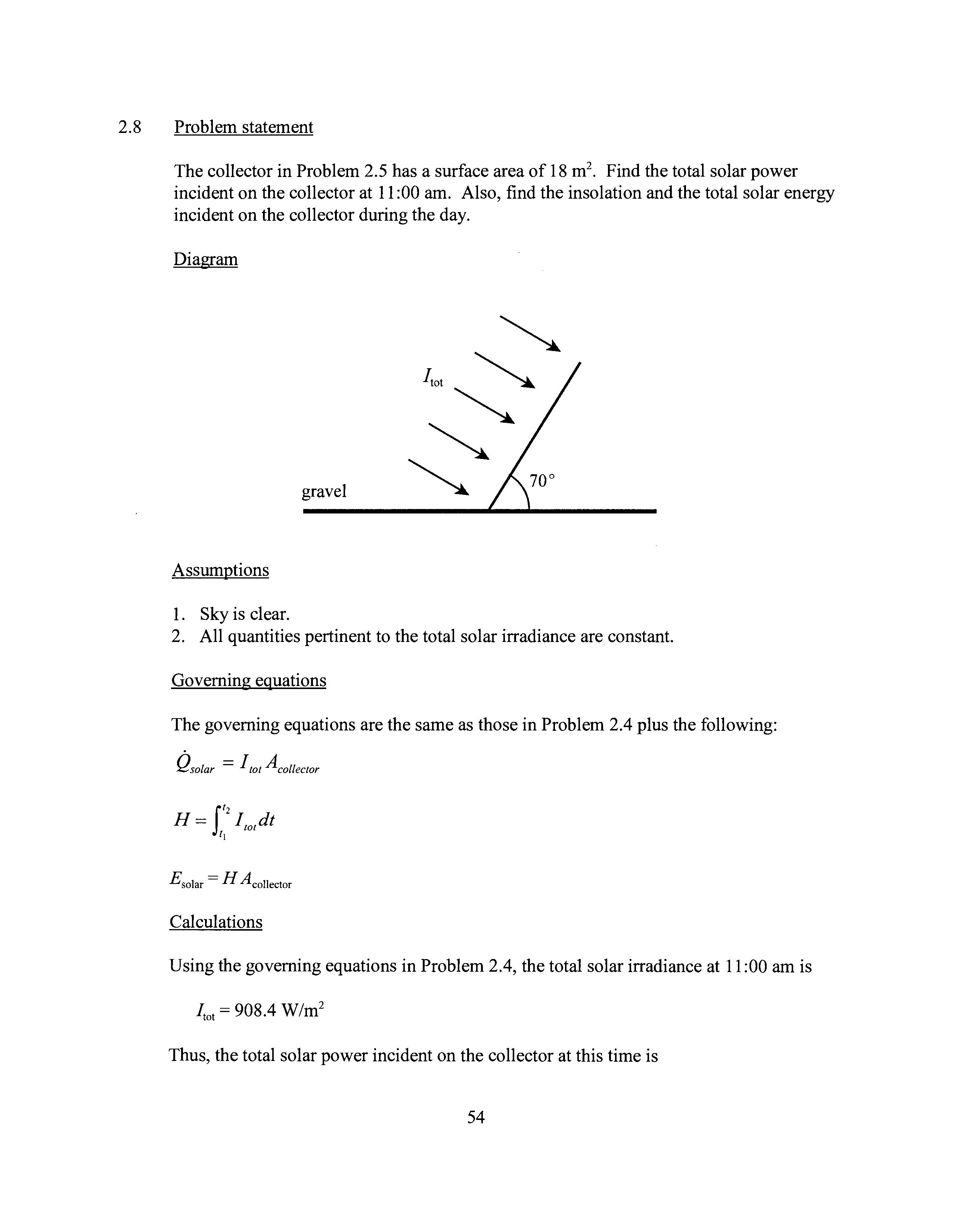
gravel
Assumptions
1. Sky is clear.
2. All quantities pertinent to the total solar irradiance are constant.
Governing equations
The governing equations are the same as those in Problem 2.4 plus the following:
Qsolar = /tot Acollector
£solar = H Acollector
Calculations
Using the governing equations in Problem 2.4, the total solar irradiance at 11:00 am is
/tot= 908.4 W/m 2
Thus, the total solar power incident on the collector at this time is
Qsolar = ]tot Acollector = 1.635 X 104 w = 16.35 kW
The graph below, generated by calculating the total irradiance at hourly intervals, shows the total irradiance throughout the day.
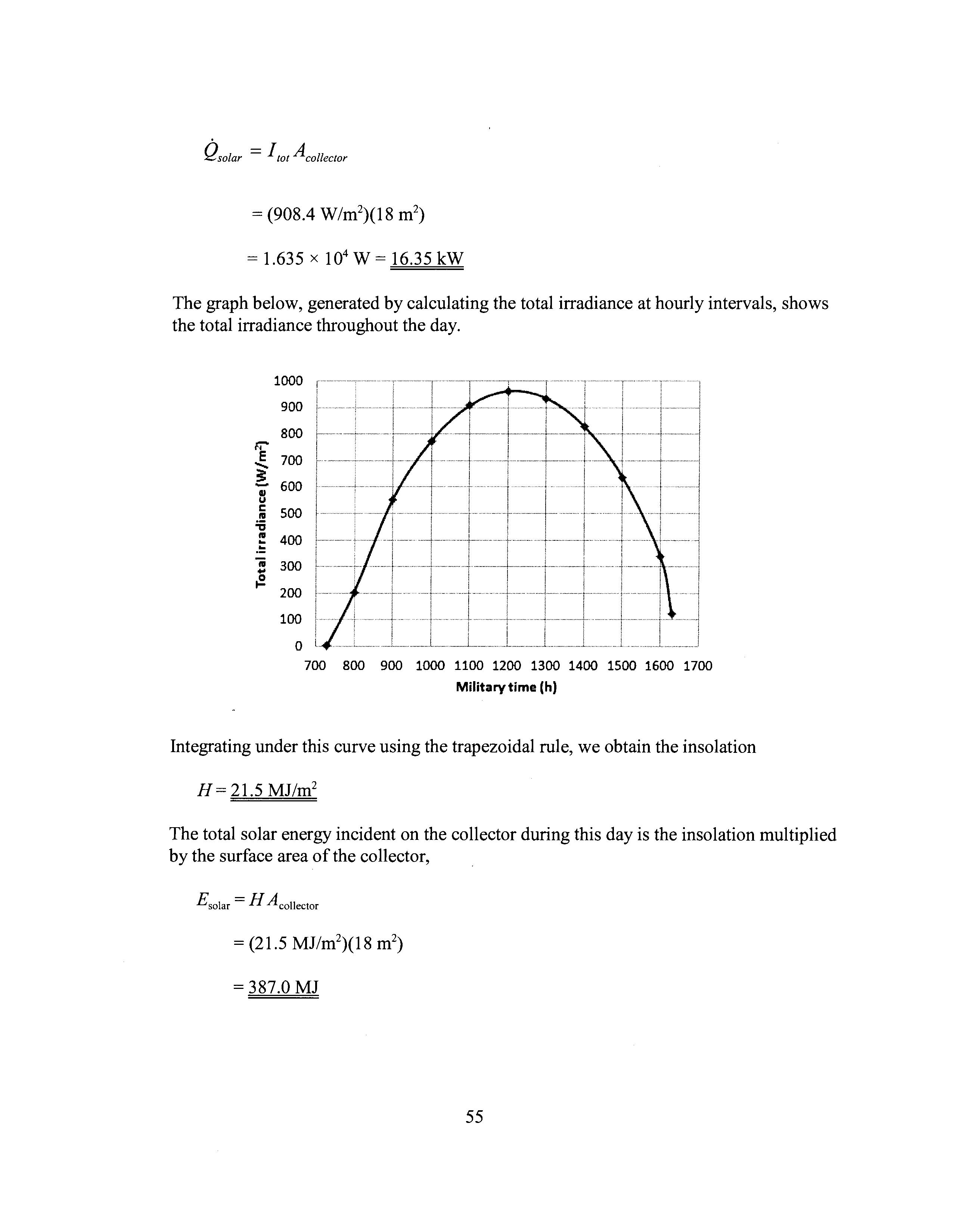
IIntegrating under this curve using the trapezoidal rule, we obtain the insolation
H = 21.5 MJ/m2
The total solar energy incident on the collector during this day is the insolation multiplied by the surface area of the collector,
£solar = H Acollector = 387.0 MJ

Solution check
No errors are detected.
Discussion
The collector cannot generate more than 387.0 MJ of energy during this day.
2.9 Problem statement
The collector in Problem 2.6 has a surface area of 60 m 2 • Find the total solar power incident on the collector at 12:00 noon. Also, find the insolation and the total solar energy incident on the collector during the day.
Diagram

1 1 1 1 1
Assumptions
1. Sky is clear.
2. All quantities pertinent to the total solar irradiance are constant.
Governing equations
The governing equations are the same as those in Problem 2.4 plus the following:
Qsolar = ]tot Acollector
Esolar = H Acollector
Calculations
Using the governing equations in Problem 2.4, the total solar irradiance at 12:00 noon is
!tot= 983.5 W/m 2
Thus, the total solar power incident on the collector is
Qsolar = ]tot A collector
= 5.901 X 104 w = 59.01 kW
The graph below, generated by calculating the total irradiance at hourly intervals, shows the total irradiance throughout the day.
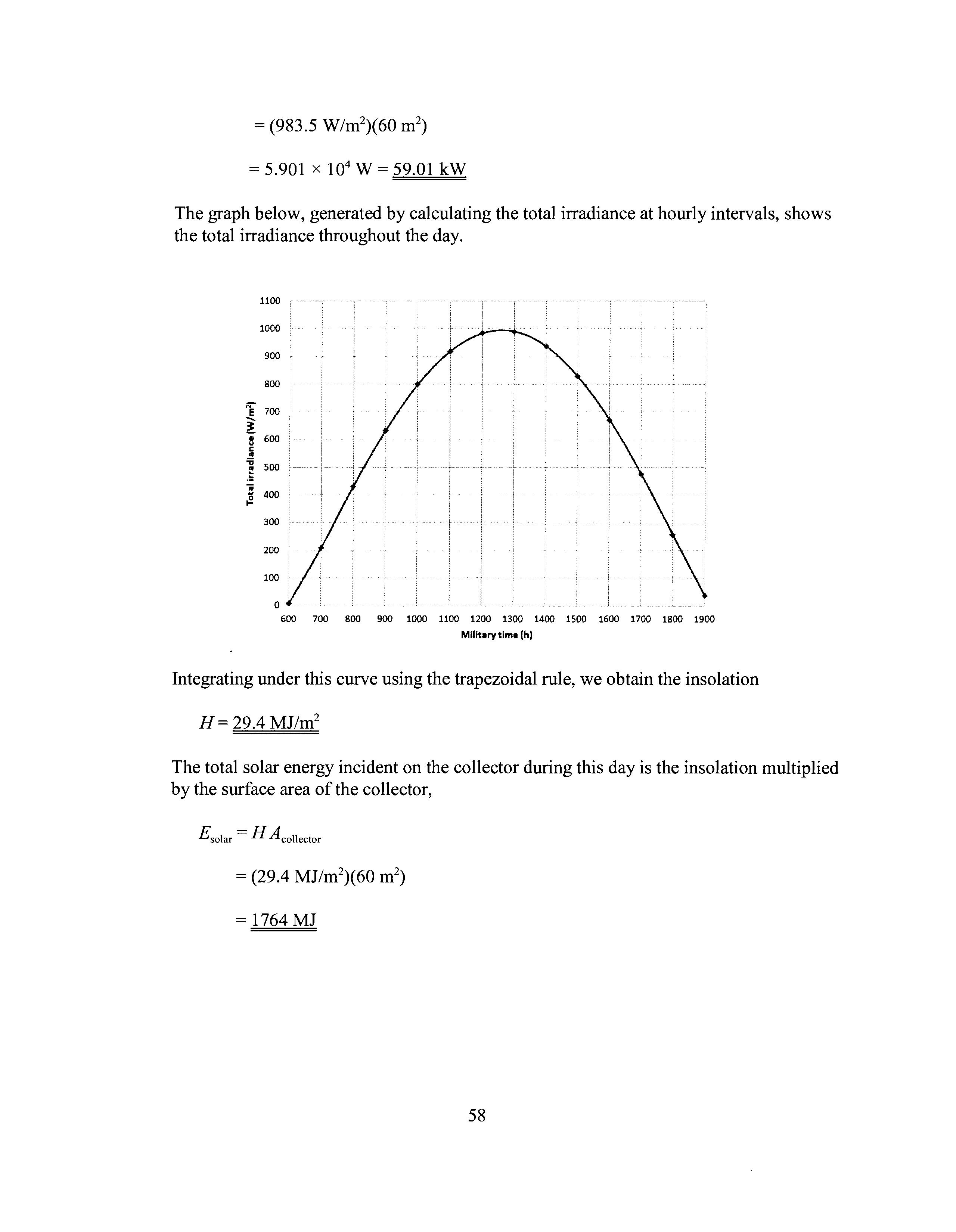
Integrating under this curve using the trapezoidal rule, we obtain the insolation
H= 29.4 MJ/m2
The total solar energy incident on the collector during this day is the insolation multiplied by the surface area of the collector,
£solar = H Acollector = 1764 MJ
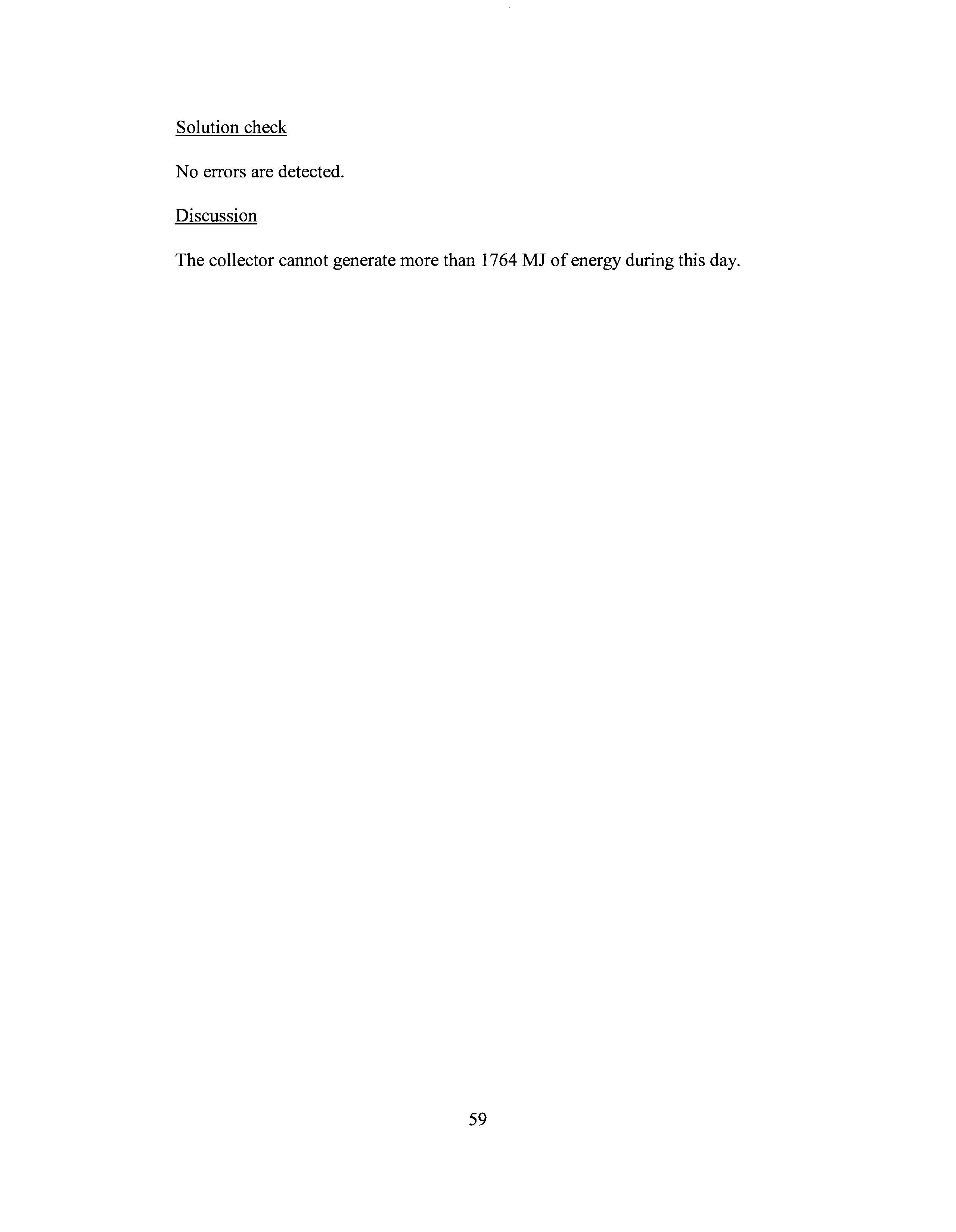
Solution check
No errors are detected.
Discussion
The collector cannot generate more than 1764 MJ of energy during this day.
2.10 Problem statement
A manufacturing plant in San Jose, California has a roof-mounted photovoltaic solar panel that measures 16 m x 30 m. The panel is horizontal and has an efficiency of 0.18. How much electrical energy does the panel generate on December 21?
Diagram
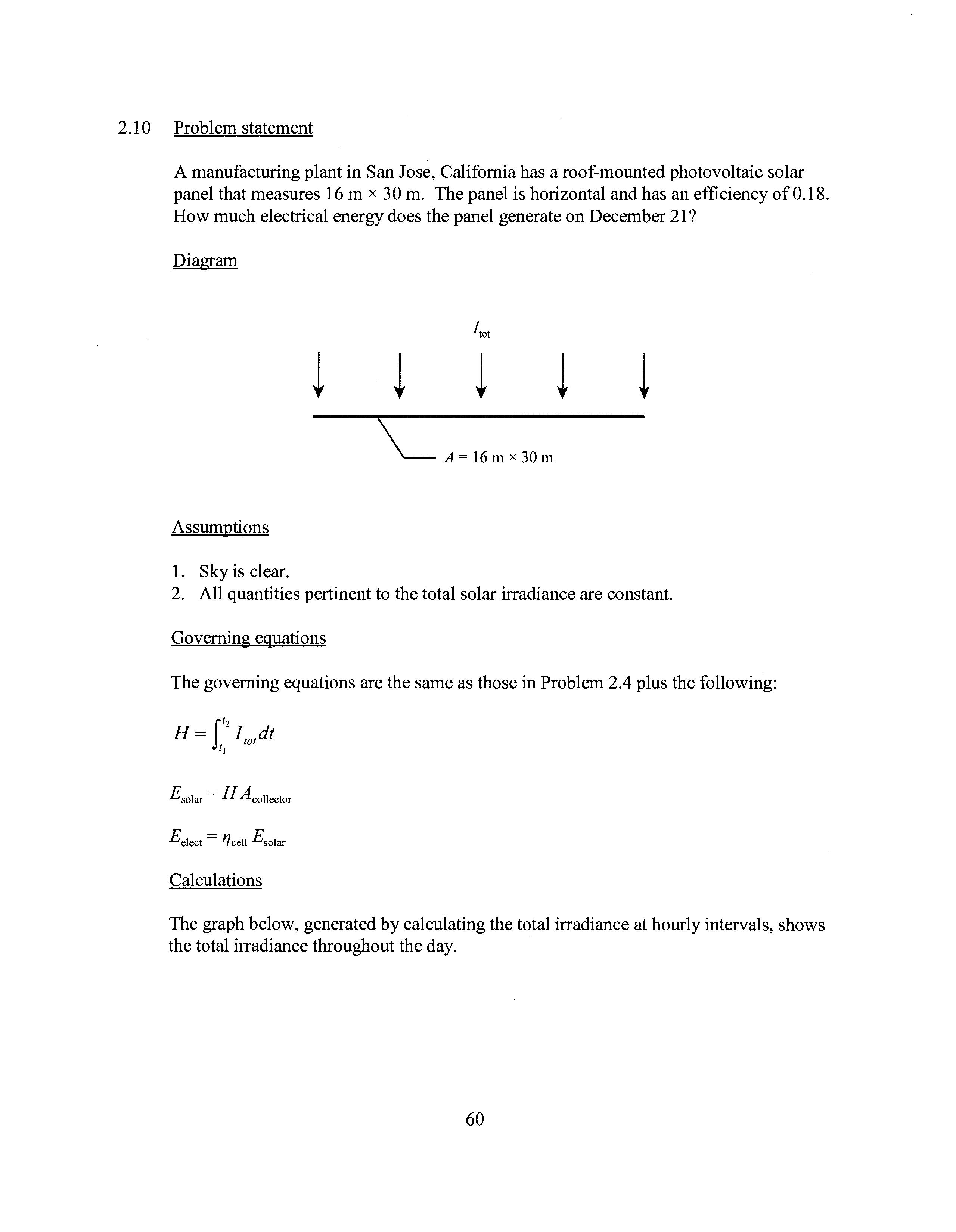
Assumptions
1. Sky is clear.
2. All quantities pertinent to the total solar irradiance are constant.
Governing equations
The governing equations are the same as those in Problem 2.4 plus the following:
£solar = H Acollector
£elect = 11cell £solar
Calculations
The graph below, generated by calculating the total irradiance at hourly intervals, shows the total irradiance throughout the day.
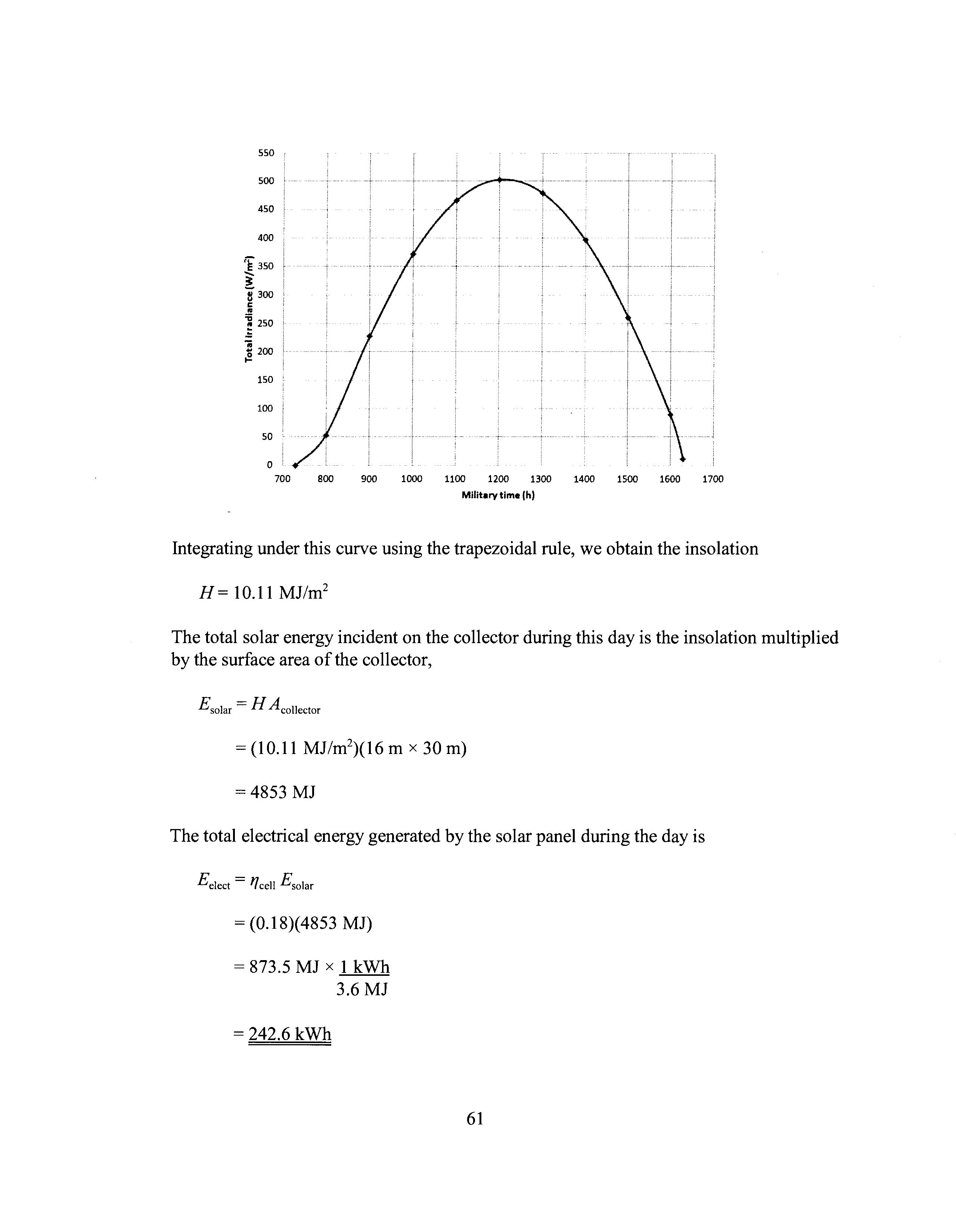
Integrating under this curve using the trapezoidal rule, we obtain the insolation
H= 10.11 MJ/m 2
The total solar energy incident on the collector during this day is the insolation multiplied by the surface area of the collector,
Esolar = H Acollector
= (10.11 MJ/m2 )(16 m x 30m)
= 4853 MJ
The total electrical energy generated by the solar panel during the day is
Eelect = IJcell Esolar
= (0.18)( 4853 MJ)
= 873.5 MJ X 1 kWh 3.6MJ
= 242.6 kWh
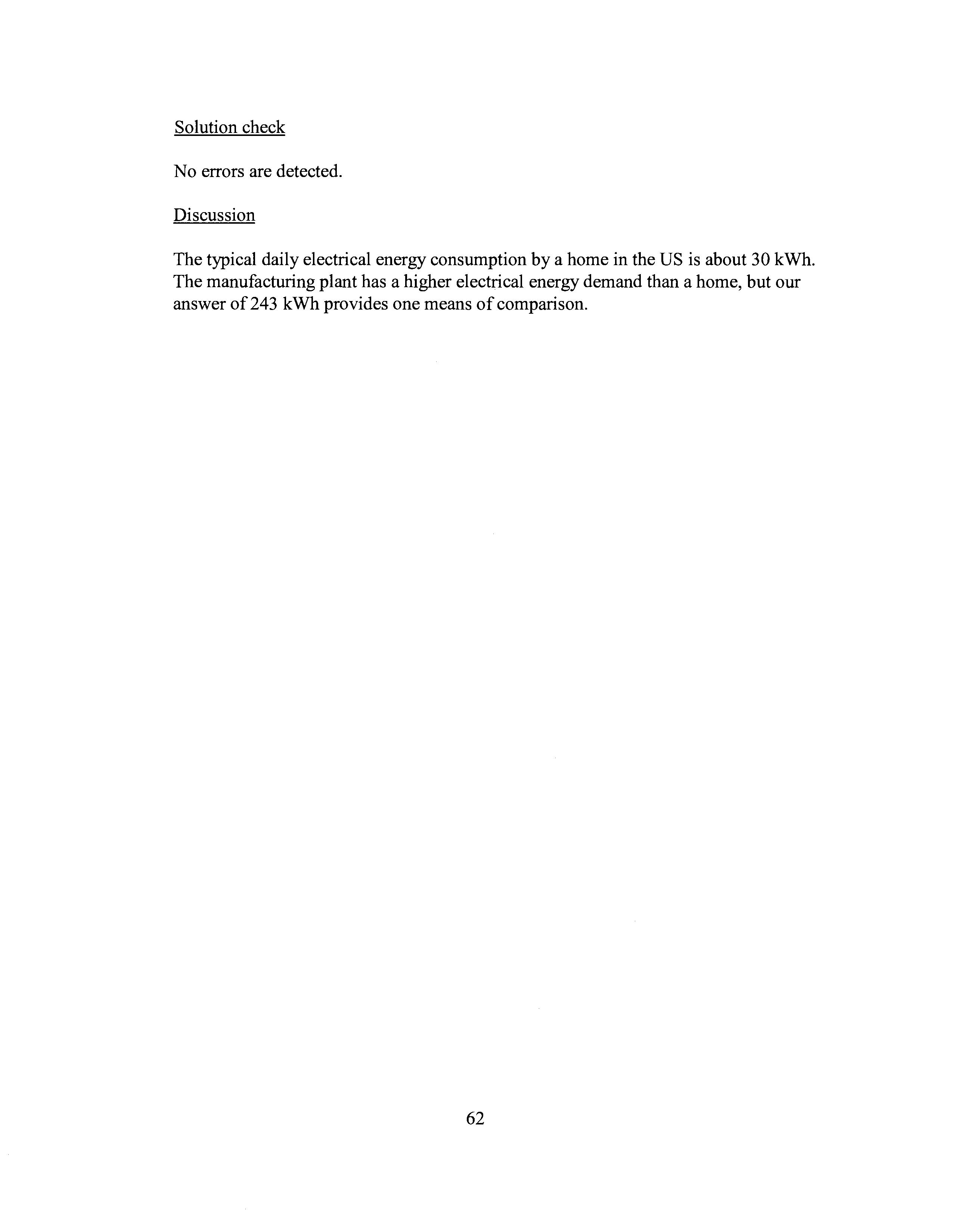
No errors are detected.
Discussion
The typical daily electrical energy consumption by a home in the US is about 30 kWh. The manufacturing plant has a higher electrical energy demand than a home, but our answer of243 kWh provides one means of comparison.
2.11 Problem statement
A residential solar system in Montgomery, Alabama incorporates a photovoltaic solar panel with a tilt angle of60°. The roof-mounted panel, which measures 20m 2 , faces due south and has an efficiency of 0.16. How much electrical energy does the panel generate on October 21?
Diagram
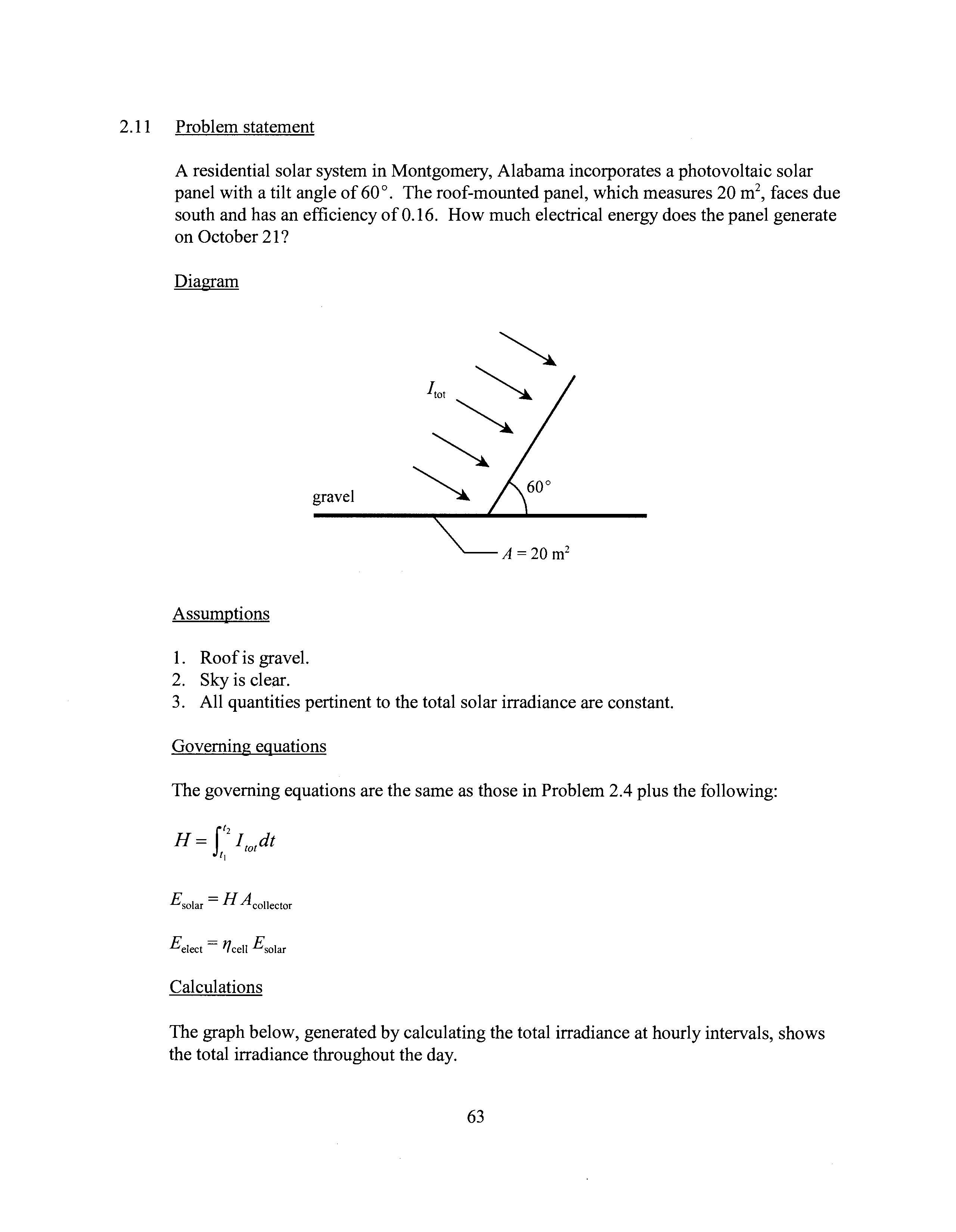
Assumptions
1. Roof is gravel.
2. Sky is clear.
3. All quantities pertinent to the total solar irradiance are constant.
Governing equations
The governing equations are the same as those in Problem 2.4 plus the following:
£solar = H Acollector
£elect= Yfcell £solar
Calculations
The graph below, generated by calculating the total irradiance at hourly intervals, shows the total irradiance throughout the day.
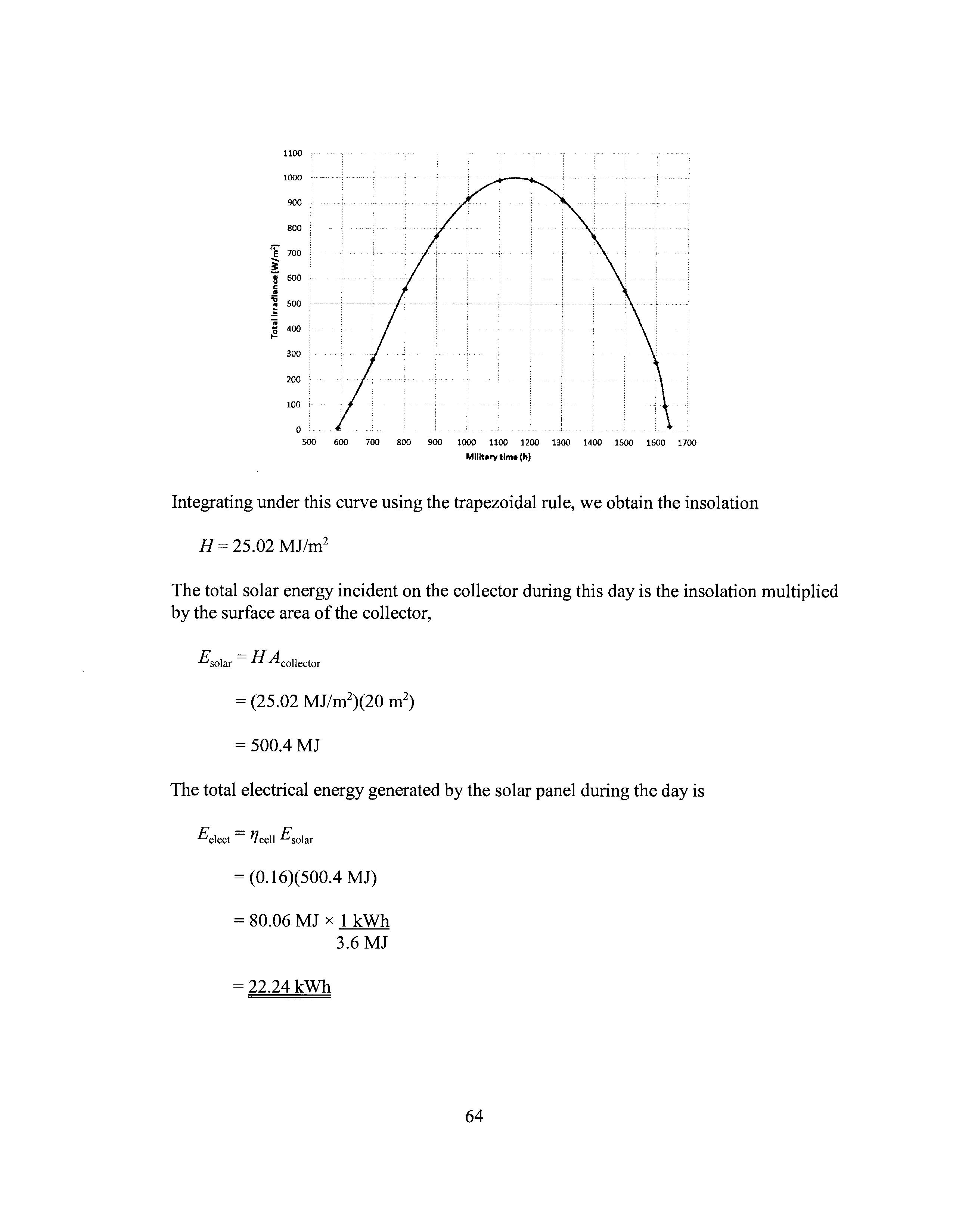
Integrating under this curve using the trapezoidal rule, we obtain the insolation
H = 25.02 MJ/m2
The total solar energy incident on the collector during this day is the insolation multiplied by the surface area of the collector,
£solar = H Acollector = 500.4 MJ
The total electrical energy generated by the solar panel during the day is
£elect = 'lcell £solar = (0.16)(500.4 MJ) = 80.06 MJ X 1 kWh 3.6MJ = 22.24 kWh

Solution check
No errors are detected.
Discussion
The typical daily electrical energy consumption by a home in the US is about 30 kWh. Hence, this photovoltaic system supplies over two-thirds of this amount.
2.12 Problem statement
A classroom building at a university in Raleigh, North Carolina has an array of photovoltaic solar panels on its roof for augmenting electrical power from the grid. The panels face due south and have a tilt angle and efficiency of 60° and 0.22, respectively. How much electrical energy do the panels generate on December 21 for a total panel surface area of 600 m 2 ?
Diagram
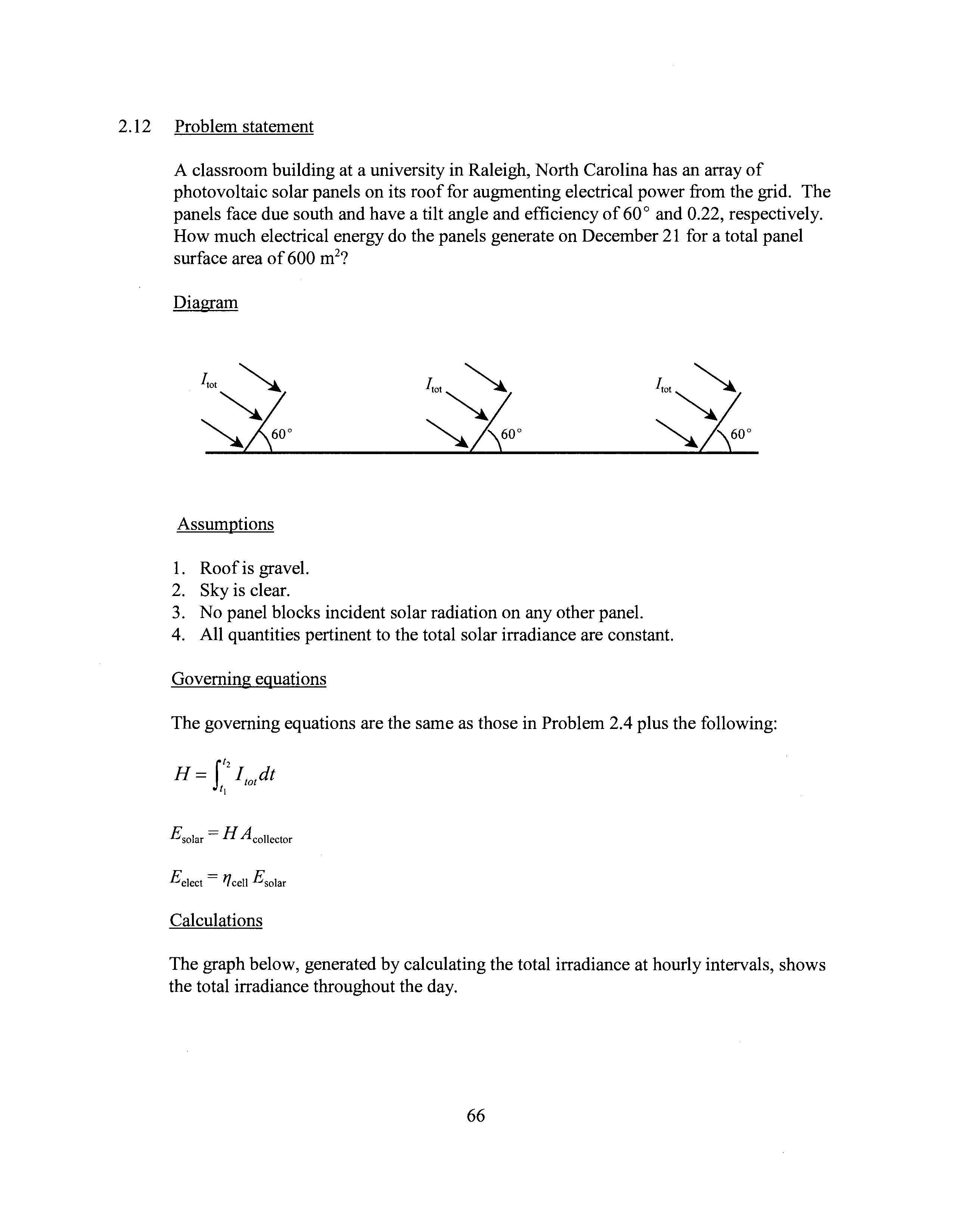
Assumptions
1. Roof is gravel.
2. Sky is clear.
3. No panel blocks incident solar radiation on any other panel.
4. All quantities pertinent to the total solar irradiance are constant.
Governing equations
The governing equations are the same as those in Problem 2.4 plus the following:
£solar = H Acollector
Eelect = '1cell Esolar
Calculations
The graph below, generated by calculating the total irradiance at hourly intervals, shows the total irradiance throughout the day.
Integrating under this curve using the trapezoidal rule, we obtain the insolation
H = 22.4 MJ/m2
The total solar energy incident on the panels during this day is the insolation multiplied by the total surface area of the panels,
Esolar = H Acollector
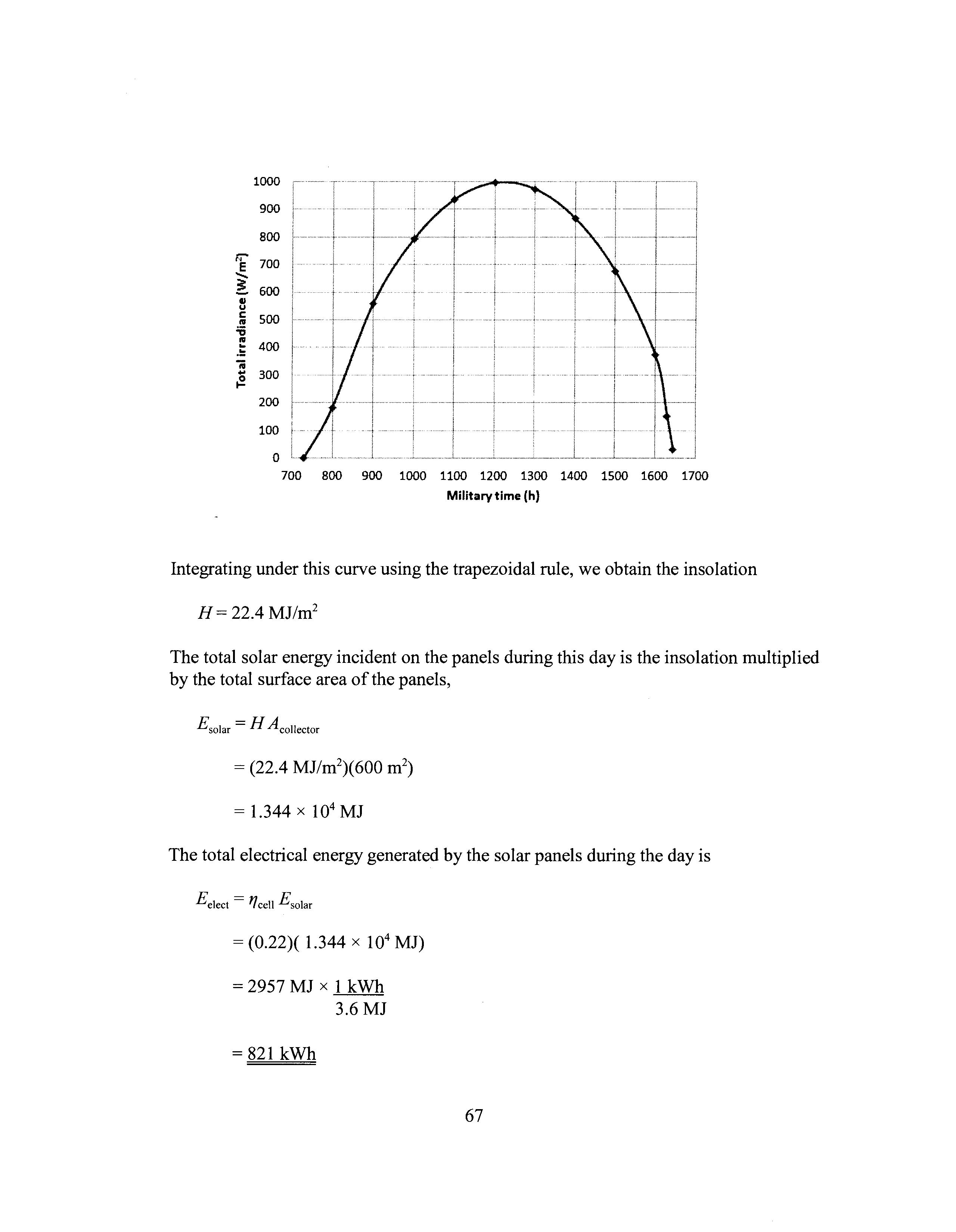
The total electrical energy generated by the solar panels during the day is
Eelect = 'lcell Esolar
= (0.22)( 1.344 X 104 MJ)
= 2957 MJ X 1 kWh 3.6MJ
= 821 kWh

Solution check
No errors are detected.
Discussion
Photovoltaic solar panels on roof tops of college and university buildings are becoming more common as these institutions incorporate green policies into their operations.
2.13 Problem statement
Derive Equation (2.18).
Diagram
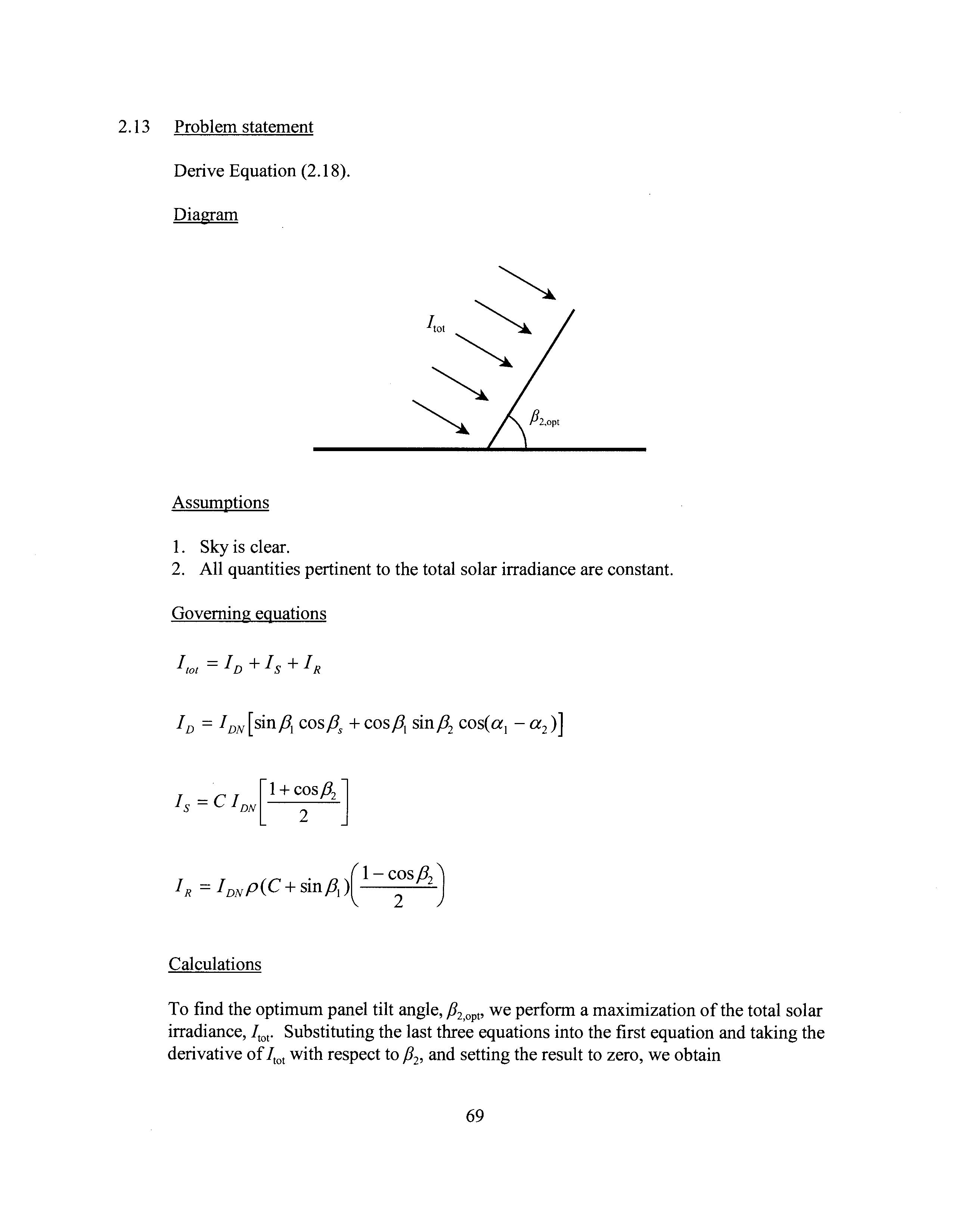
Assumptions
1. Sky is clear.
2. All quantities pertinent to the total solar irradiance are constant.
Governing equations
I = C I [ 1 + cos j32 J S DN 2
Calculations
To find the optimum panel tilt angle, /J2,opt' we perform a maximization ofthe total solar irradiance, !tot· Substituting the last three equations into the first equation and taking the derivative of !tot with respect to /]2, and setting the result to zero, we obtain
where the term / 0 N has divided out. After simplification, this relation reduces to
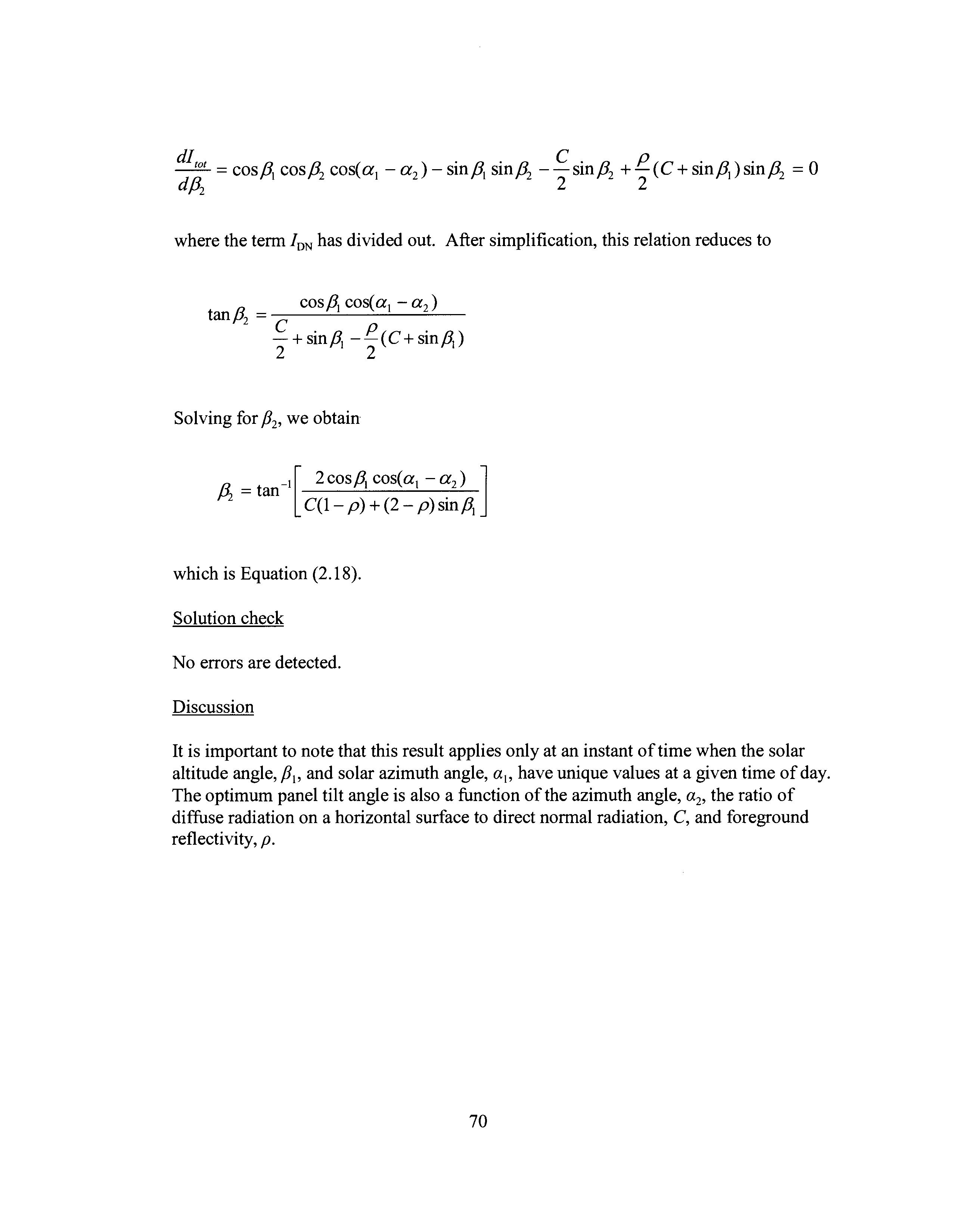
Solving for {J2 , we obtain fJ 1[ 2cosA_ cos(a1 - a 2 ) ] 2 =tan C(l- p) + (2- p)sinA
which is Equation (2.18).
Solution check
No errors are detected.
Discussion
It is important to note that this result applies only at an instant of time when the solar altitude angle, {J 1, and solar azimuth angle, a 1, have unique values at a given time of day. The optimum panel tilt angle is also a function of the azimuth angle, a2 , the ratio of diffuse radiation on a horizontal surface to direct normal radiation, C, and foreground reflectivity, p.
2.14 Problem statement
Using Equation (2.18), calculate the optimum tilt angle for a solar panel in Salt Lake City, Utah at 1:00pm on January 21. The panel faces a south-southwest direction, and the foreground is snow.
Diagram
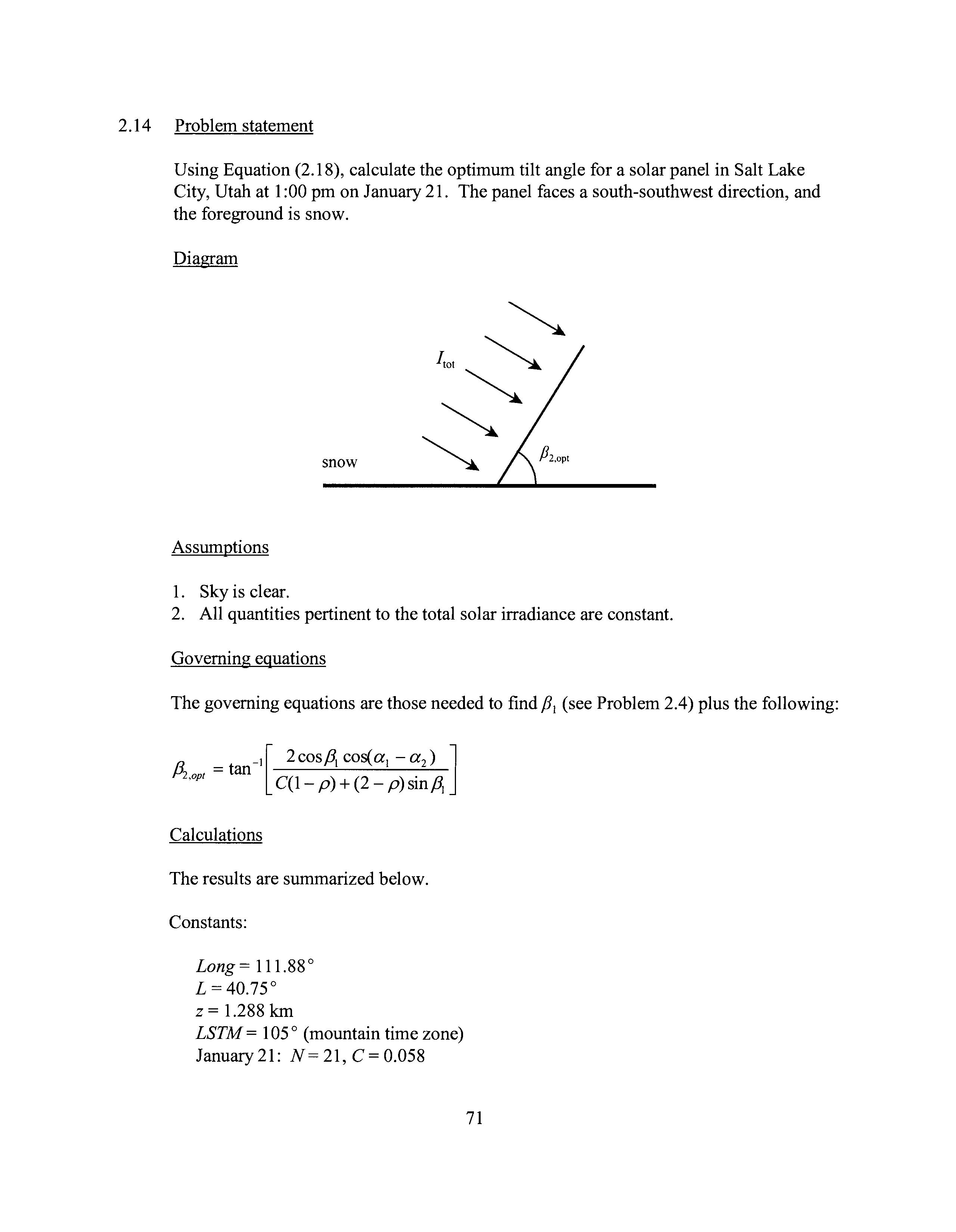
Assumptions
1. Sky is clear.
2. All quantities pertinent to the total solar irradiance are constant.
Governing equations
The governing equations are those needed to find /] 1 (see Problem 2.4) plus the following:
f3: _ _ 1 [ 2cosfJ1 cos(a1 - a 2 ) ] 2ot-tan ,op C(l-p)+(2-p)sinfiJ
Calculations
The results are summarized below.
Constants:
Long= 111.88°
L = 40.75°
z = 1.288 km
LSTM = 105 o (mountain time zone) January21: N=21, C=0.058
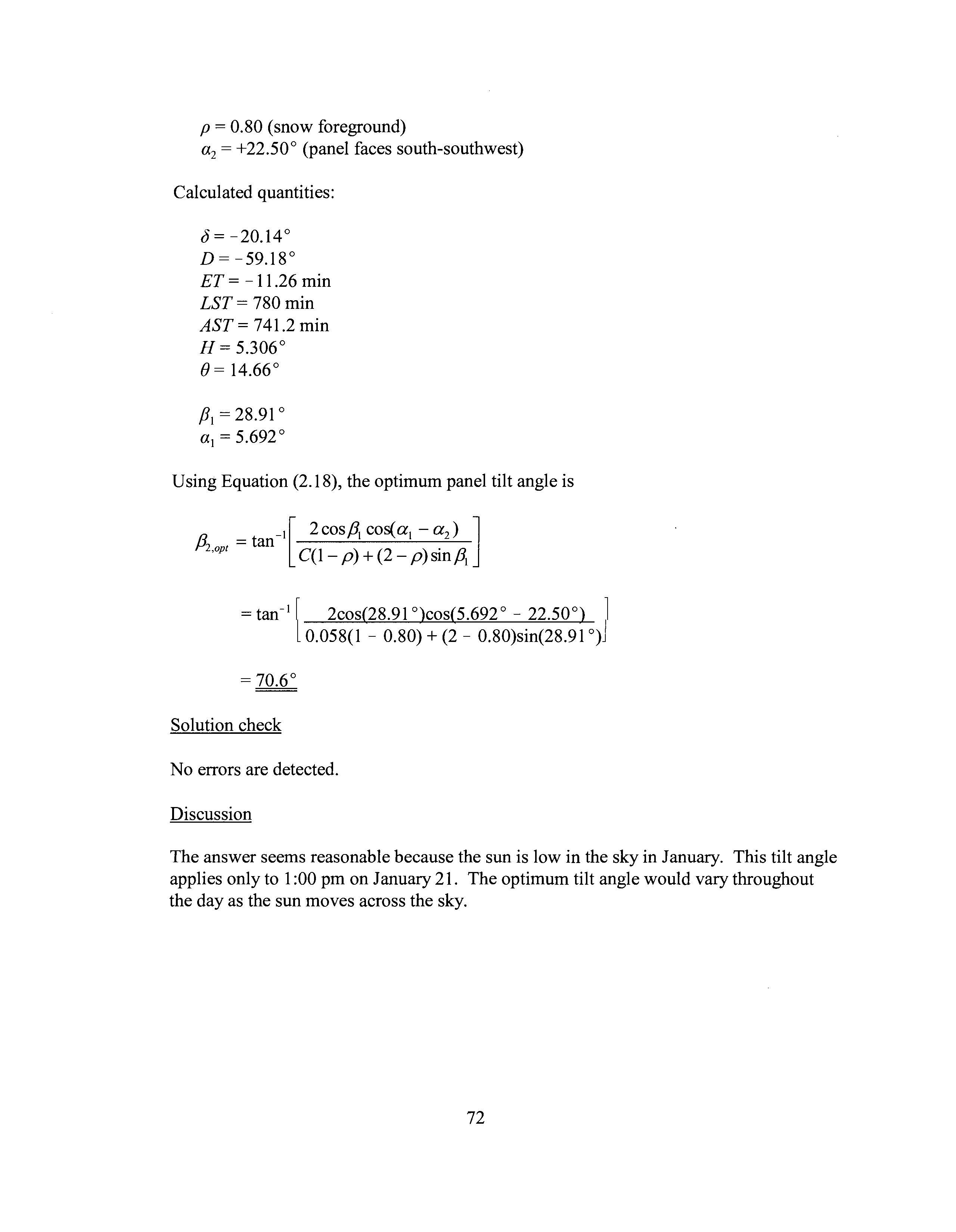
p = 0.80 (snow foreground)
a 2 = +22.50° (panel faces south-southwest)
Calculated quantities:
b= -20.14°
D = -59.18°
ET = - 11.26 min
LST= 780min
AST = 741.2 min
H= 5.306°
() = 14.66°
/], = 28.91°
a 1 = 5.692°
Using Equation (2.18), the optimum panel tilt angle is
a _ _1[ 2cosA cos(a1 -a2 ) ]
Plot-tan ,'P C(1-p)+(2-p)sinfJ1
=tan-! ll 2cos(28.91 °)cos(5.692 ° - 22.50°) Jl 0.058(1 - 0.80) + (2 - 0.80)sin(28.91 °)
= 70.6°
Solution check
No errors are detected.
Discussion
The answer seems reasonable because the sun is low in the sky in January. This tilt angle applies only to 1:00 pm on January 21. The optimum tilt angle would vary throughout the day as the sun moves across the sky.
2.15 Problem statement
A photovoltaic solar panel is to be installed on the roof of a home in Phoenix, Arizona. The roofhas a 4 on 12 pitch, and one side of the roof faces south-southeast. For November 21, find the optimum angle ofthe solar panel with respect to the roof.
Diagram
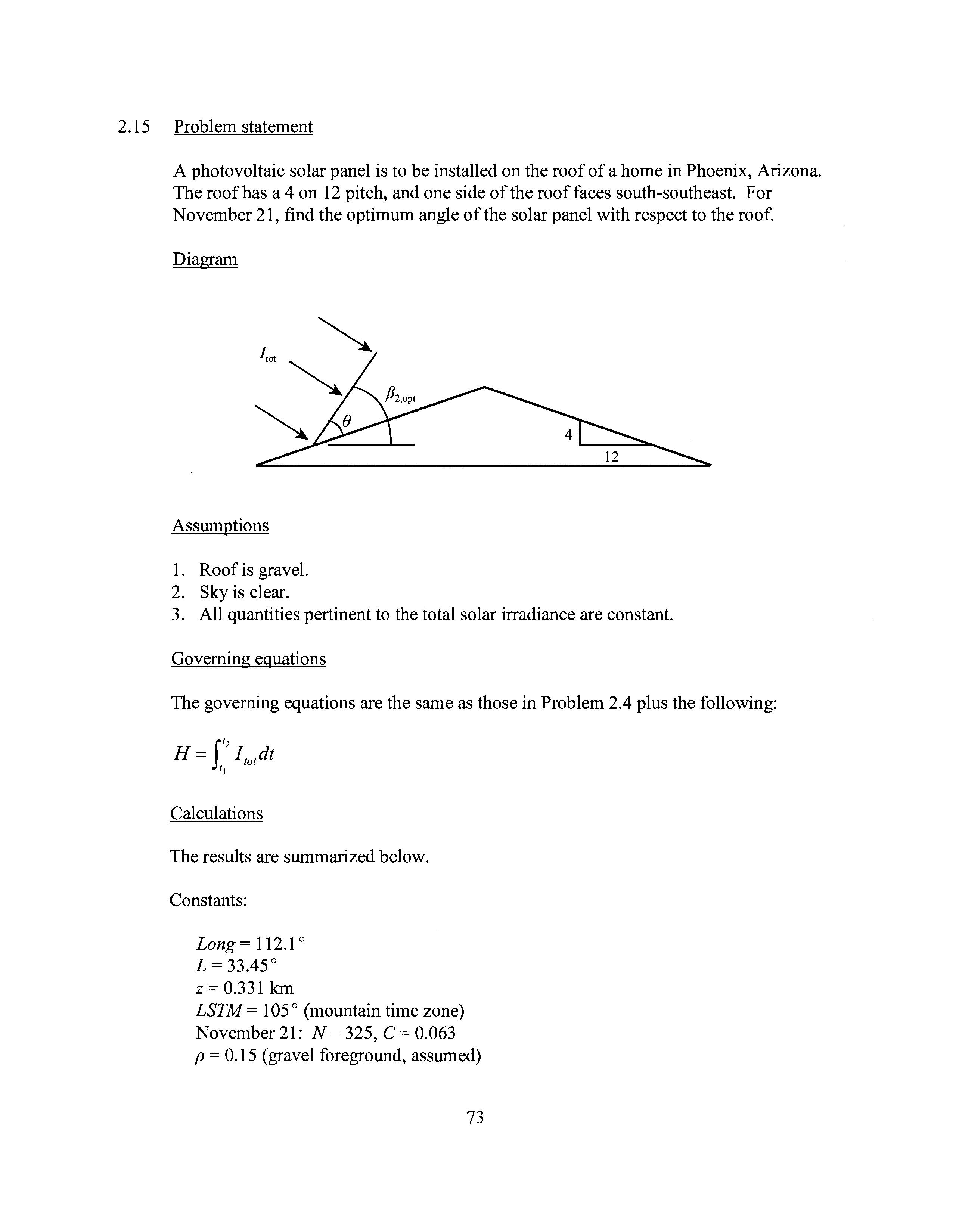
Assumptions
1. Roof is gravel.
2. Sky is clear.
3. All quantities pertinent to the total solar irradiance are constant.
Governing equations
The governing equations are the same as those in Problem 2.4 plus the following:
Calculations
The results are summarized below.
Constants:
Long= 112.1 o
L = 33.45°
z = 0.331 km
LSTM= 105° (mountain time zone)
November 21: N = 325, C = 0.063
p = 0.15 (gravel foreground, assumed)
a2 = -22.50° (panel faces south-southeast)
In order to find the optimum panel tilt angle for November 21, the total solar insolation as a function of tilt angle is graphed below.
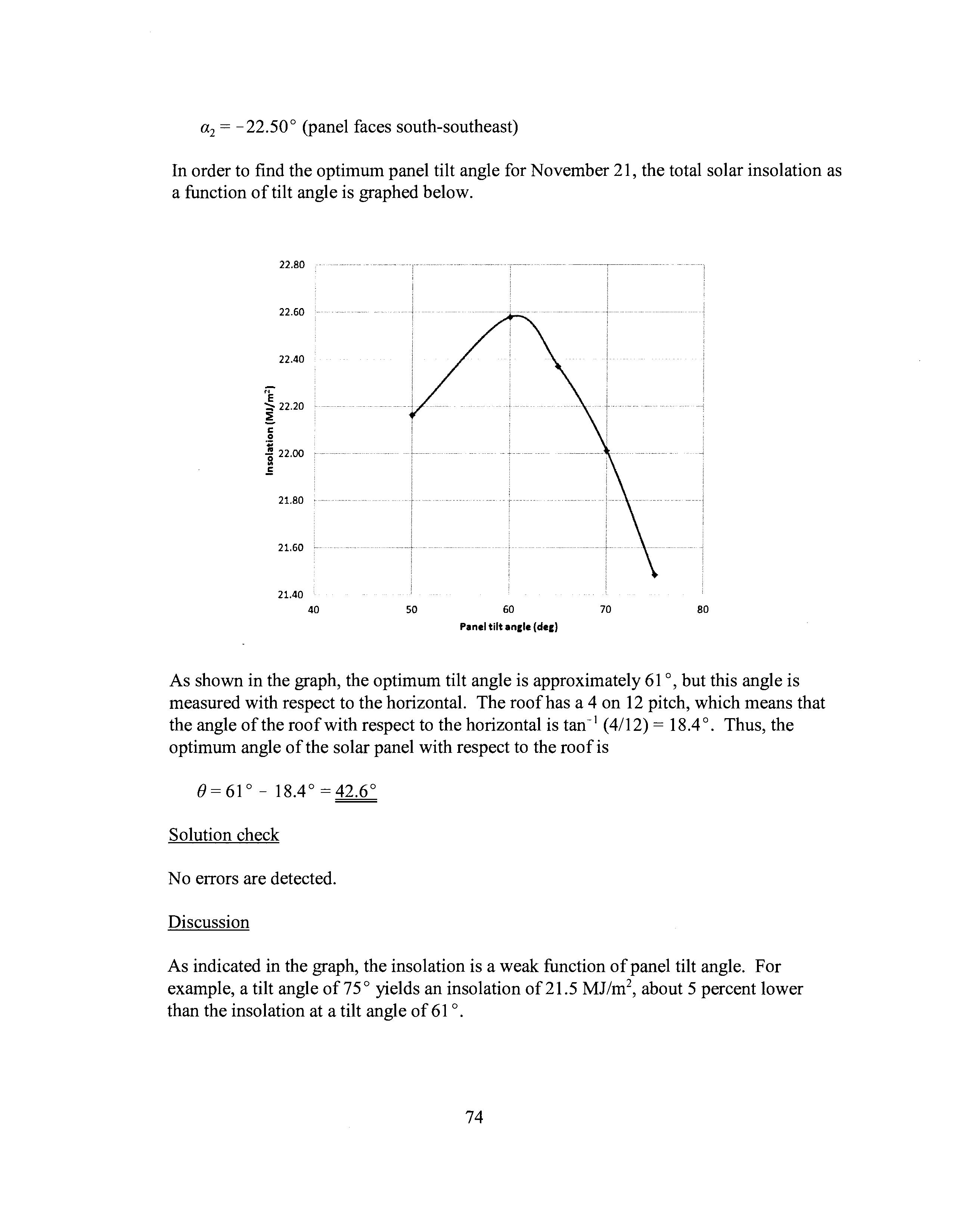
As shown in the graph, the optimum tilt angle is approximately 61 o, but this angle is measured with respect to the horizontal. The roofhas a 4 on 12 pitch, which means that the angle of the roof with respect to the horizontal is tan- 1 (4/12) = 18.4 o. Thus, the optimum angle of the solar panel with respect to the roof is
Solution check
No errors are detected.
Discussion
As indicated in the graph, the insolation is a weak function of panel tilt angle. For example, a tilt angle of75° yields an insolation of21.5 MJ/m 2 , about 5 percent lower than the insolation at a tilt angle of 61 o.
2.16 Problem statement
An office complex in San Antonio, Texas has a roof-mounted photovo1taic solar panel that measures 24 m x 36 m. The panel is horizontal and has an efficiency of 0.22. How much electrical energy does the panel generate on July 21?
Diagram
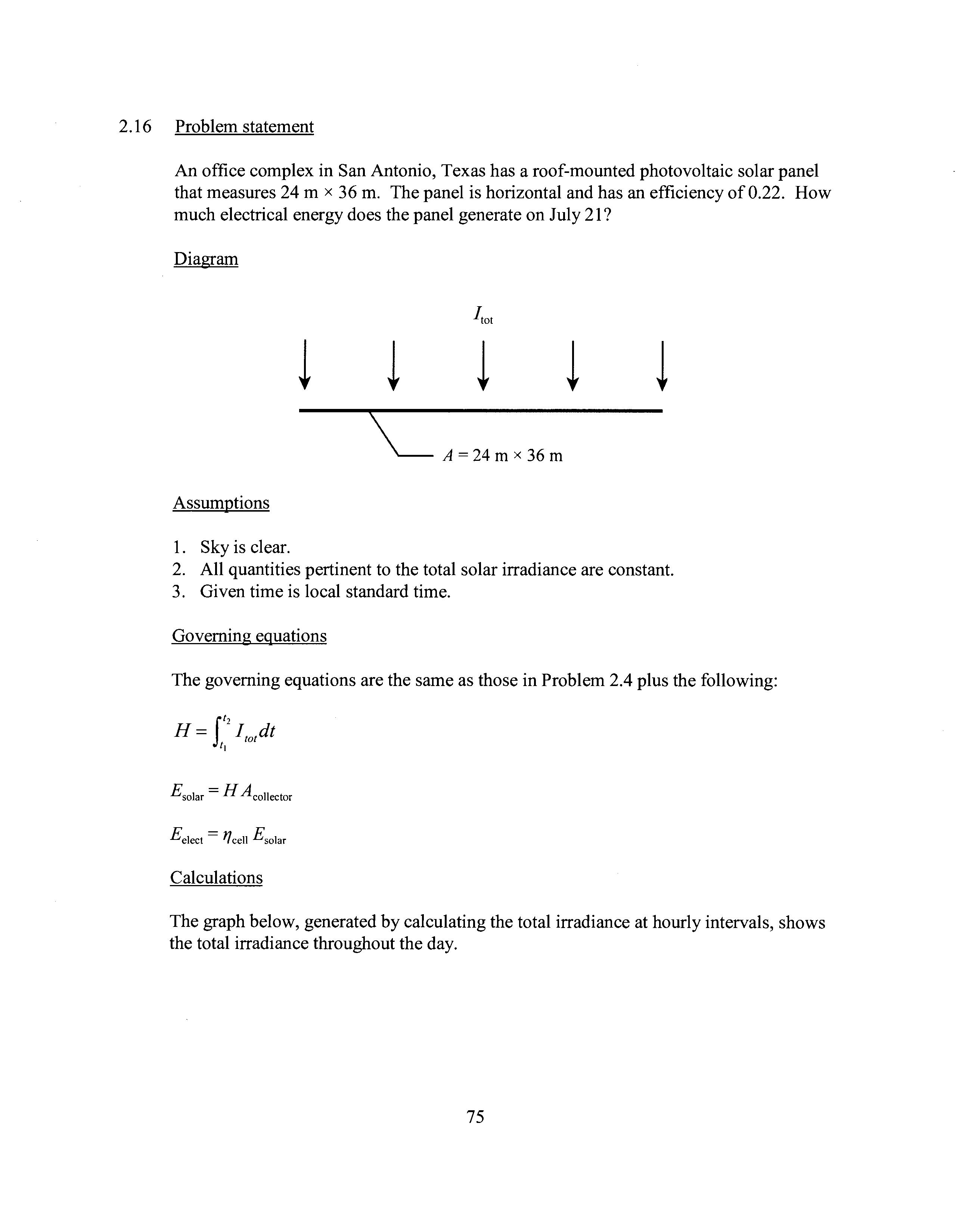
Assumptions
1. Sky is clear.
2. All quantities pertinent to the total solar irradiance are constant.
3. Given time is local standard time.
Governing equations
The governing equations are the same as those in Problem 2.4 plus the following:
£solar = H Acollector
£elect= 'lcell £solar
Calculations
The graph below, generated by calculating the total irradiance at hourly intervals, shows the total irradiance throughout the day.
Integrating under this curve using the trapezoidal rule, we obtain the insolation
H= 29.1 MJ/m 2
The total solar energy incident on the panel during this day is the insolation multiplied by the total surface area of the panel,
£solar = H Acollector
= (29.1 MJ/m 2)(24 m x 36m)
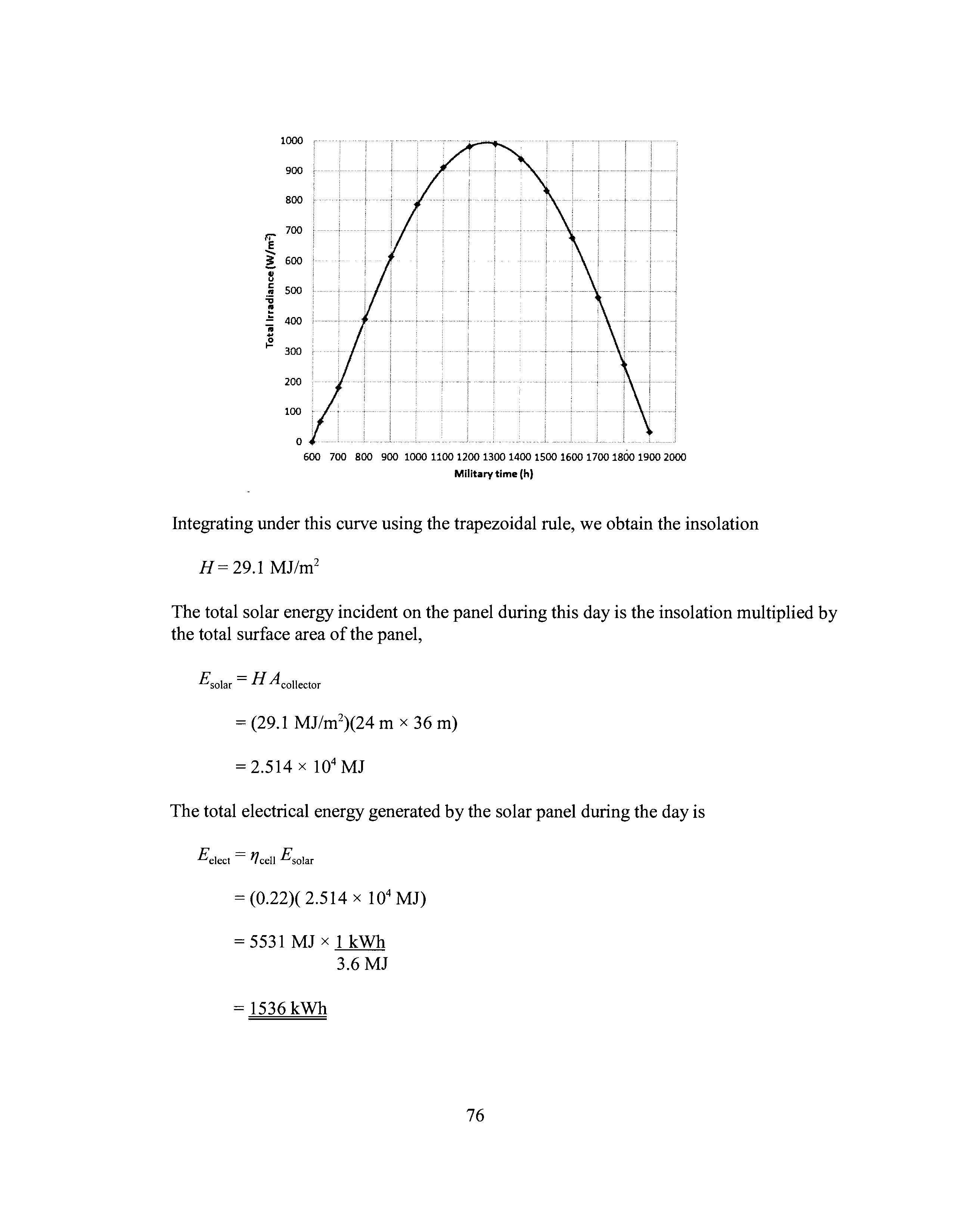
The total electrical energy generated by the solar panel during the day is
£elect = '1cell £solar
= (0.22)( 2.514 X 104 MJ) = 5531 MJ X 1 kWh
3.6MJ
= 1536 kWh

Solution check
No errors are detected.
Discussion
It is becoming more common for office buildings to incorporate photovoltaic solar panels into their roof tops to augment electrical power from the grid.
2.17 Problem statement
A home owner in Sacramento, California wishes to install photovoltaic solar panels on his south-facing roof. The pitch and reflectivity ofthe roof are 12 on 12 and 0.2, respectively. If the efficiency of the panels is 0.18, how much electrical energy can the home owner expect to generate on December 31 ifhe mounts the panels flat on the roof? The total surface area of the panels is 70 m 2 •
Diagram
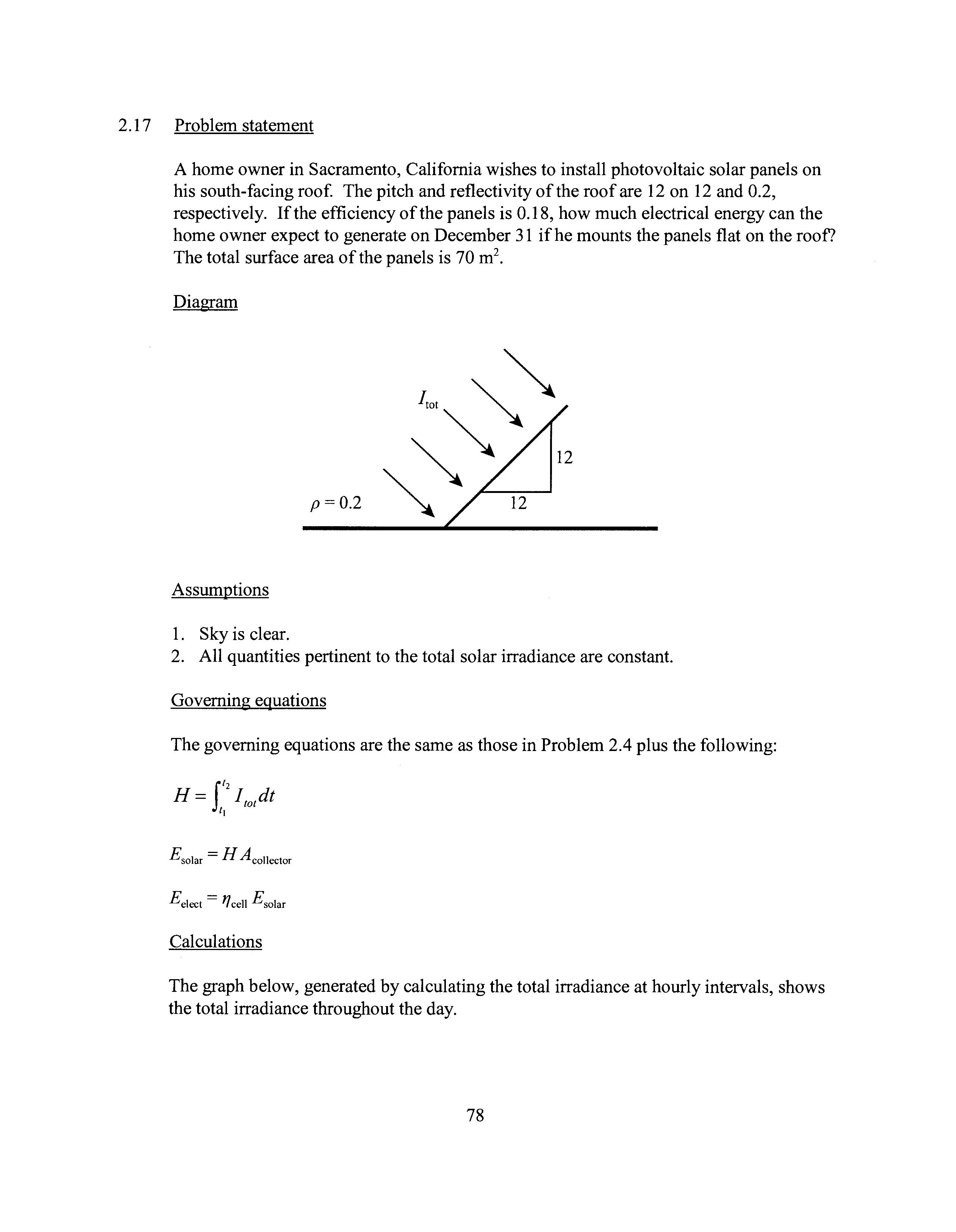
Assumptions
1. Sky is clear.
2. All quantities pertinent to the total solar irradiance are constant.
Governing equations
The governing equations are the same as those in Problem 2.4 plus the following:
Esolar = H Acollector
Eelect = 1'/cell Esolar
Calculations
The graph below, generated by calculating the total irradiance at hourly intervals, shows the total irradiance throughout the day.
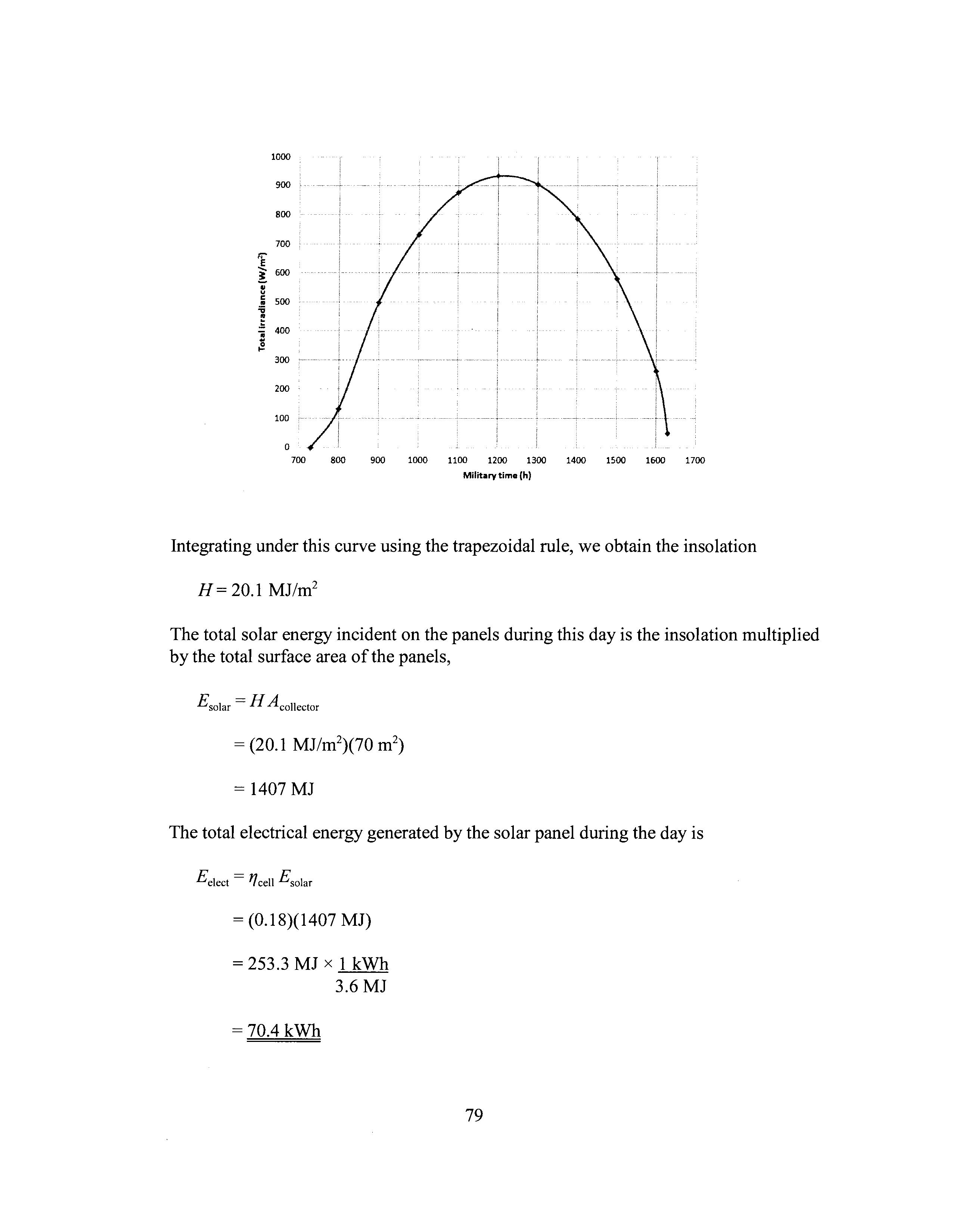
Integrating under this curve using the trapezoidal rule, we obtain the insolation
H = 20.1 MJ/m2
The total solar energy incident on the panels during this day is the insolation multiplied by the total surface area of the panels,
£solar = H Acollector = 1407 MJ
The total electrical energy generated by the solar panel during the day is
£elect= 'lcell £solar = (0.18)(1407 MJ) = 253.3 MJ X 1 kWh 3.6MJ = 70.4 kWh
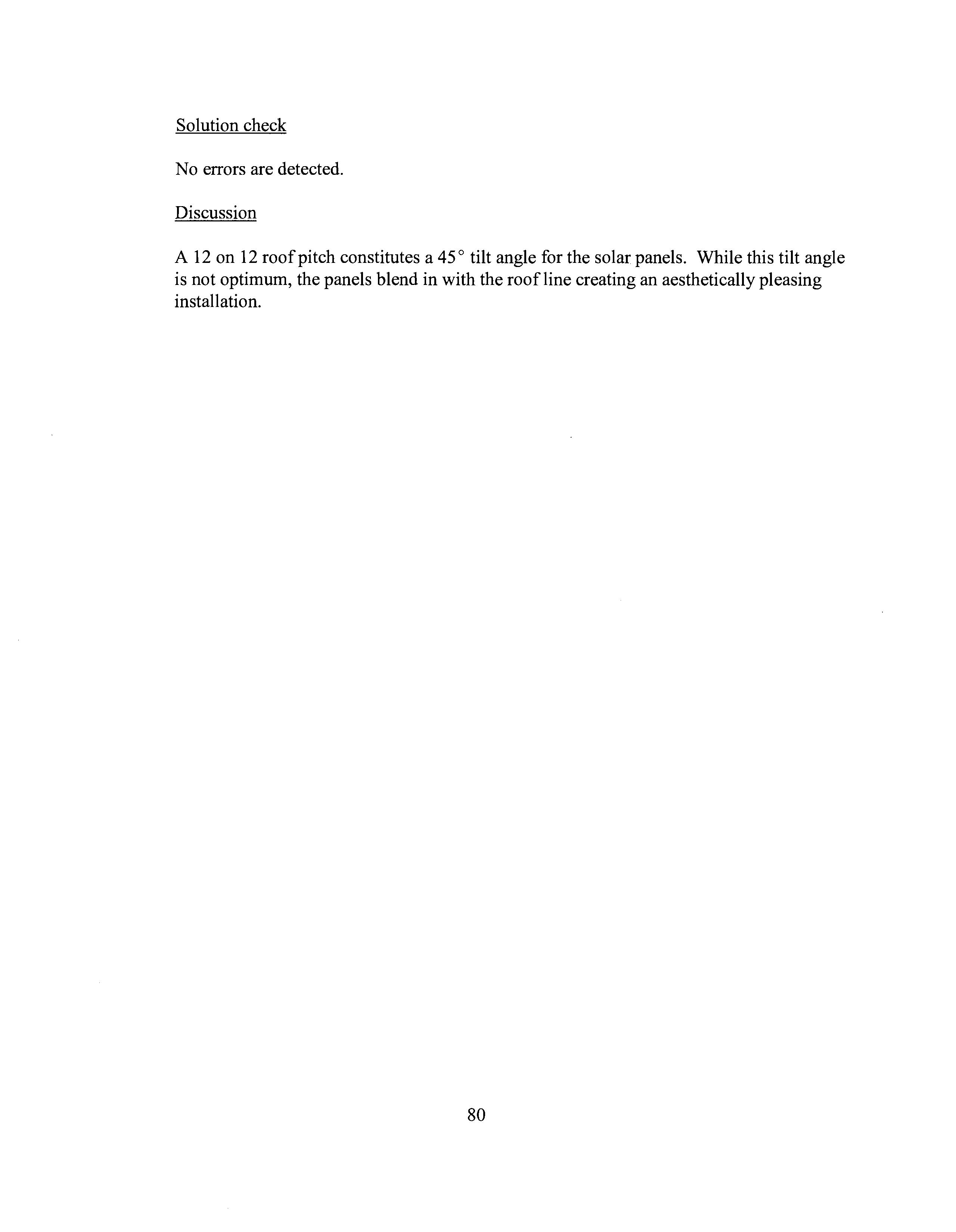
Solution check
No errors are detected.
Discussion
A 12 on 12 roof pitch constitutes a 45° tilt angle for the solar panels. While this tilt angle is not optimum, the panels blend in with the roof line creating an aesthetically pleasing installation.
2.18 Problem statement
Work Problem 2.17 for the optimum panel tilt angle for December 31.
Diagram
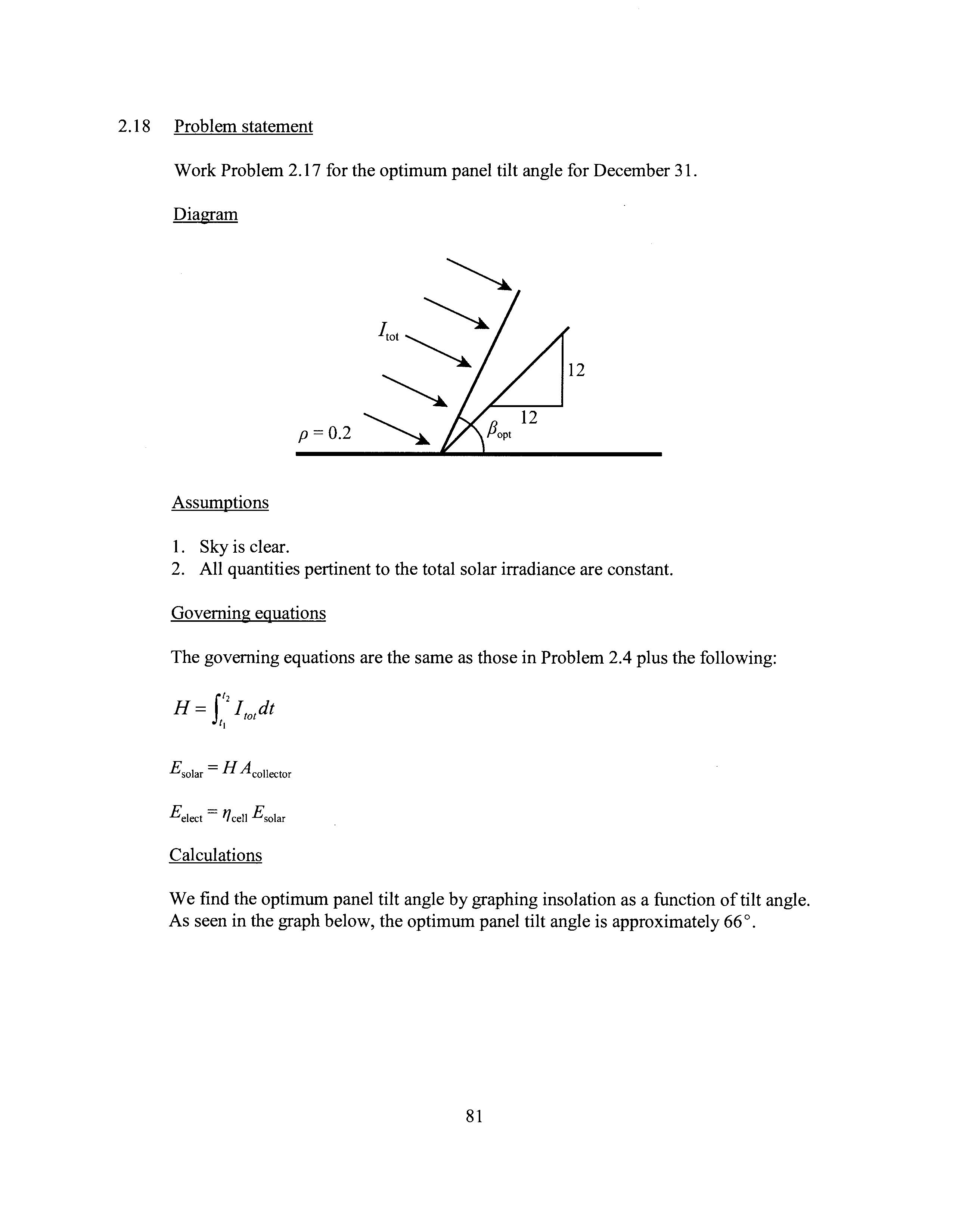
Assumptions
1. Sky is clear.
2. All quantities pertinent to the total solar irradiance are constant.
Governing equations
The governing equations are the same as those in Problem 2.4 plus the following:
£solar = H Acollector
£elect= IJcell £solar
Calculations
We find the optimum panel tilt angle by graphing insolation as a function of tilt angle. As seen in the graph below, the optimum panel tilt angle is approximately 66 o.
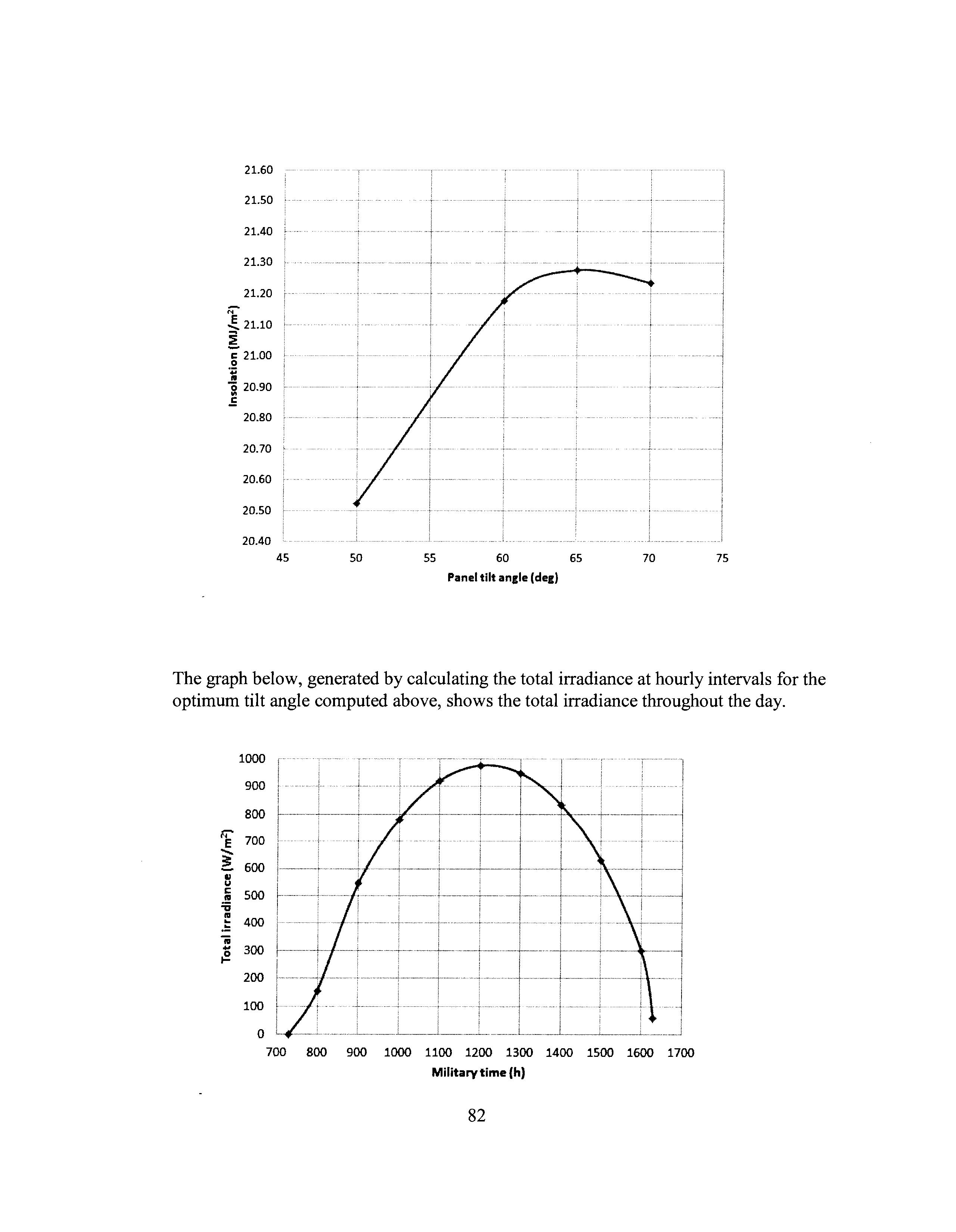
The graph below, generated by calculating the total irradiance at hourly intervals for the optimum tilt angle computed above, shows the total irradiance throughout the day.
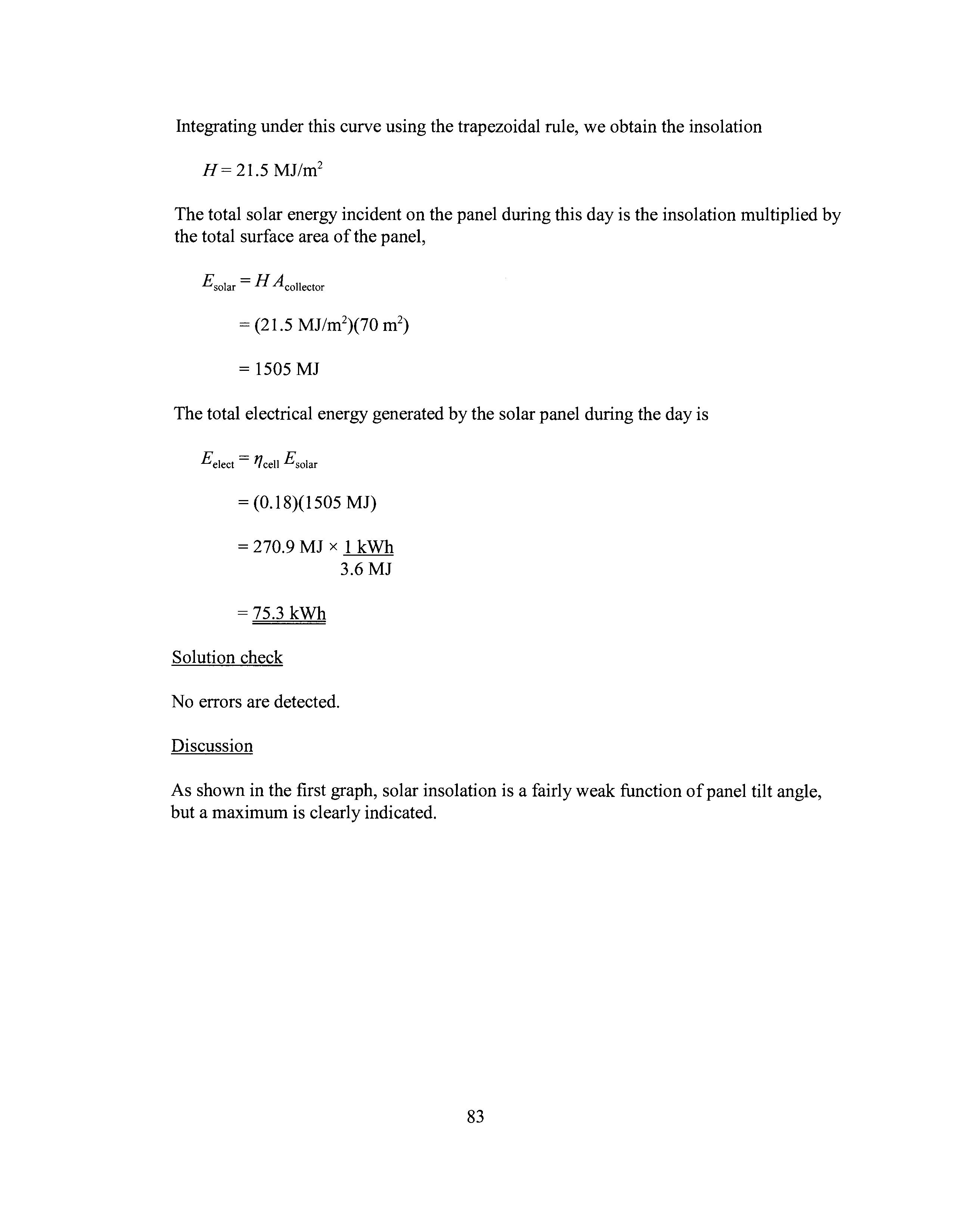
Integrating under this curve using the trapezoidal rule, we obtain the insolation
H = 21.5 MJ/m2
The total solar energy incident on the panel during this day is the insolation multiplied by the total surface area of the panel,
£solar = H Acollector = 1505 MJ
The total electrical energy generated by the solar panel during the day is
£elect= 'flcell £solar = (0.18)(1505 MJ) = 270.9 MJ X 1 kWh 3.6MJ
= 75.3 kWh
Solution check
No errors are detected.
Discussion
As shown in the first graph, solar insolation is a fairly weak function of panel tilt angle, but a maximum is clearly indicated.
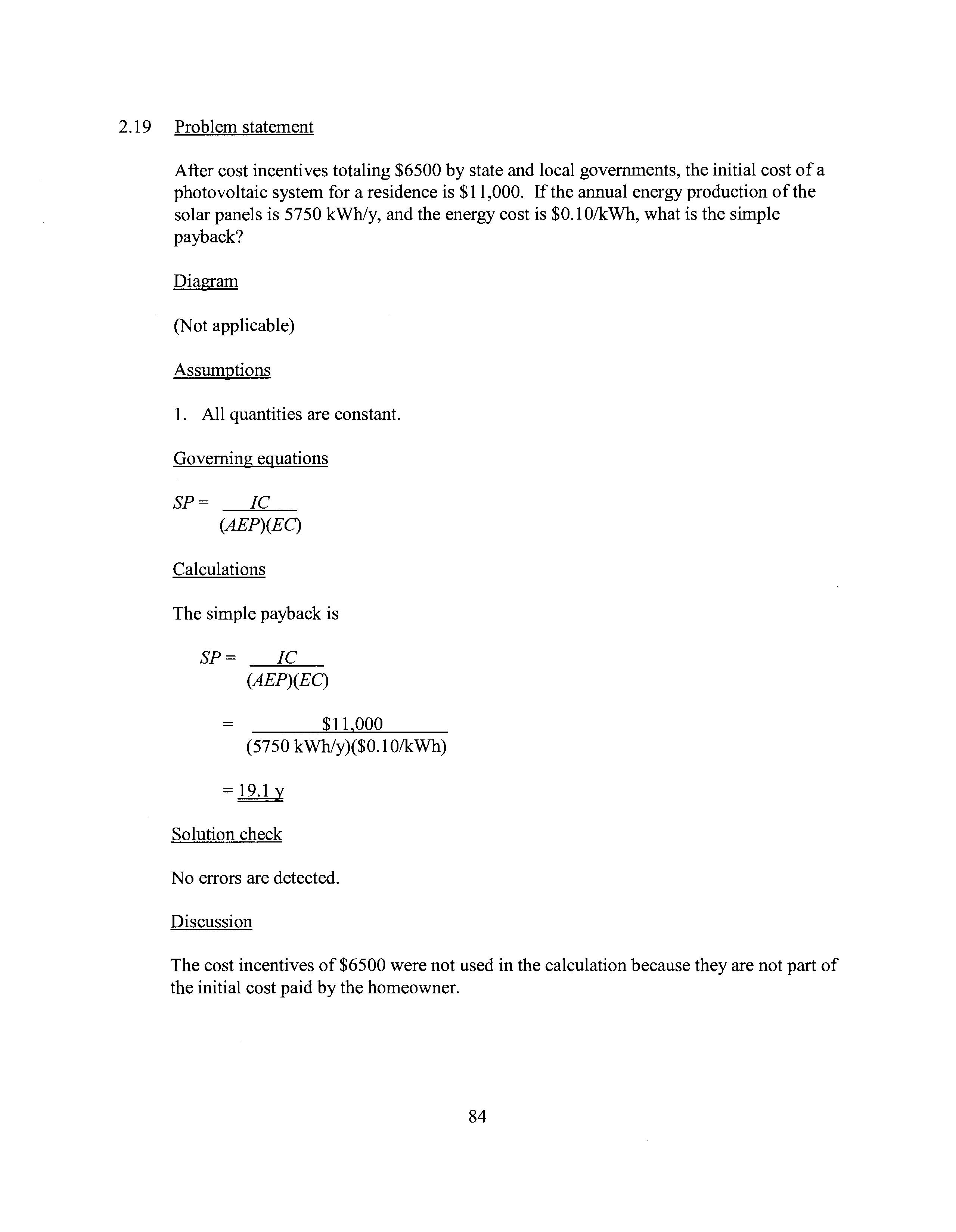
2.19 Problem statement
After cost incentives totaling $6500 by state and local governments, the initial cost of a photovoltaic system for a residence is $11,000. If the annual energy production of the solar panels is 5750 kWh/y, and the energy cost is $0.1 0/kWh, what is the simple payback?
Diagram (Not applicable)
Assumptions
1. All quantities are constant.
Governing equations
SP= IC (AEP)(EC)
Calculations
The simple payback is
SP= IC (AEP)(EC)
$11,000 (5750 kWh/y)($0.1 0/kWh) = l2:Lx
Solution check
No errors are detected.
Discussion
The cost incentives of $6500 were not used in the calculation because they are not part of the initial cost paid by the homeowner.
2.20 Problem statement
Design a photovoltaic system for a residence in Tempe, Arizona. The south-facing roof has a surface area of 45m2 and a 5 on 12 pitch. State all your assumptions.
Diagram
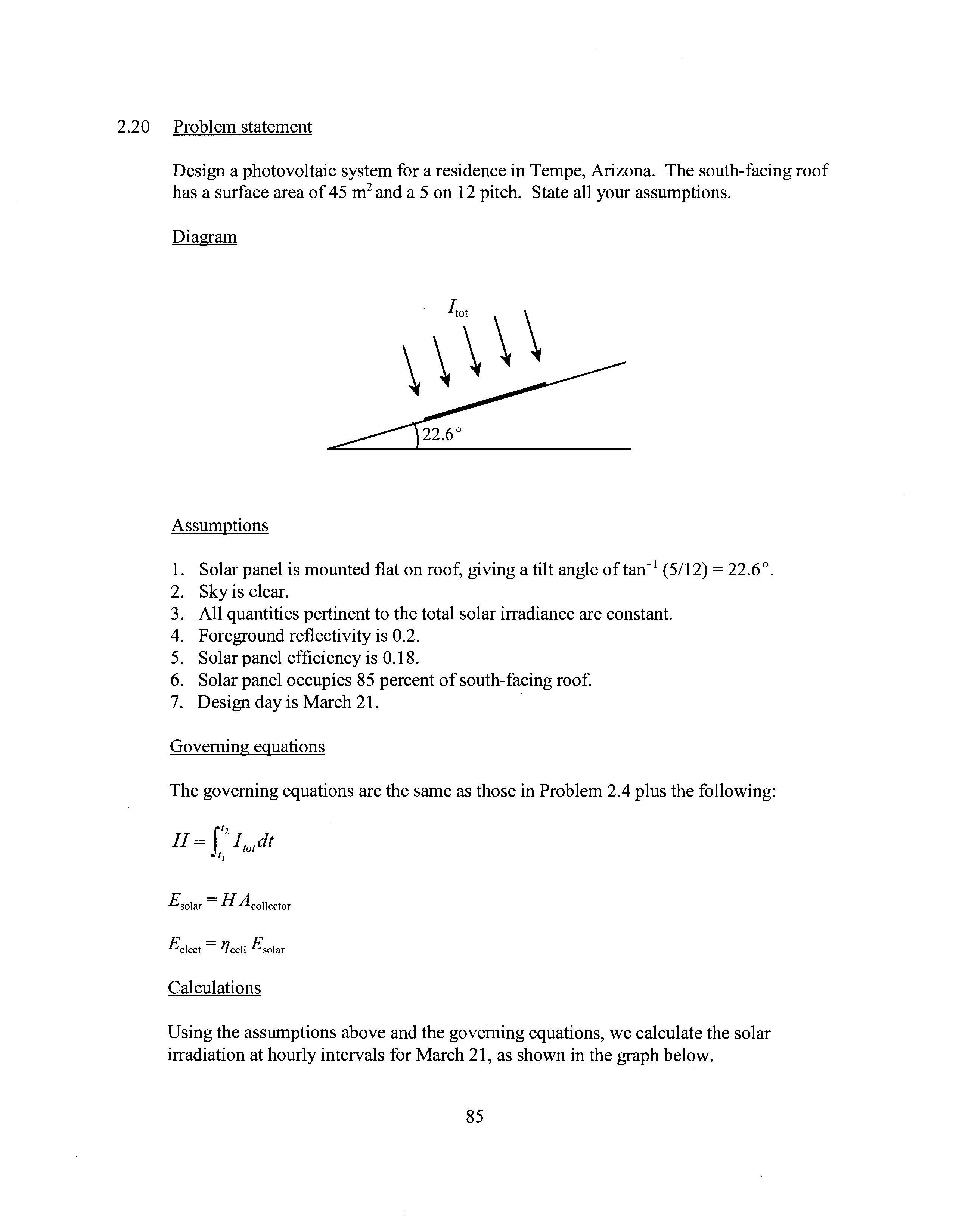
Assumptions
1. Solar panel is mounted flat on roof, giving a tilt angle of tan -I ( 5/12) = 22.6 o.
2. Sky is clear.
3. All quantities pertinent to the total solar irradiance are constant.
4. Foreground reflectivity is 0.2.
5. Solar panel efficiency is 0.18.
6. Solar panel occupies 85 percent of south-facing roof.
7. Design day is March 21.
Governing equations
The governing equations are the same as those in Problem 2.4 plus the following:
£solar = H Acollector
Eeiect = 'lcell £solar
Calculations
Using the assumptions above and the governing equations, we calculate the solar irradiation at hourly intervals for March 21, as shown in the graph below.
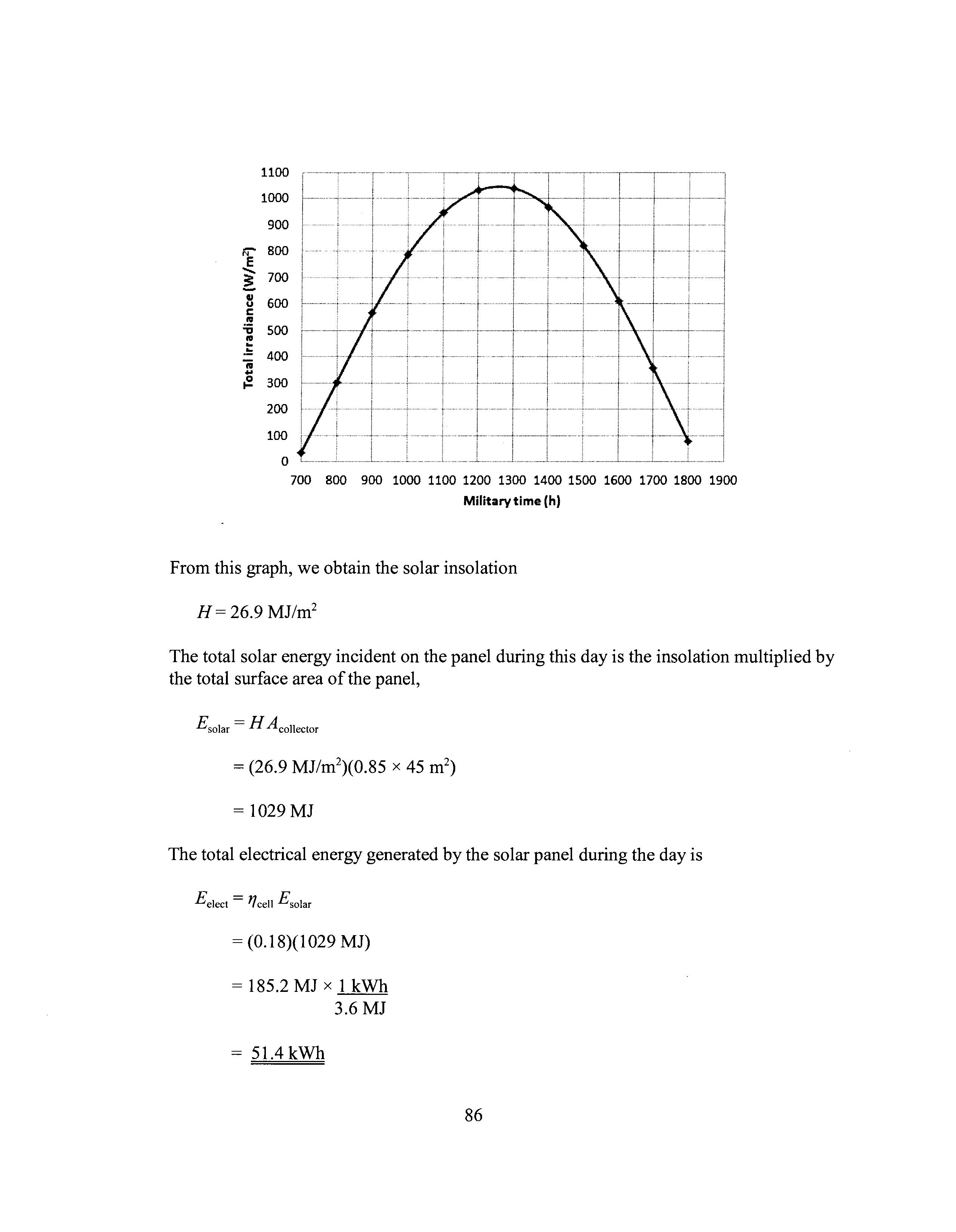
From this graph, we obtain the solar insolation
H = 26.9 MJ/m 2
The total solar energy incident on the panel during this day is the insolation multiplied by the total surface area of the panel,
£solar = H Acollector = 1029 MJ
The total electrical energy generated by the solar panel during the day is
£elect = '7cell £solar = (0.18)(1029 MJ) = 185.2 MJ X 1 kWh 3.6MJ 51.4 kWh
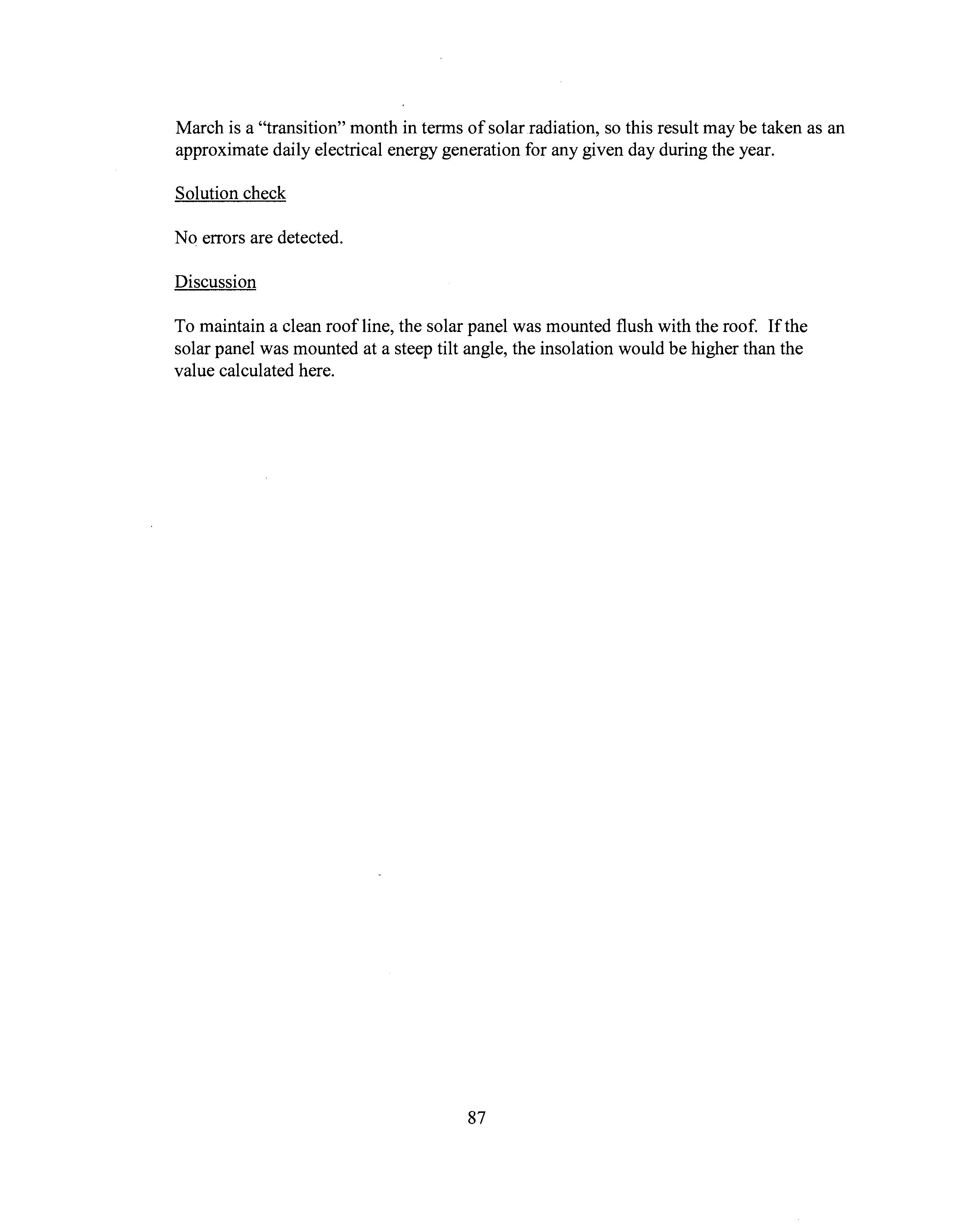
March is a "transition" month in terms of solar radiation, so this result may be taken as an approximate daily electrical energy generation for any given day during the year.
Solution check
No errors are detected.
Discussion
To maintain a clean roofline, the solar panel was mounted flush with the roof. If the solar panel was mounted at a steep tilt angle, the insolation would be higher than the value calculated here.
2.21 Problem Statement
A rover for gathering geological data on Mars has a photovoltaic solar panel that supplies electrical power to its sensors, motors, and other electrical components. The panel faces directly into the sun, measures 2.6 m x 1.2 m, and has an efficiency of 0.18. If the solar constant for Mars is 585 W/m 2 , what is the electrical power capacity of this system?
Diagram
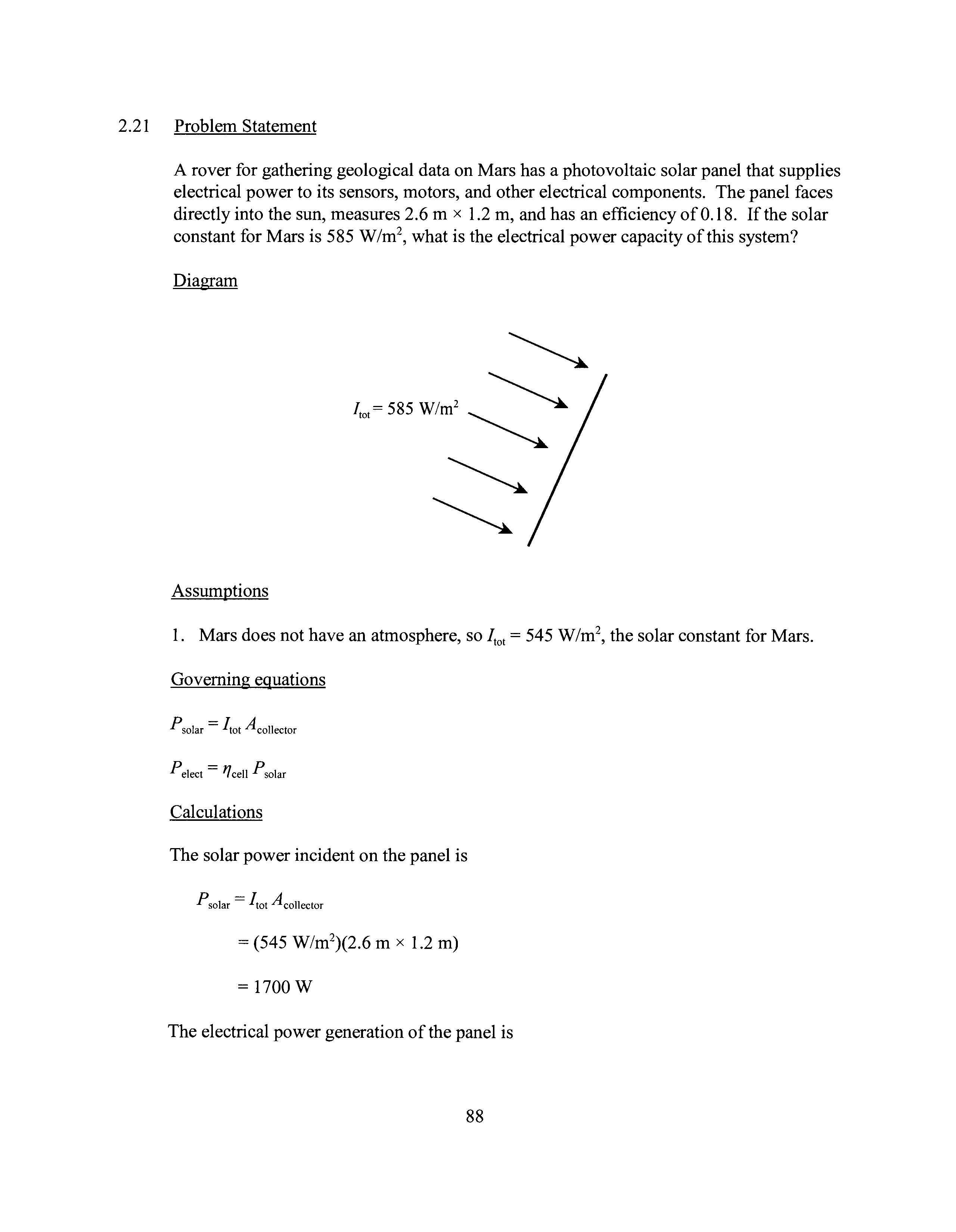
Assumptions
1. Mars does not have an atmosphere, so !tot= 545 W/m 2 , the solar constant for Mars.
Governing equations
psolar = ]tot Acollector
pelect = 1'/cell psolar
Calculations
The solar power incident on the panel is
psolar = ]tot Acollector = (545 W/m2)(2.6 m x 1.2 m)
= 1700W
The electrical power generation of the panel is 88
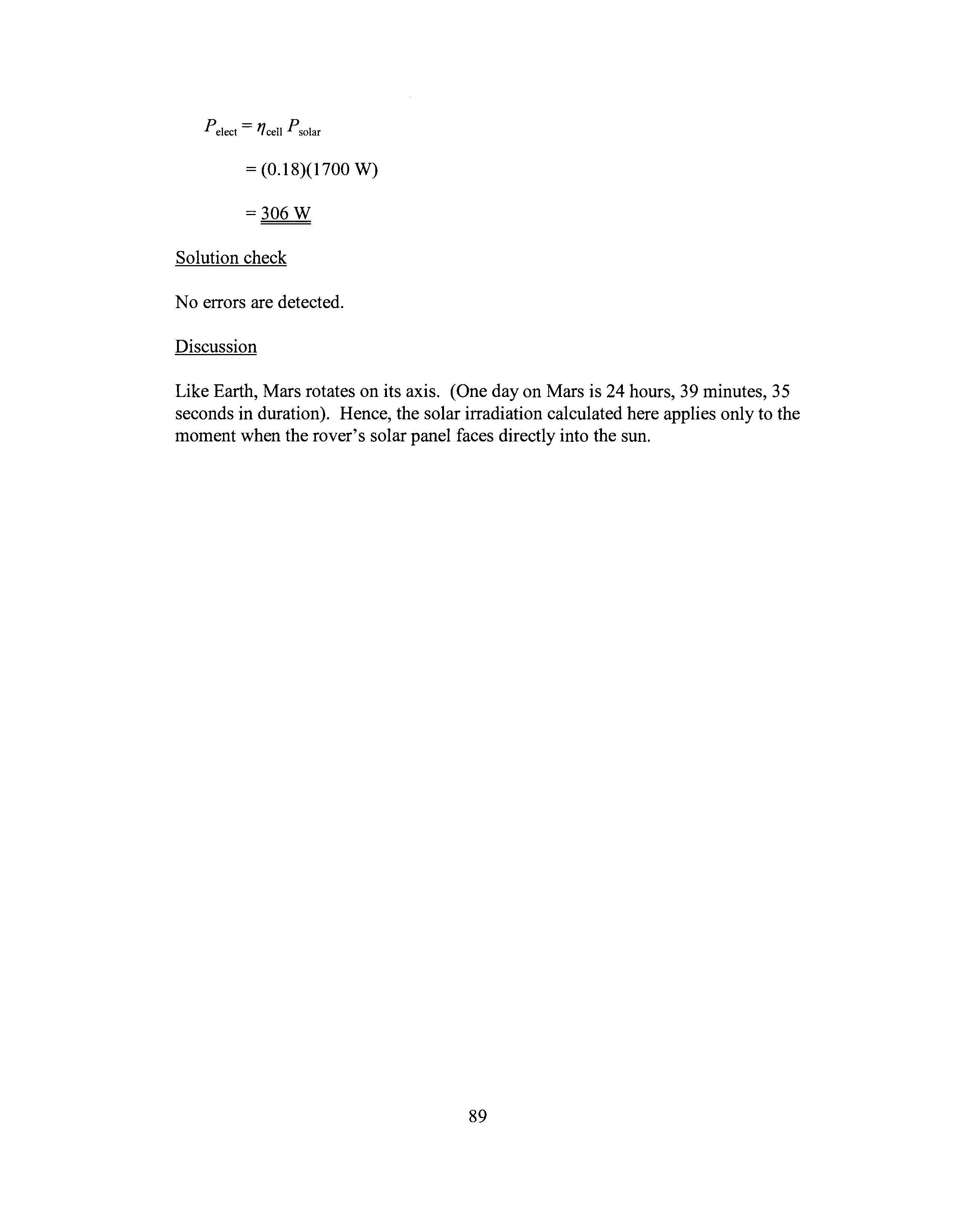
pelect = Y/cell psolar
= (0.18)(1700 W)
=306W
Solution check
No errors are detected.
Discussion
Like Earth, Mars rotates on its axis. (One day on Mars is 24 hours, 39 minutes, 35 seconds in duration). Hence, the solar irradiation calculated here applies only to the moment when the rover's solar panel faces directly into the sun.
2.22 Problem statement
In a domestic water heating system, an ethylene-glycol/water mixture flows through the collector at a mass flow rate of 0.065 kg/s. The glazing surface measures 3 m x 5 m, and 550 W/m 2 of solar power is absorbed by the fluid mixture. If the inlet temperature of the fluid mixture is 25°C, what is the outlet temperature?
Diagram
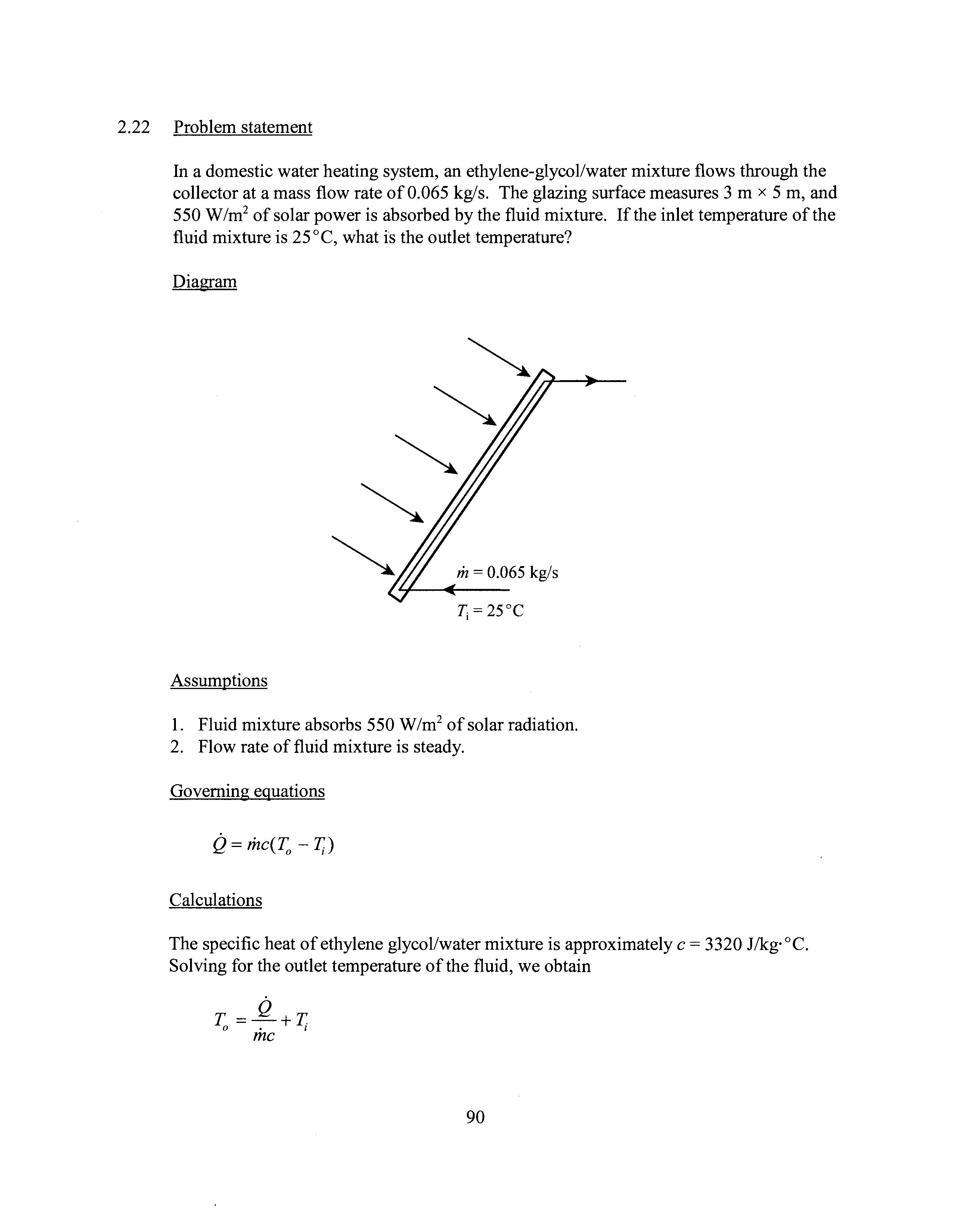
Assumptions
1. Fluid mixture absorbs 550 W/m2 of solar radiation.
2. Flow rate of fluid mixture is steady.
Governing equations
Q=me( I;, -I;)
Calculations
The specific heat of ethylene glycol/water mixture is approximately c = 3320 J/kg· °C. Solving for the outlet temperature of the fluid, we obtain
T =2_+T 0 • me
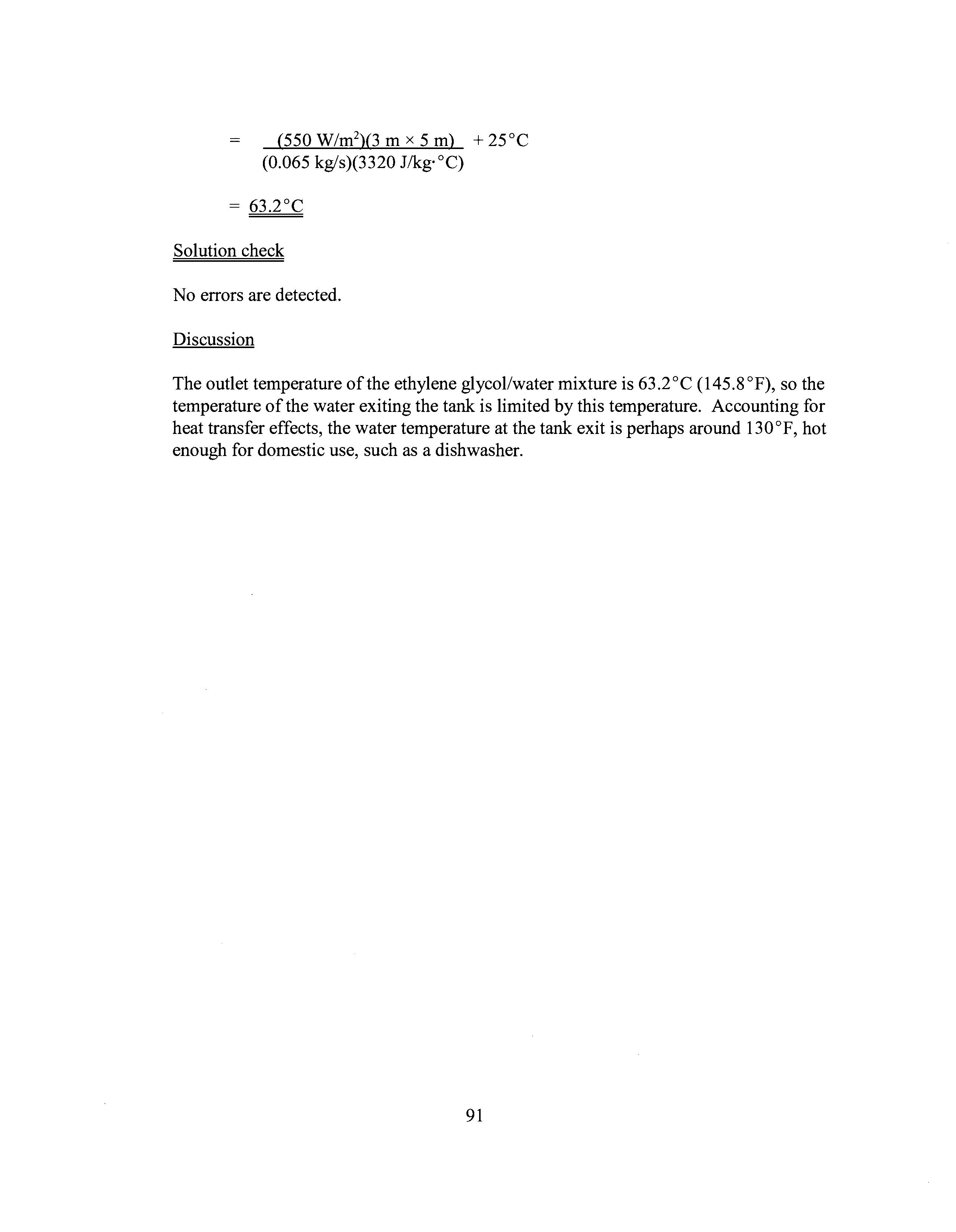
(550 W/m 2)(3 m x 5 m) + 25°C (0.065 kg/s)(3320 J/kg·°C)
63.2°C
Solution check
No errors are detected.
Discussion
The outlet temperature of the ethylene glycol/water mixture is 63.2°C (145.8°F), so the temperature of the water exiting the tank is limited by this temperature. Accounting for heat transfer effects, the water temperature at the tank exit is perhaps around 130°F, hot enough for domestic use, such as a dishwasher.
2.23 Problem statement
A domestic water heating system in Los Angeles, California, incorporates a roof-mounted flat plate solar collector with a tilt angle of 60 o. The collector faces south-southeast, and the glazing surface measures 4.0 m x 6.2 m. the working fluid, which has a specific heat of c = 3150 Jlkg·°C, enters the collector at a temperature of21 oc and flows through the collector at a mass flow rate of 0.10 kg/s. If 50 percent of the total solar irradiance is absorbed by the working fluid, find the temperature of the working fluid at the outlet of the collector at 12:00 noon on April21.
Diagram
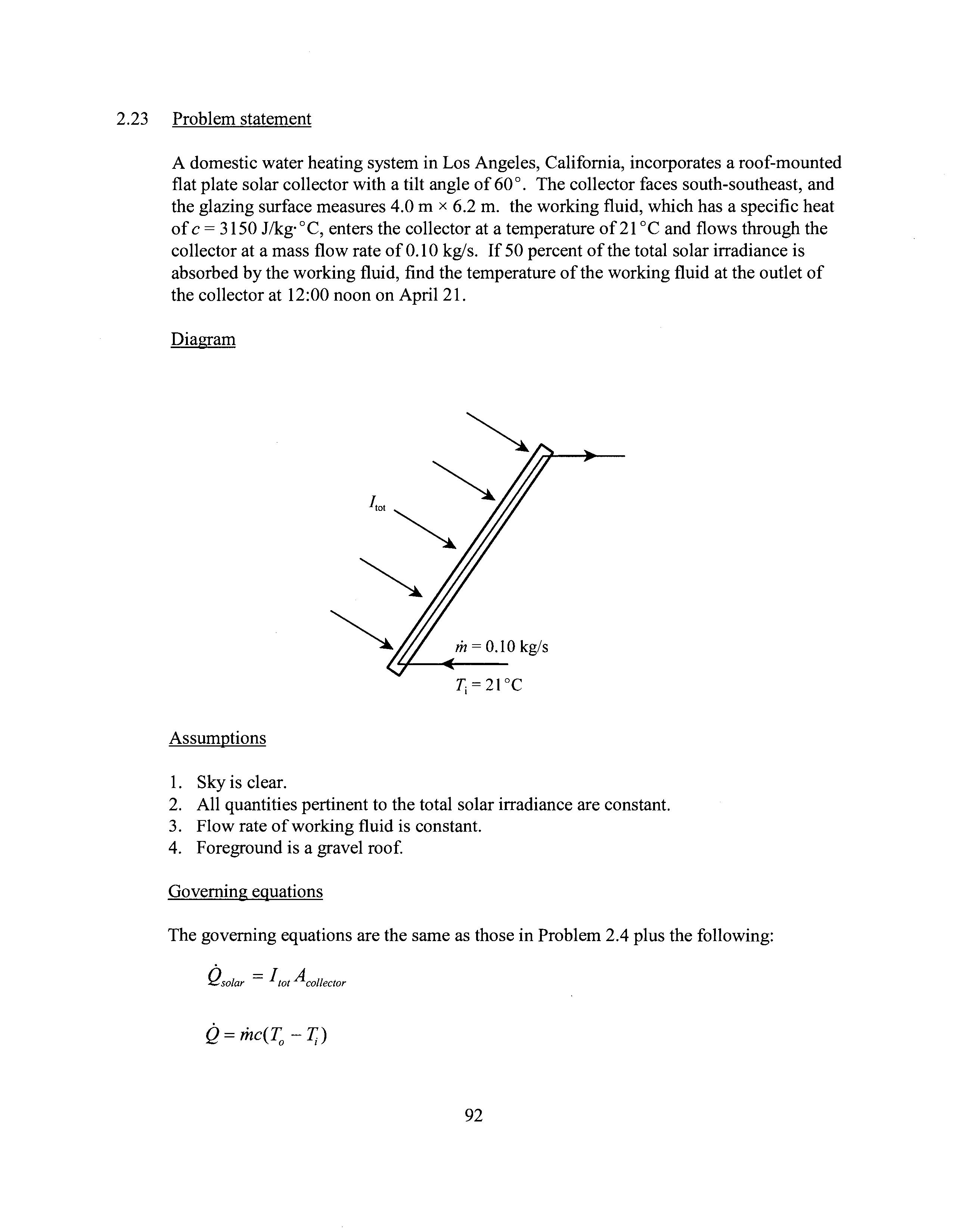
Assumptions
1. Sky is clear.
2. All quantities pertinent to the total solar irradiance are constant.
3. Flow rate ofworking fluid is constant.
4. Foreground is a gravel roof.
Governing equations
The governing equations are the same as those in Problem 2.4 plus the following:
Qso/ar = ]tot A collector
Using the computational procedure illustrated in Problem 2.4, the total solar irradiation is
]tot= 810 W/m2
Thus, the solar radiation incident on the collector is
Qso/ar = ]tot Acol/ector = (810 W/m 2)(4.0 m x 6.2 m)
Only 50 percent of this radiation is absorbed by the working fluid, so we have
0.50 X 2.01 X 104 W + 21 °C (0.10 kg/s)(3150 J/kg·°C)
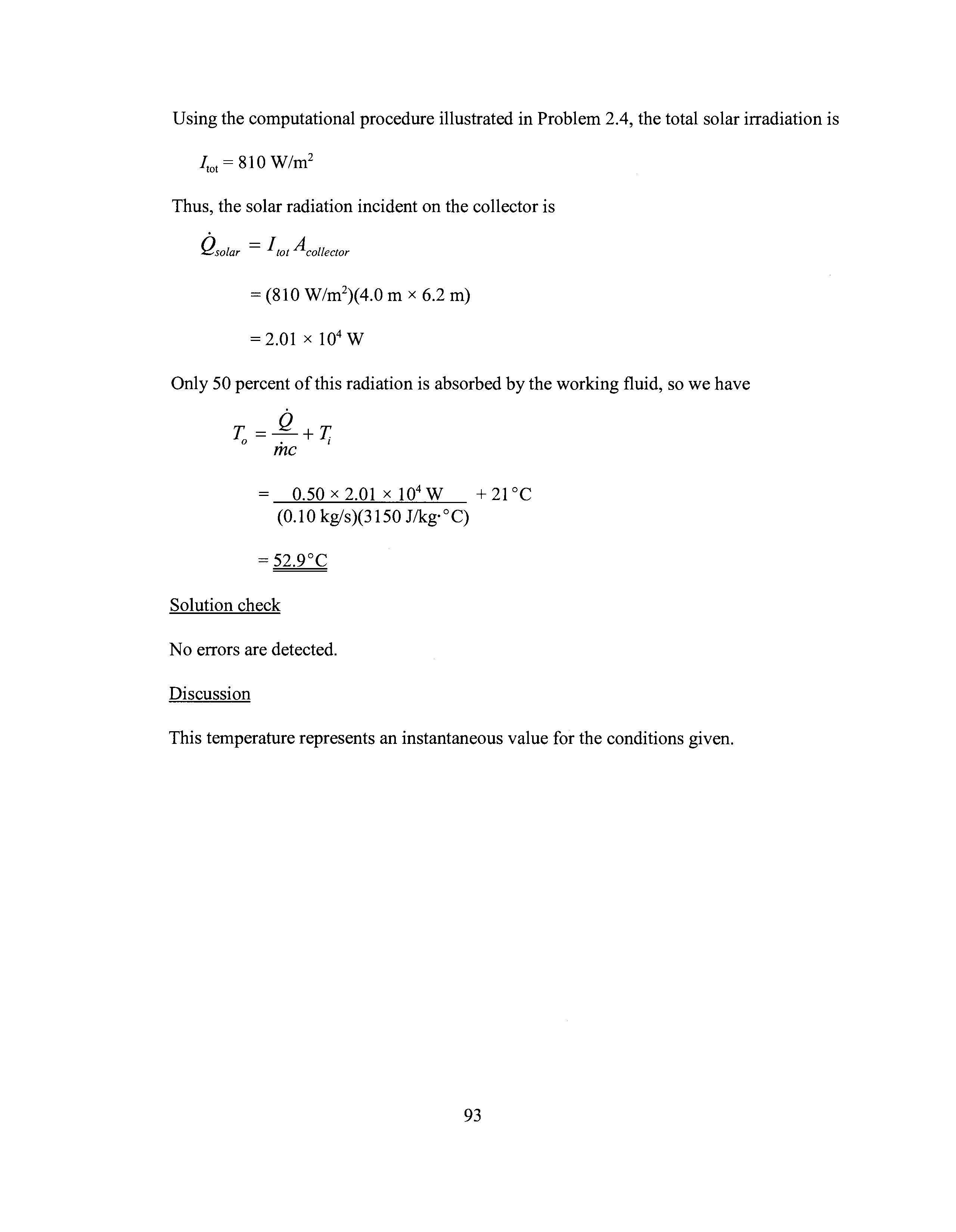
Solution check
No errors are detected.
Discussion
This temperature represents an instantaneous value for the conditions given.
2.24 Problem statement
The direct solar irradiance on a dish concentrator is 600 W/m 2 , and the dish aperture diameter is 1.80 m. The concentration ratio is 2500, the temperature of the working fluid in the receiver is 950°C, and the temperature of the surroundings is 25°C. Find the solar power incident on the concentrator, the heat flux at the receiver, and the Camot efficiency.
Diagram
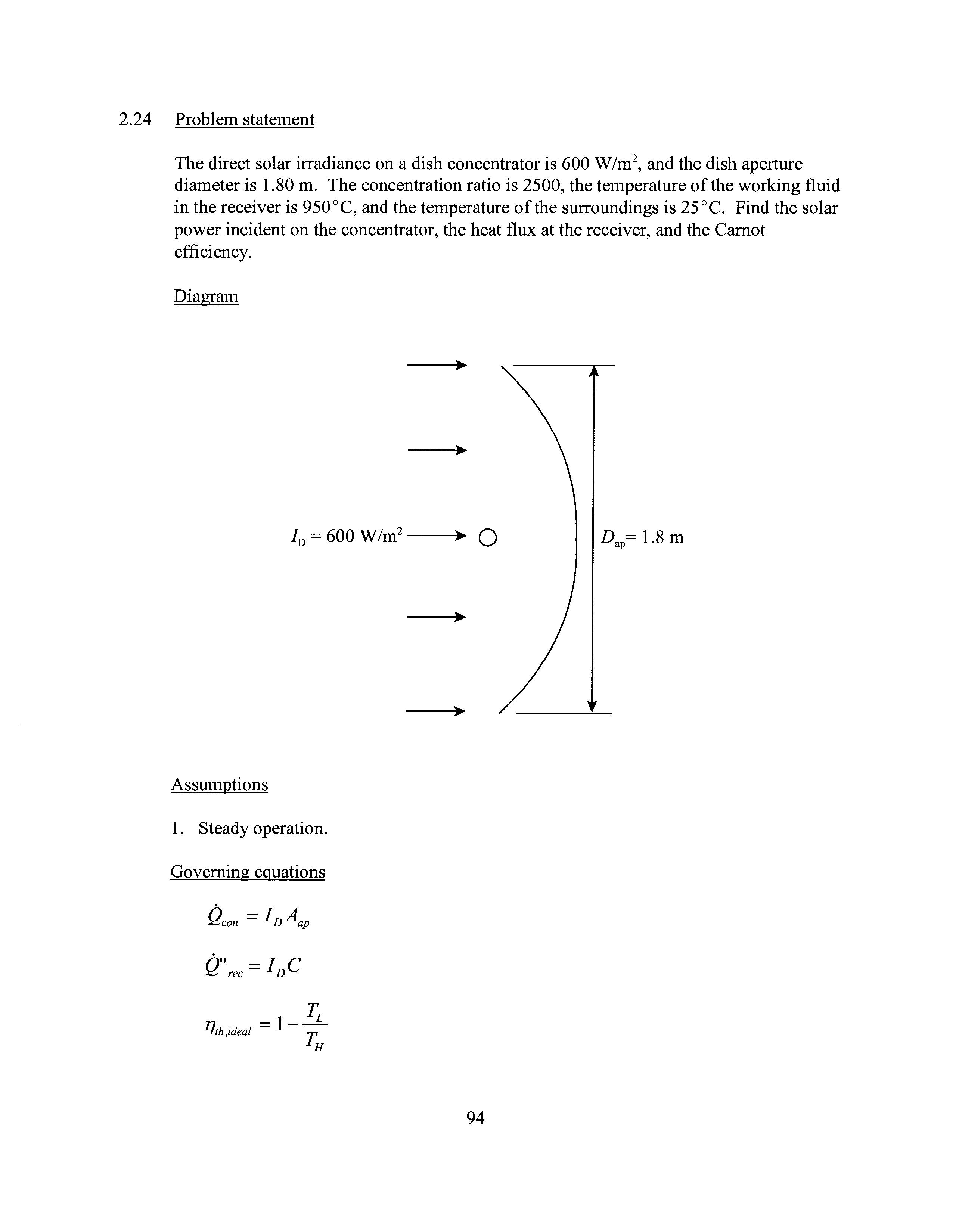
Assumptions
1. Steady operation.
Governing equations
2.25 Problem statement
Consider a CSP plant with an array of 400 dish concentrators in Santa Fe, New Mexico. The concentrators, which have an aperture diameter of2.75 m, are installed in a gravel field and have dual axis tracking. For 12:00 noon on January 21, find the total solar power incident on the concentrators and the heat flux at the receivers if the concentration ratio is 3200.
Diagram
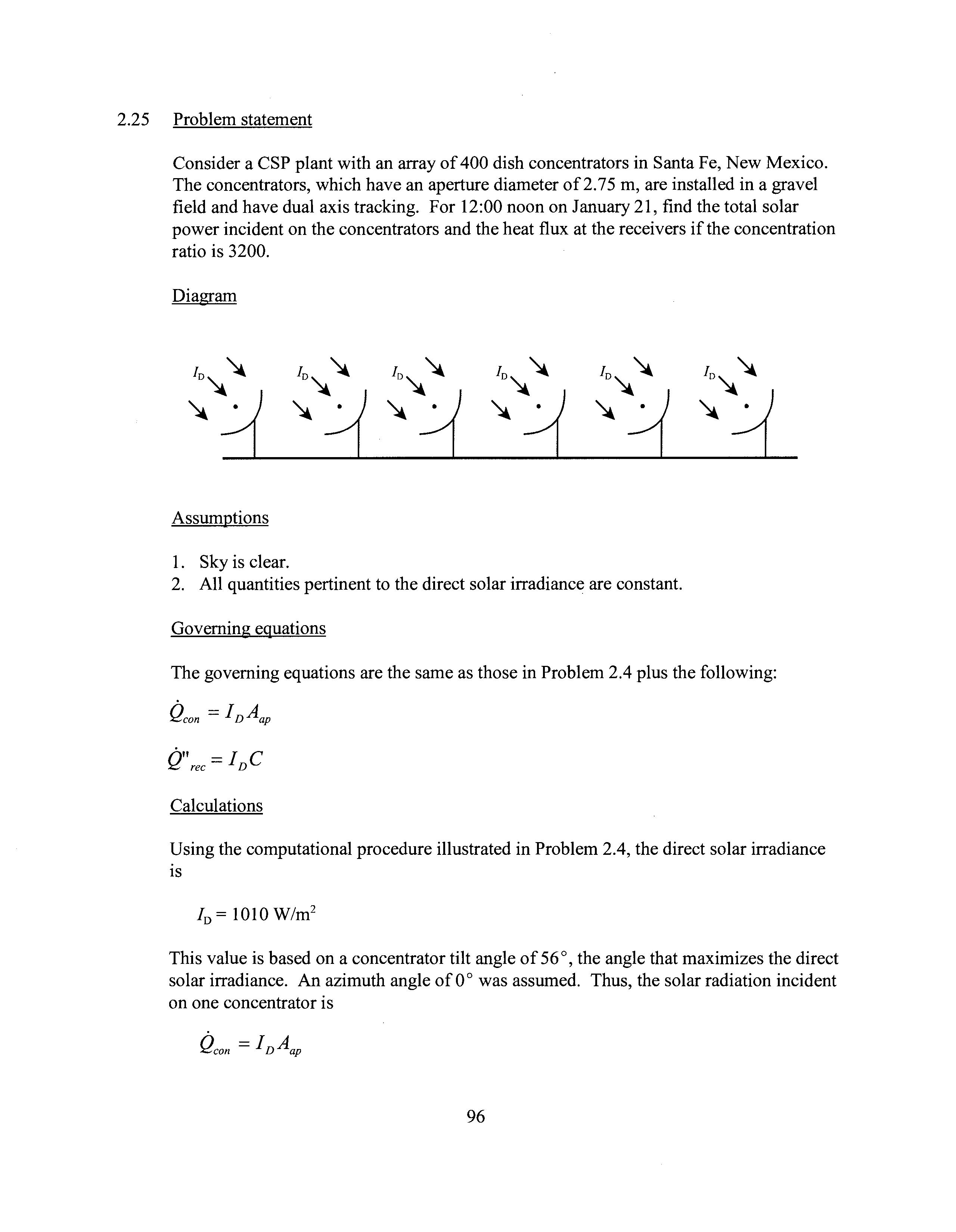
Assumptions
1. Sky is clear.
2. All quantities pertinent to the direct solar irradiance are constant.
Governing equations
The governing equations are the same as those in Problem 2.4 plus the following:
Q"rec = JDC
Calculations
Using the computational procedure illustrated in Problem 2.4, the direct solar irradiance lS This value is based on a concentrator tilt angle of 56 o, the angle that maximizes the direct solar irradiance. An azimuth angle of 0 o was assumed. Thus, the solar radiation incident on one concentrator is
= 5999 w
so the total solar radiation incident on all concentrators is (400)(5999 W) = 2.40 X 106 w = 2.40 MW
The heat flux at the receivers is Q"rec =/DC = (1010 W/m2)(3200)
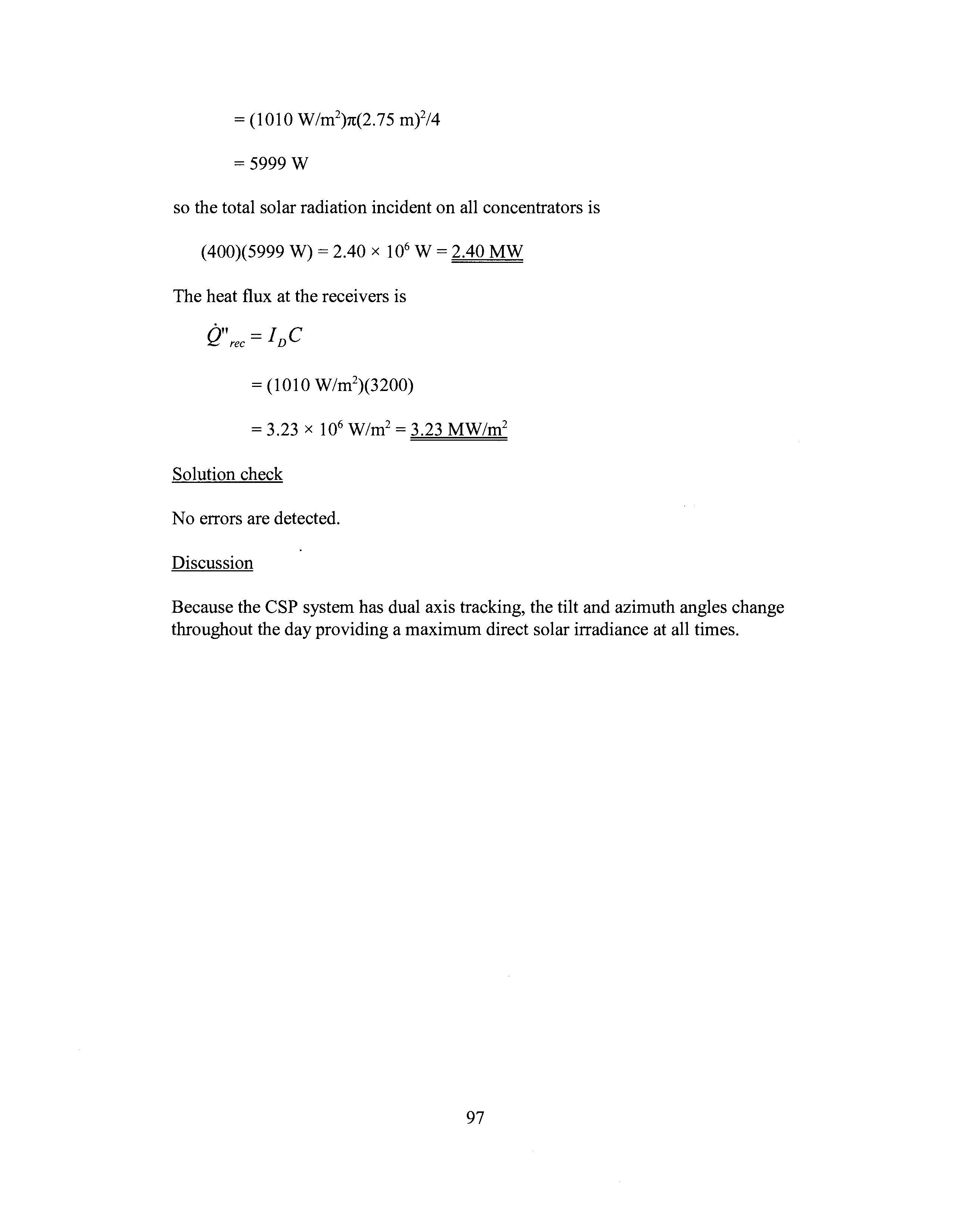
Solution check
No errors are detected.
Discussion
Because the CSP system has dual axis tracking, the tilt and azimuth angles change throughout the day providing a maximum direct solar irradiance at all times.
2.26 Problem statement
What is the maximum possible thermal efficiency of a concentrating solar power plant if the temperature of the working fluid at the receiver is 1400oC and the ambient air temperature is 20°C?
Diagram
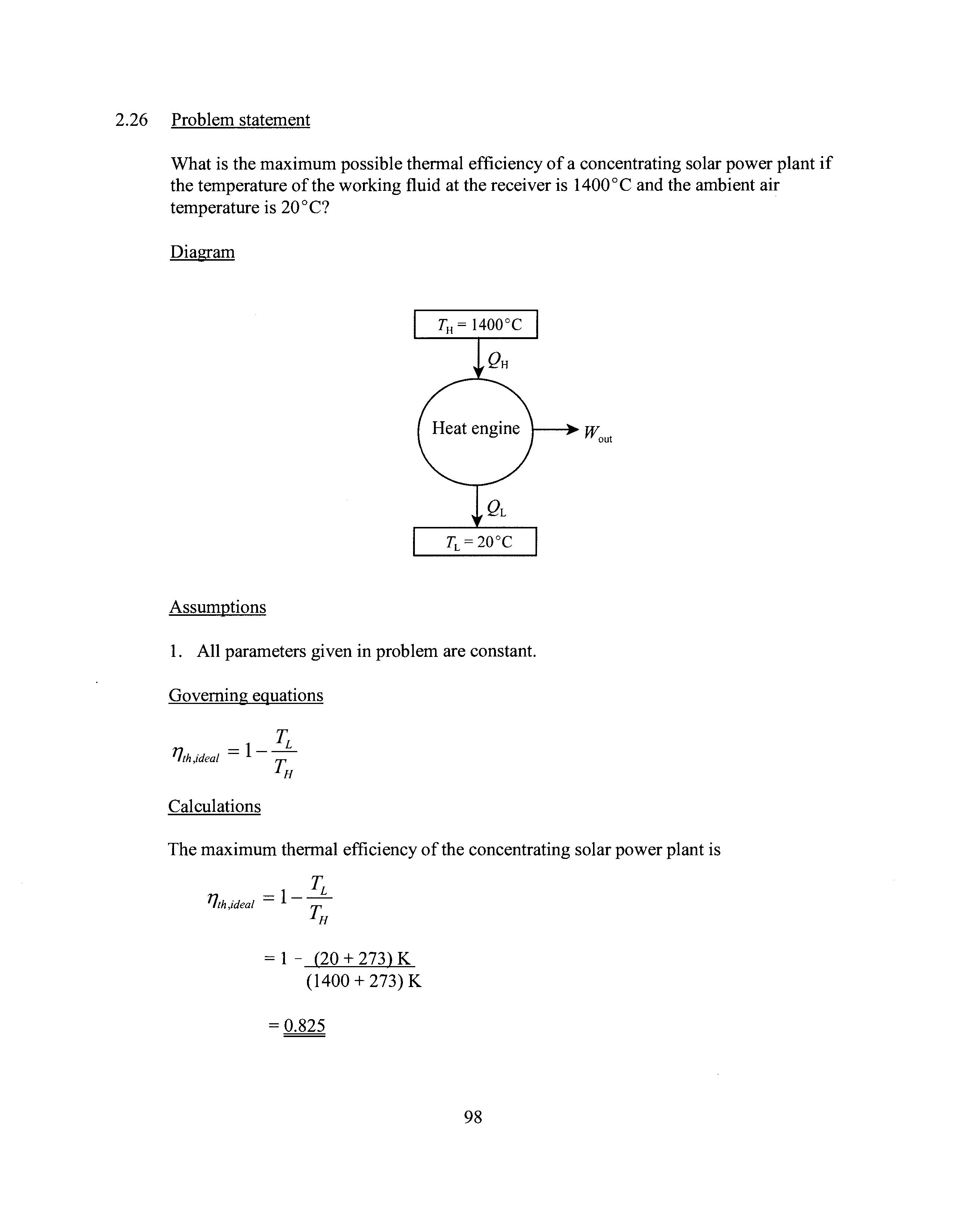
Assumptions
1. All parameters given in problem are constant.
Governing equations TL 'lth ,ideal = 1 - T, H
Calculations
The maximum thermal efficiency of the concentrating solar power plant is
'lth ,ideal = 1- T, H = 1- (20+273)K (1400 + 273) K = 0.825
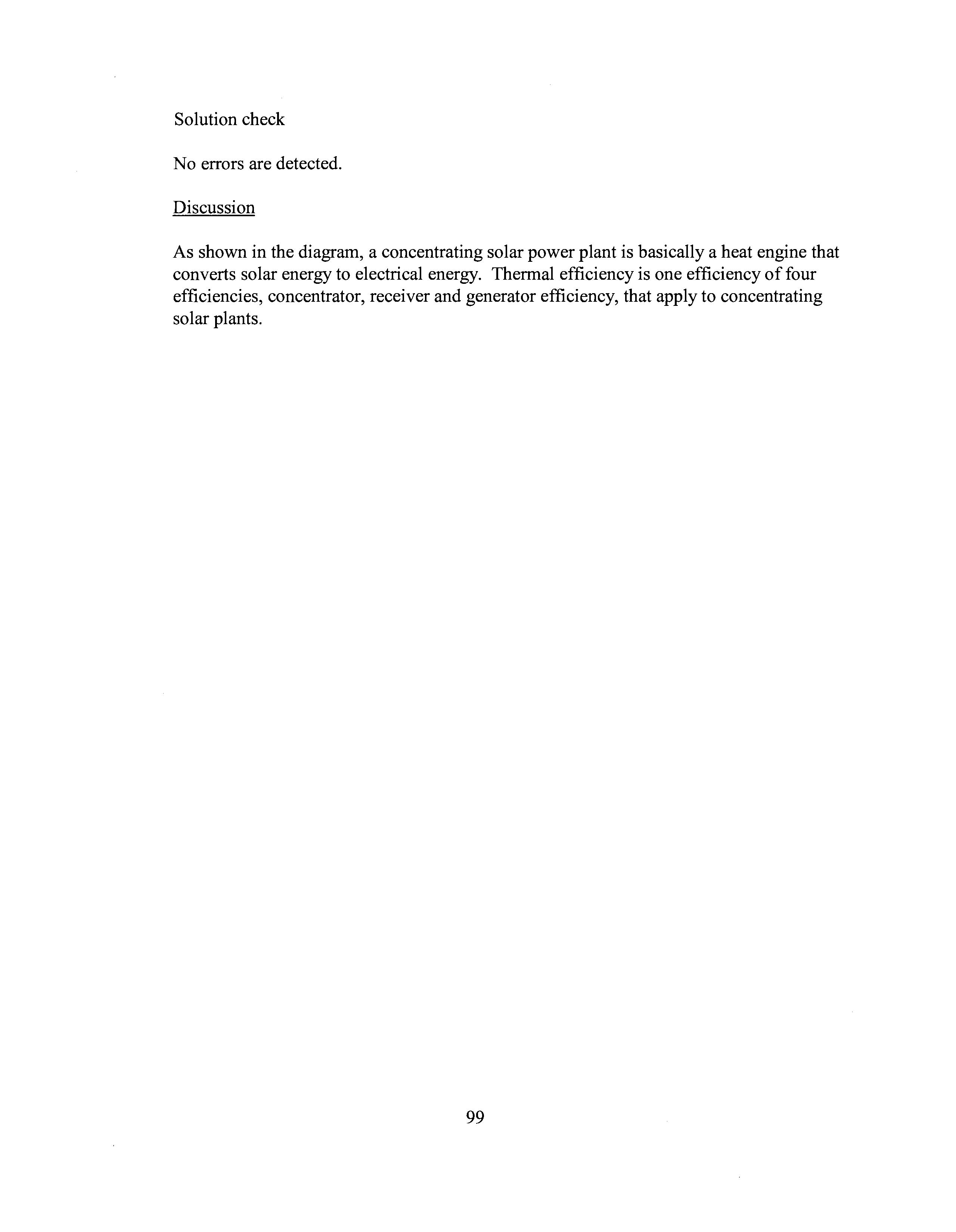
Solution check
No errors are detected.
Discussion
As shown in the diagram, a concentrating solar power plant is basically a heat engine that converts solar energy to electrical energy. Thermal efficiency is one efficiency of four efficiencies, concentrator, receiver and generator efficiency, that apply to concentrating solar plants.
2.27 Problem statement
Consider a parabolic trough concentrator with an aperture width and length of 1.4 m and 26 m, respectively. During a given day, the average direct solar irradiance on the concentrator is 650 W/m2 • The efficiencies of the concentrator, receiver, and electrical generator are 0.91, 0.83, and 0.95, respectively. Ifthe temperature ofthe working fluid in the receiver is 600°C, find the maximum possible electrical output power. The temperature of the surroundings is 10°C.
Diagram
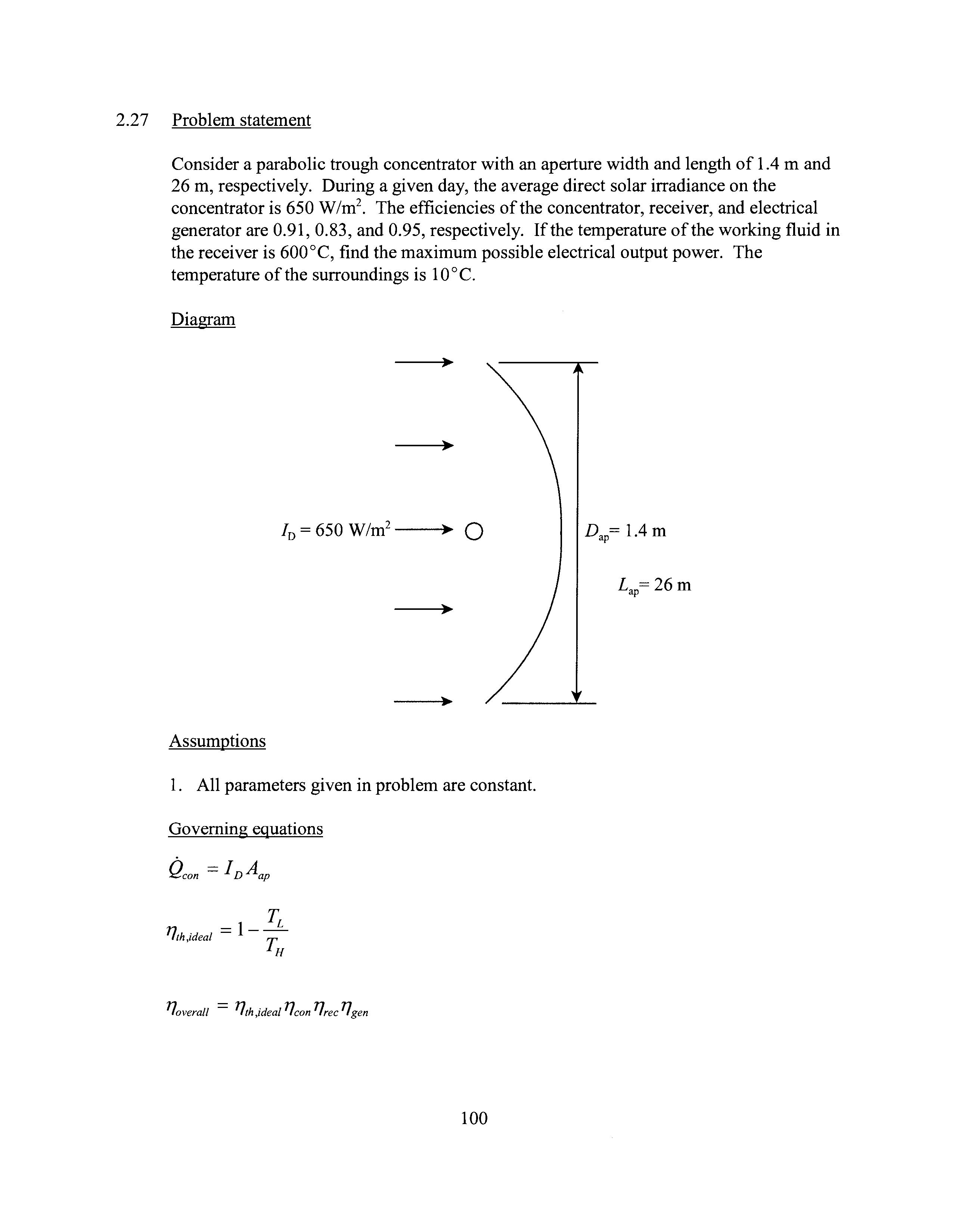
10 = 650 W/m 2 --•• 0
Lap= 26m
Assumptions
1. All parameters given in problem are constant.
Governing equations
lJth ,ideal = 1 - T, H
lJoverall = lJth,ideailJcon lJrec lJgen
= 'loverall Qeon
Calculations
The solar power incident on the concentrator is = (650 W/m2)(1.4 m)(26 m)
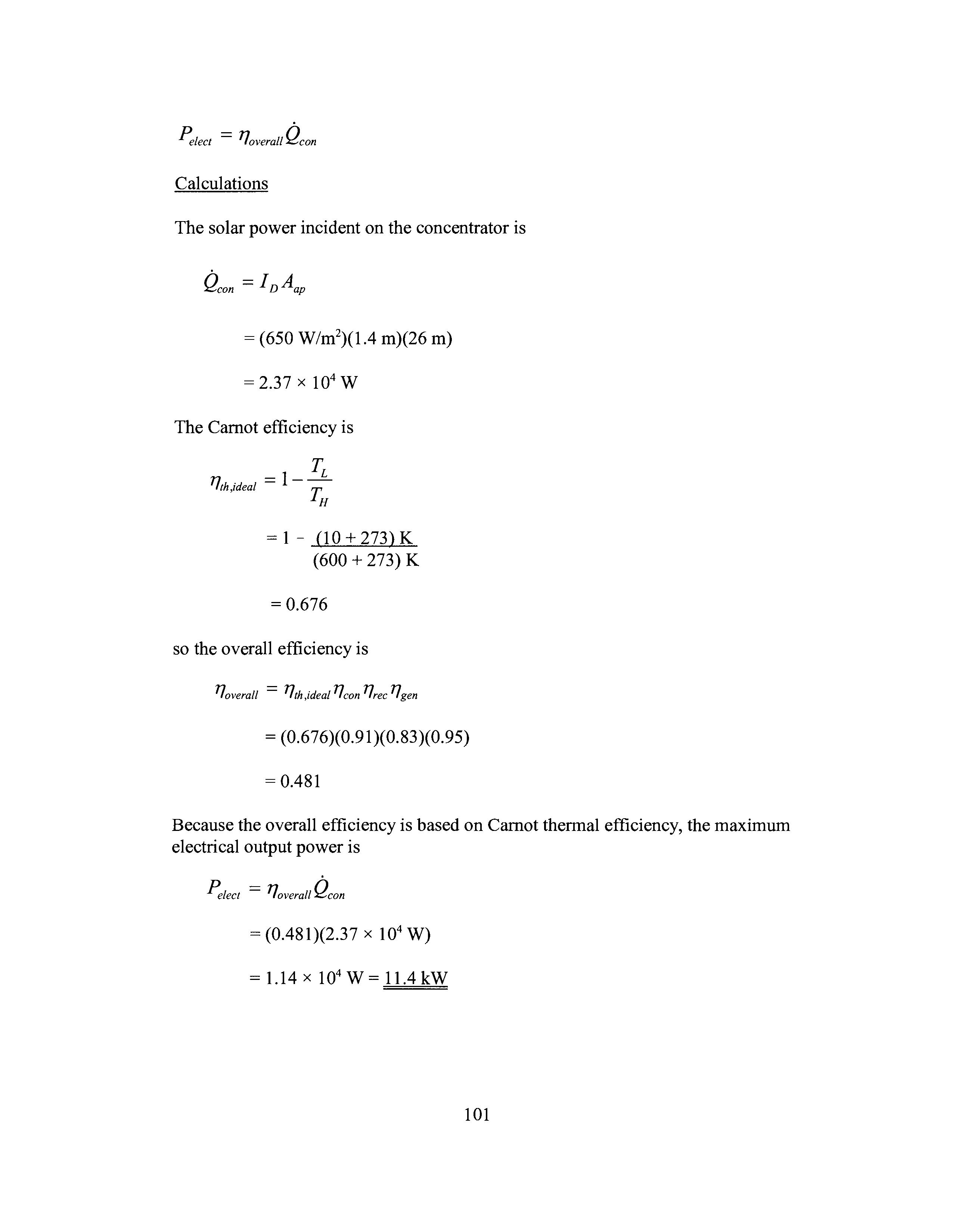
The Camot efficiency is TL 'lth,ideaf = 1- T H = 1- (10+273)K (600 + 273) K = 0.676
so the overall efficiency is lloverall = 1lth,ideaf17eon llrec 'lgen = (0.676)(0.91)(0.83)(0.95) = 0.481
Because the overall efficiency is based on Camot thermal efficiency, the maximum electrical output power is = 'loverall Qeon = (0.481)(2.37 X 104 W) = 1.14 X 104 w = 11.4 kW
2.28 Problem statement
A concentrating solar power plant is being designed to augment electrical power from the main grid to a small residential community. The plant is to consist of an array of parabolic dish concentrators with an aperture diameter of2.2 m. The efficiencies of the system are estimated to be:
11th = 0.30, llcon = 0.90, llrec = 0.82, llgen = 0.95
As a starting point in the design, an engineer uses 800 W1m2 as a direct solar irradiance averaged over a 12-hour period during which the sun shines on a typical day. The average electrical power consumption of a home in the United States is approximately 30 kWh per day. If the community has 1200 homes, how many dish concentrators are required to provide 25 percent of the power? Also, estimate the amount of land required for the concentrators.
Diagram
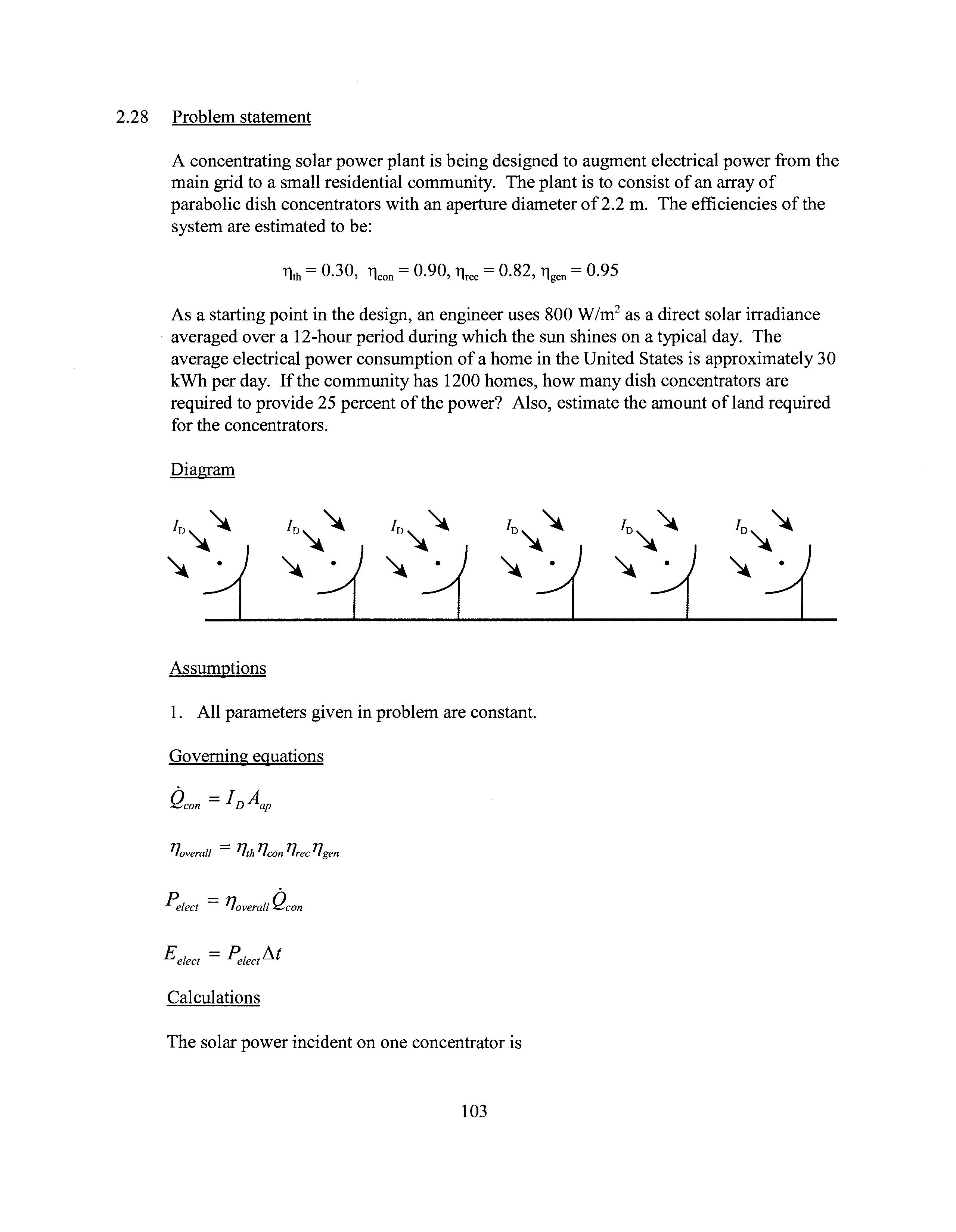
Assumptions
1. All parameters given in problem are constant.
Governing equations = 1lovera/l Qcon
E elect = 1'1t
Calculations
The solar power incident on one concentrator is
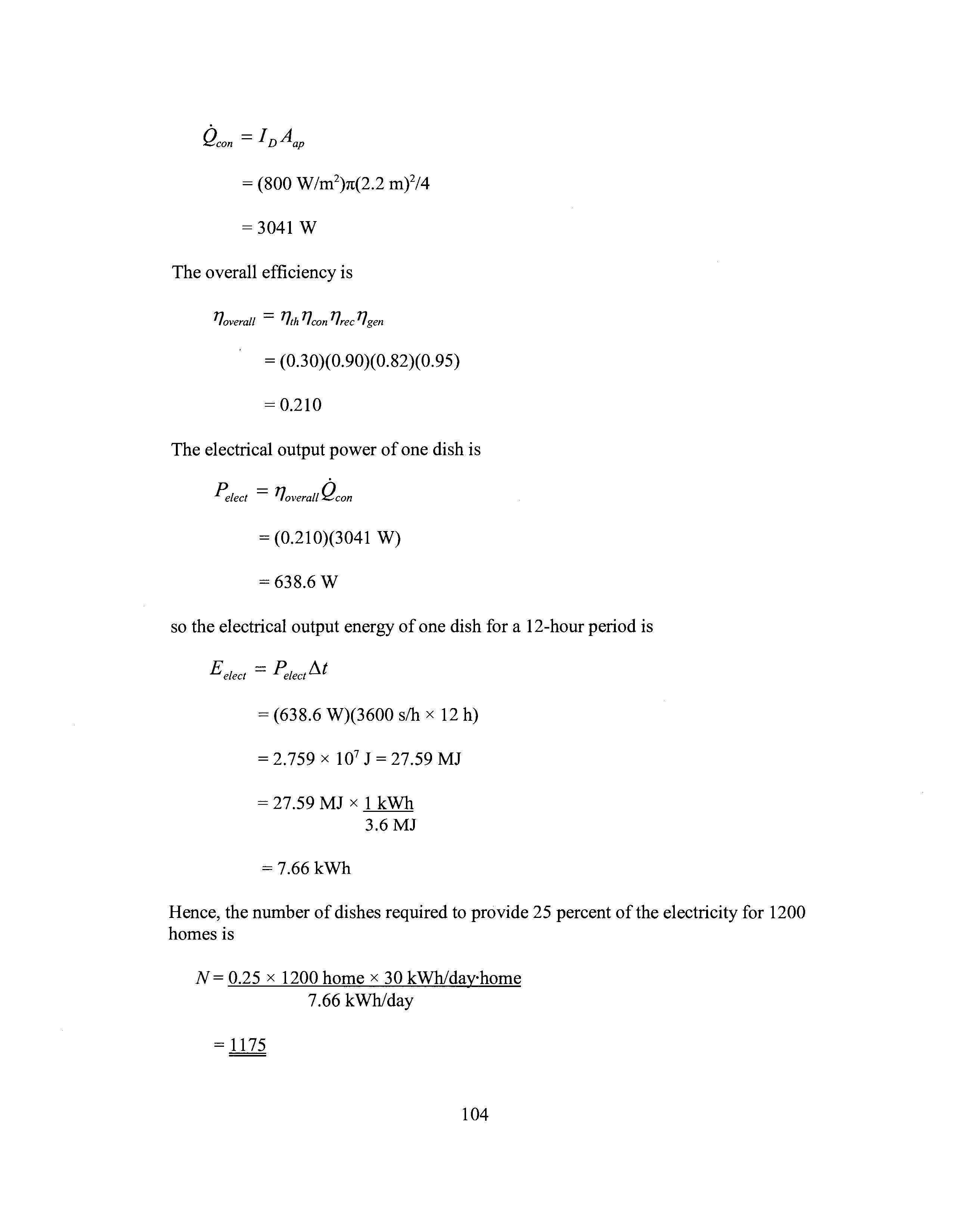
= 3041 w
The overall efficiency is
TJovera/1 = 17th TJcon TJrec TJgen
= (0.30)(0.90)(0.82)(0.95) = 0.210
The electrical output power of one dish is = TJoverall Qcon
= (0.210)(3041 W) = 638.6 w
so the electrical output energy of one dish for a 12-hour period is
E elect = /'1!
= (638.6 W)(3600 slh x 12 h)
= 2.759 X 107 J = 27.59 MJ
= 27.59 MJ X 1 kWh 3.6MJ
=7.66kWh
Hence, the number of dishes required to provide 25 percent ofthe electricity for 1200 homes is
N = 0.25 x 1200 home x 30 kWh/day-home 7.66 kWh/day = 1175
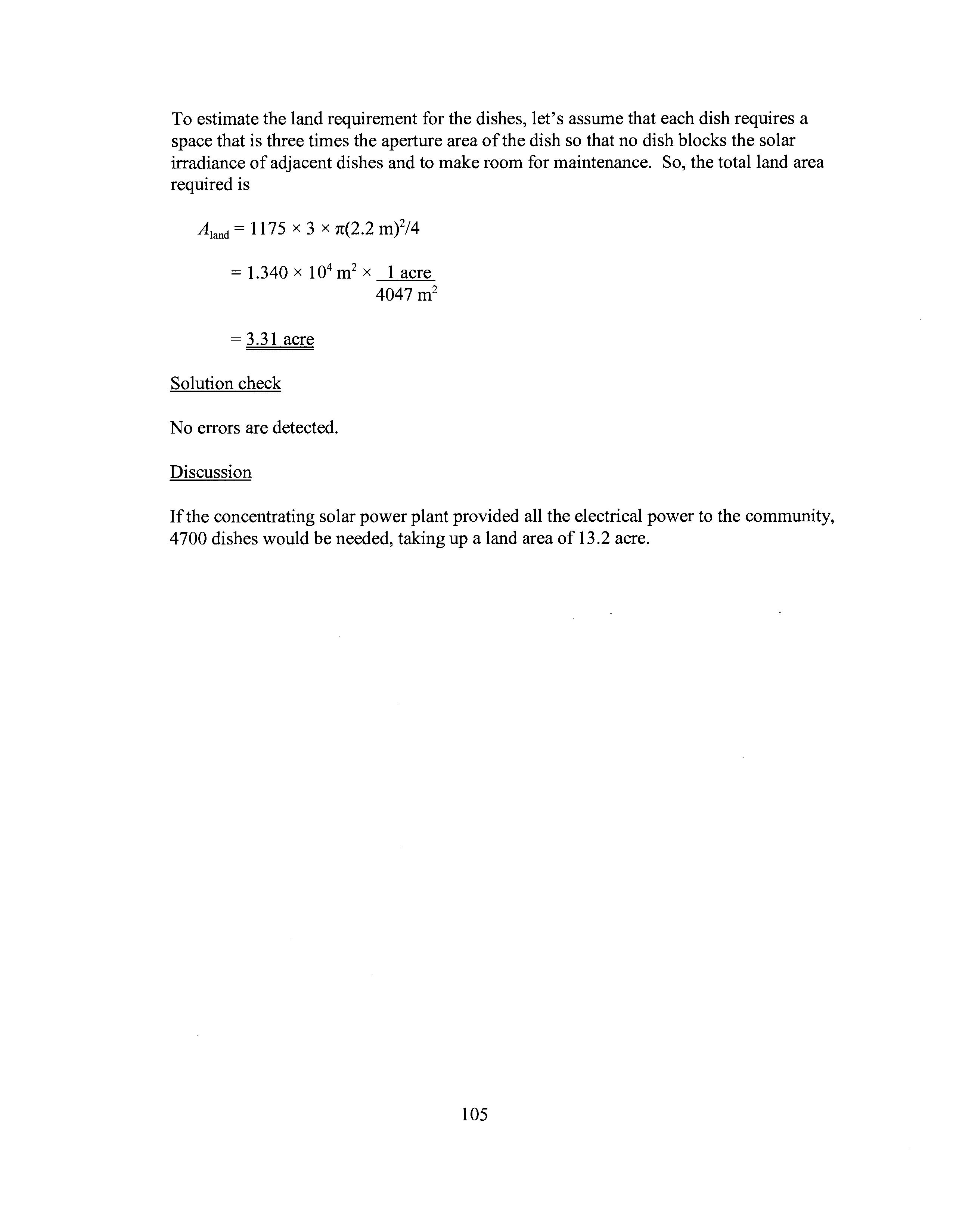
To estimate the land requirement for the dishes, let's assume that each dish requires a space that is three times the aperture area of the dish so that no dish blocks the solar irradiance of adjacent dishes and to make room for maintenance. So, the total land area required is
Aland= 1175 X 3 X 1t(2.2 m) 2/4
= 1.340 x 104 m 2 x 1 acre
4047 m 2
= 3.31 acre
Solution check
No errors are detected.
Discussion
If the concentrating solar power plant provided all the electrical power to the community, 4700 dishes would be needed, taking up a land area of 13.2 acre.
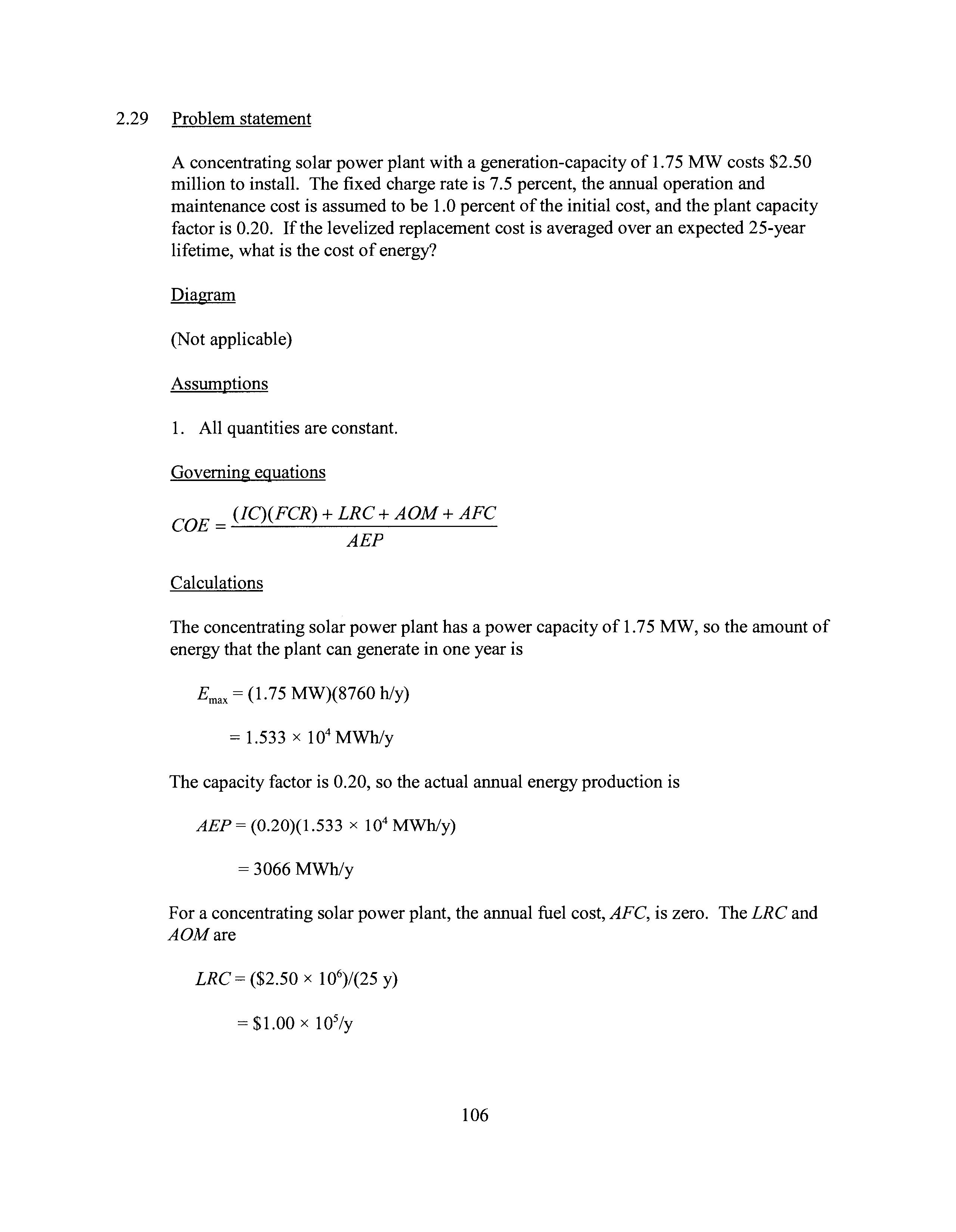
2.29 Problem statement
A concentrating solar power plant with a generation-capacity of 1. 75 MW costs $2.50 million to install. The fixed charge rate is 7.5 percent, the annual operation and maintenance cost is assumed to be 1.0 percent ofthe initial cost, and the plant capacity factor is 0.20. If the levelized replacement cost is averaged over an expected 25-year lifetime, what is the cost of energy?
Diagram (Not applicable)
Assumptions
1. All quantities are constant.
Governing equations
COE = (IC)(FCR) + LRC + AOM + AFC AEP
Calculations
The concentrating solar power plant has a power capacity of 1.75 MW, so the amount of energy that the plant can generate in one year is
Emax = (1.75 MW)(8760 h/y) = 1.533 X 104 MWhly
The capacity factor is 0.20, so the actual annual energy production is
AEP = (0.20)(1.533 X 104 MWhly) = 3066 MWhly
For a concentrating solar power plant, the annual fuel cost, AFC, is zero. The LRC and AOMare
LRC = ($2.50 X 106)/(25 y) = $1.00 X 105/y
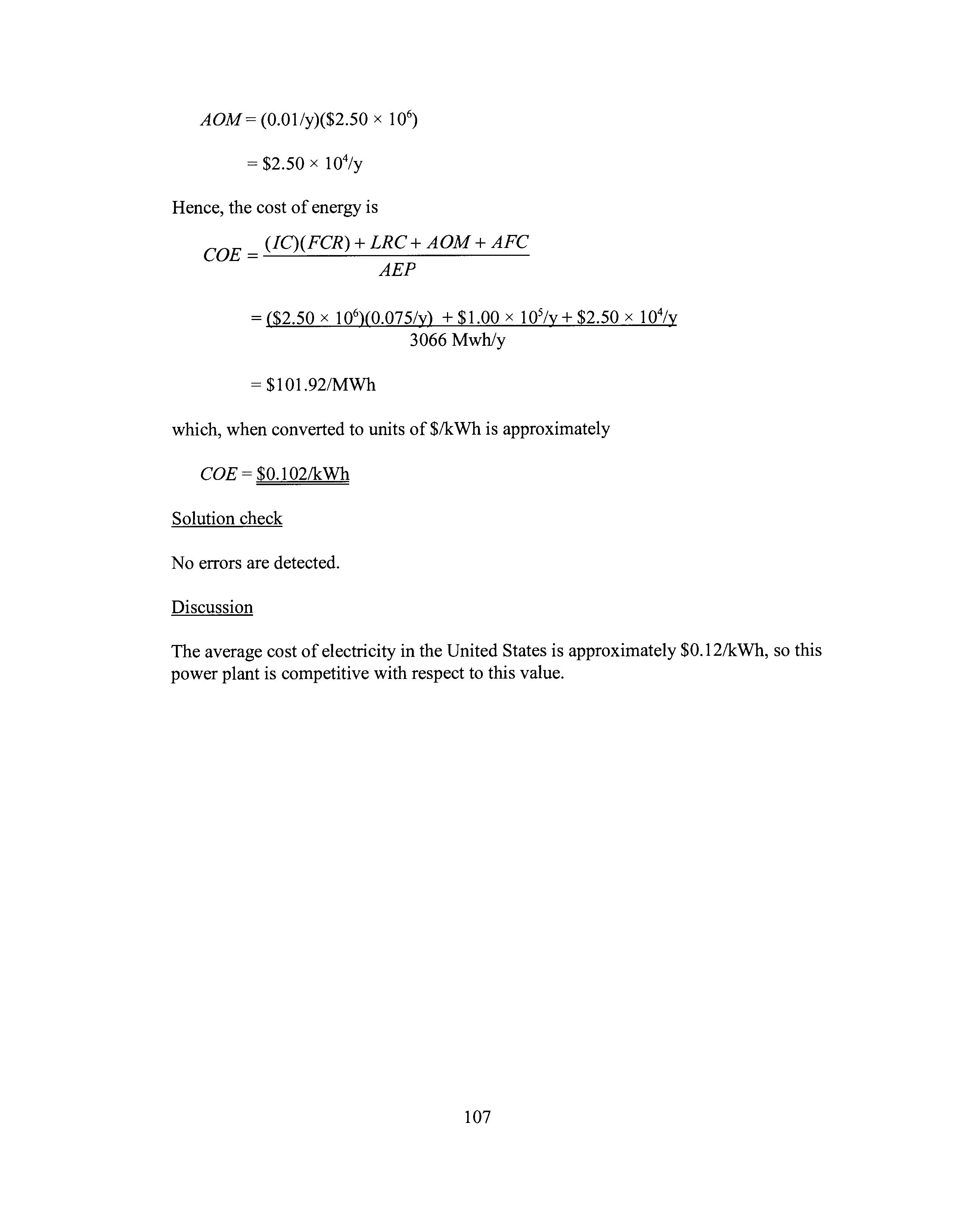
AOM = (0.01/y)($2.50 X 10 6 ) = $2.50 X 104/y
Hence, the cost of energy is
COE = (IC)(FCR) + LRC + AOM + AFC AEP = ($2.50 X 106)(0.075/y) + $1.00 X 105/y+ $2.50 X 104 /y 3066 Mwhly = $101.92/MWh
which, when converted to units of $/kWh is approximately
COE = $0.1 02/kWh
Solution check
No errors are detected.
Discussion
The average cost of electricity in the United States is approximately $0.12/kWh, so this power plant is competitive with respect to this value.
